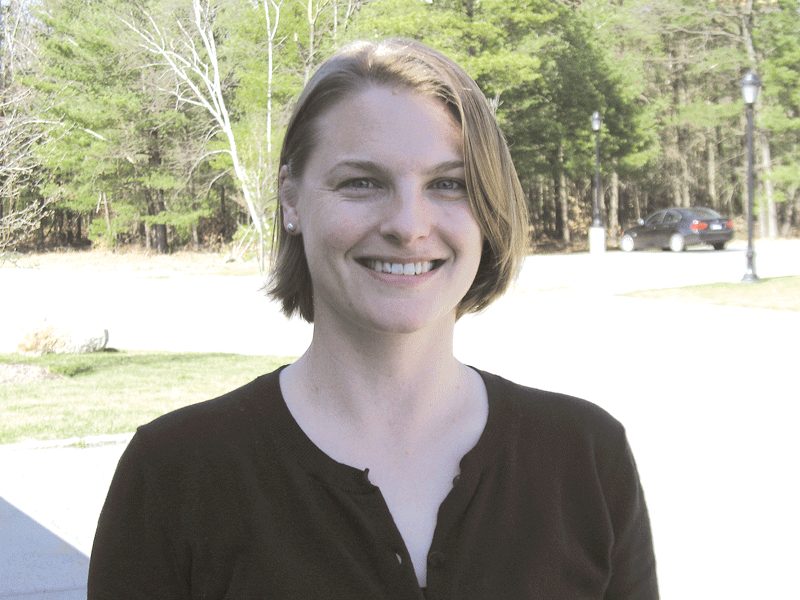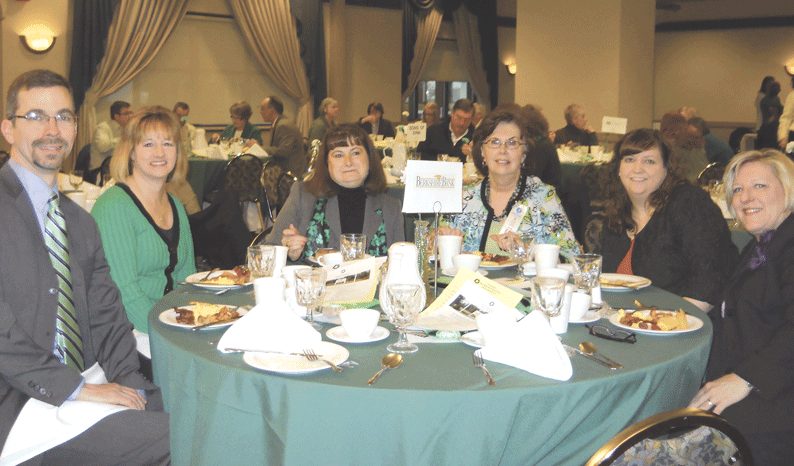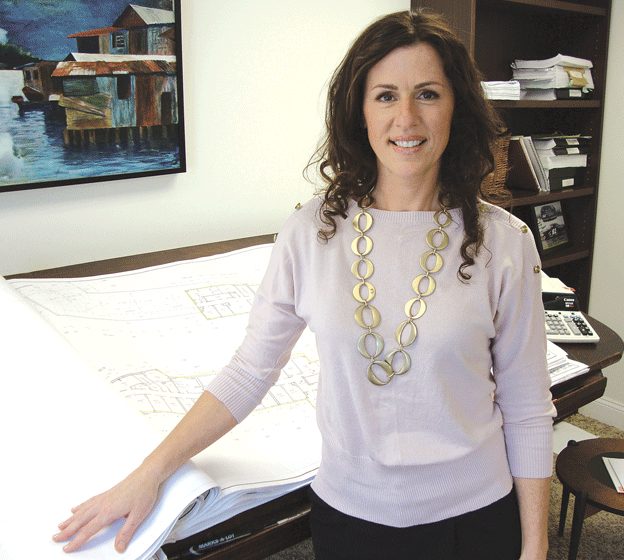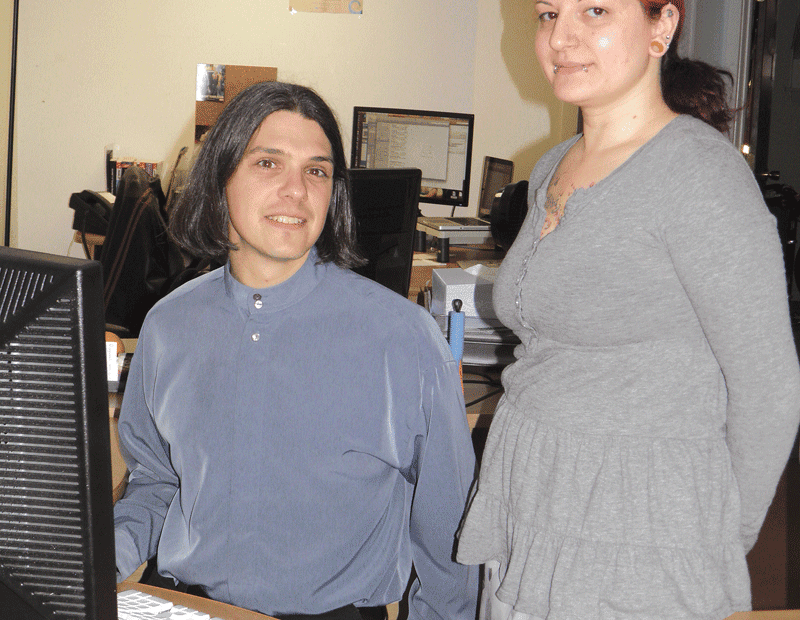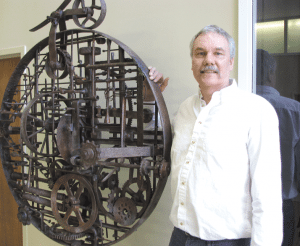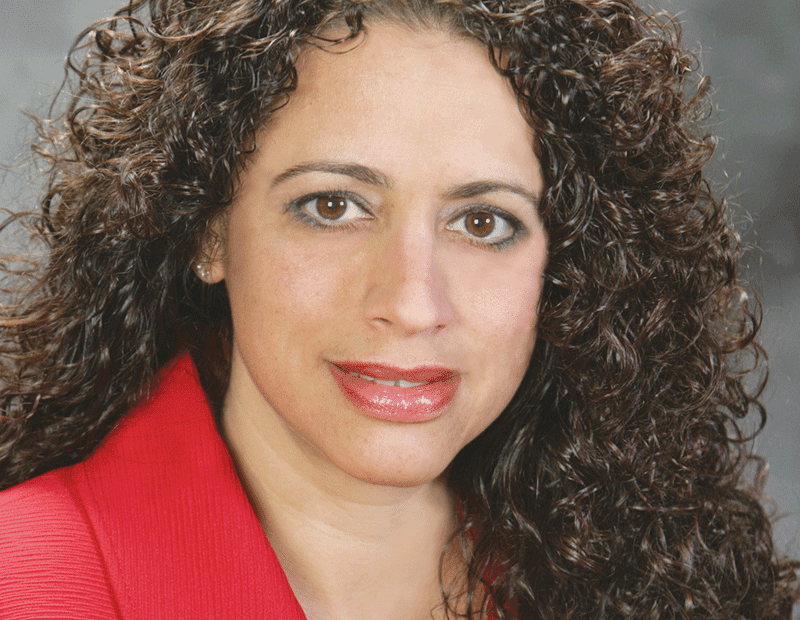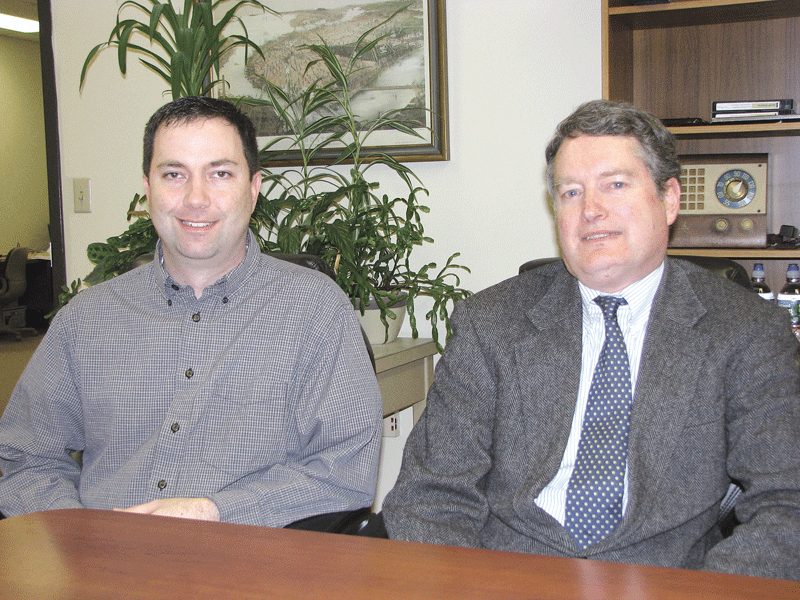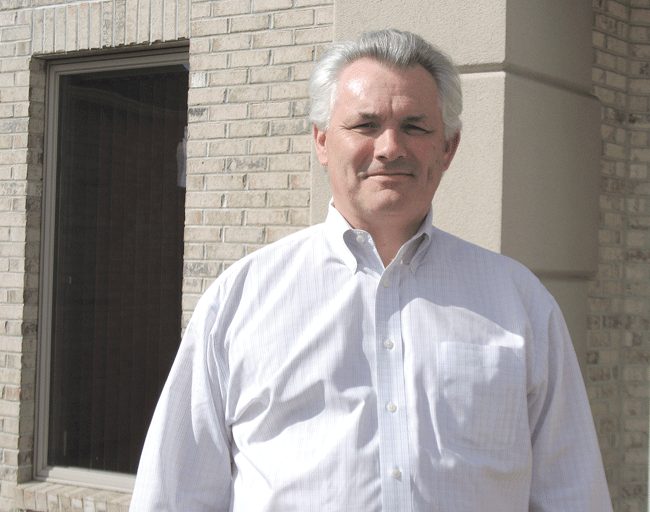Month: March 2012
Big Y Completes LED Lighting Retrofit
SPRINGFIELD — Big Y Foods and Groom Energy recently announced the completion of a significant LED lighting retrofit at Big Y’s distribution facility in Springfield. The energy-efficiency upgrade is part of a broader scope of sustainability-oriented investments in its operation that will reduce the company’s environmental impact. The newly implemented LED lighting system applies the latest lighting and networking technologies, bringing better illumination, operating efficiency, and energy-savings monitoring to the Springfield distribution center. The upgrade replaced existing T5- and T8-based fluorescent lighting systems, both within the dry and cooled areas, and will reduce annual energy consumption by more than 521,833 kilowatt hours. This initiative will eliminate more than 4,000 pounds of carbon annually. Groom Energy worked closely with the Big Y energy-management team to design, test, and install the upgrade. The system is based on LED products from Digital Lumens, a Boston-based LED-systems manufacturer. The project was supported by financial incentives from Western Massachusetts Electric Co., which regularly supports energy-savings upgrades by its commercial and industrial customers. “We’re very pleased with the results of our lighting-upgrade project,” said Gary Kuchyt, manager of the Energy and Sustainability Department at Big Y Foods. “It has been a successful collaboration from the onset and will help us to dramatically reduce our energy costs — a great outcome for our company and our customers.”
INK Products Supports Square One
CHICOPEE — INK Products, an office-products, printing, and promotional-products supplier, is teaming up with local businesses in an effort to raise funds for Square One. Tom Guertin, founder of INK Products at 25 Grove St., noted that Square One will receive a percentage of a business’ purchases as a donation direct from INK Products. “This is another way local businesses, including mine, can give something extra to Square One,” he said. For more information on the promotion, contact Guertin at (413) 594-7533.
Hampden Bank
Charitable Giving
Tops $716,000 in 2011
SPRINGFIELD — The Hampden Bank Charitable Foundation Inc.’s charitable giving topped $716,000 in 2011, according to Glenn Welch, president and COO of Hampden Bank. “In addition to our foundation grants, the bank also provided significant financial support to area communities in excess of $116,000 through our marketing and human-resources departments’ community-relations activities,” noted Welch. He added that much of the funding was allocated to youth development, school enrichment, and Little League programs throughout Hampden County. “As we prepare to celebrate our 160th anniversary on April 13, I can think of no better way to mark the occasion than by recommitting ourselves to our long history of community service and support as we move through the 21st century,” he said. Community organizations receiving grants included the American Red Cross, the Salvation Army, DevelopSpringfield, the Food Bank of Western Massachusetts, Friends of the Soldiers Home of Holyoke, Square One, and Rebuild Together.
Three Companies Join to Create Red Thread
BOSTON — Three New England businesses have joined forces to become Red Thread, according to Jenny Niemann, chairman of the company. The newly combined regional enterprise connects work, workers, and the workplace as the authorized Steelcase dealer in New England. Red Thread is comprised of three companies that previously operated under the names of Office Environments of New England, bkm Total Office, and Business Interiors. “When we initially brought these three companies together, we knew they were three strong brands, each with its own brand equity in its own territory,” said Niemann in a statement. “An ancient legend describes a red thread as an unbreakable link between those meant to be together. Rebranding under Red Thread enables us to express to our customers the connection we see between our culture, values, and business mission.” Niemann added that the name also “articulates our aspiration to help our customers identify their own common threads — the way their brand, culture, and promise can be effectively expressed through their environments’ furniture, technology, architectural systems, and audio-visual solutions.” For more information, visit www.red-thread.com.
Monson Savings Reports ‘Outstanding Results’
MONSON — Monson Savings Bank President Steve Lowell recently announced that the bank’s 2011 results surpassed national and statewide benchmarks for growth and profitability while posting a record year for giving back to the community. During the bank’s annual meeting, Lowell noted that deposits grew in 2011, predominantly in core deposits, by 11%. Also, Monson Savings achieved a return on assets of 0.66%, which ranked first among peer banks throughout Massachusetts, according to Lowell. “The bank also announced outstanding results for its Financial Advisory Services division and compared these results to the 172 other banks that partner with Infinex Financial Group throughout the East Coast,” he said. “Specifically, Monson Savings ranked second of the 50 peer banks and 24th out of all Infinex partners.” He also noted that the bank gave back a record $142,000 to the community in charitable donations. “What I am most proud of is that we were able to give back so much to our community last year,” said Lowell, “while at the same time keeping our institution growing and financially healthy. We had an outstanding year, and I can’t thank our customers, staff, board, and corporators enough for their contributions.”
Open Square Welcomes Brave One Agency
HOLYOKE — Brave One, an agency specializing in corporate social responsibility and sustainability communications, recently selected Open Square for its new location. The agency plans to grow considerably in the coming year, and Brave One founders Lukas Snelling and Jesse Mayhew feel the building will allow them to grow while staying true to its commitment to sustainability. “We are really excited to be in Holyoke and participate in the Paper City’s digital revival,” said Snelling. “We think this city provides a great platform for us to do business, and we look forward to the possibility of expanding even further here.” Mayhew echoed the sentiments of Snelling. “Open Square seemed like a natural fit,” he said. “Not only are they reusing beautiful mill space, but they are generating their own renewable energy to power our office. We couldn’t be happier to be part of such an amazing and growing community.” Both founders hope their growth “will be a contributing force in Holyoke’s continued revitalization.” Brave One’s new office is located at 4 Open Square Way, Suite 219. For more information, visit www.braveoneagency.com.
Easthampton Savings Launches eBranch
EASTHAMPTON — Easthampton Savings Bank has introduced a new eBranch that will be replacing its Web site at bankesb.com, according to William Hogan, president and CEO. “Our goal was to mirror what a typical experience would be for one of our customers visiting a branch and to bring it to our virtual site,” Hogan said. “This will allow greater online functionality and resources for our customers, making the entire site more convenient and easier to use.” The new eBranch will offer site search, online account opening, loan applications, and customer service along with fun and useful tools such as interactive calculators and an educational-resource center. To celebrate the launch, the bank is offering a CD and auto-loan special online. For more information, call (413) 527-1111.
JN Phillips Auto Glass Expands Service
CHICOPEE — JN Phillips Auto Glass recently opened a 7,500-square-foot distribution center in the city, and also added a Springfield service center and relocated its Northampton service center to 144 King St. “Combined with its service centers in Chicopee and Pittsfield, JN Phillips has increased the company’s ability to provide Western Mass. customers even faster, more convenient auto-glass replacements and repairs while ensuring the highest safety standards possible,” said Robert Rosenfield, CEO. Rosenfield also noted that the company has begun offering windshield recycling. “It took some time, almost two years, and a financial commitment to figure out how to do it, but it was worth it, and our customers really appreciate knowing that, when they have us replace their windshields, the damaged ones don’t end up in landfills,” said Rosenfield. “For all of us in this beautiful Pioneer Valley, preserving our environment is paramount.” In related news, Dan and Matt Bean, former operators of Bean’s Auto Glass, a locally owned family business for more than two decades, have joined JN Phillips Auto Glass. “We are very proud to be part of JN Phillips Auto Glass now,” said Dan Bean. “This is another family-owned business that puts customer service and community values first. The company’s commitment to safety, convenience, and expertise leads our industry.”
United Bank Foundation Awards $34,500
WEST SPRINGFIELD — The United Bank Foundation recently awarded $34,500 in grants to community initiatives in the Springfield area during the organization’s most recent round of funding, according to Dena Hall, president. Womanshelter/Companeras, a Holyoke-based nonprofit dedicated to assisting victims and survivors of domestic violence, received $5,000 in support from the foundation. In Springfield, students will benefit from the foundation’s $5,000 grant to Springfield School Volunteers to support the Science, Math, and Reading Tutoring (SMART) program. Also, a $5,000 grant will provide support to the Enchanted Circle Theater, an educational theater company based in Holyoke that inspires learning through the arts. The foundation awarded grants of $4,000 each to the Community Adolescent Resource and Education (CARE) Center in Holyoke, to fund a portion of the teen Rowing Strong, Rowing Together program; to Noble Hospital in Westfield, to purchase recliners for psychiatric patients in the Emergency Department; and to Springfield College, to fund the East Campus renovation project. Additional grants included $3,000 to the Carson Center for Human Services in Westfield, to fund a fully accessible spray park for Kamp for Kids; and $2,500 to Valley Community Development Corp., to support a foreclosure-prevention counseling program for Hampshire County residents. Grants of $1,000 each went to Domus Inc. to support the community youth and adult basic-education program in Greater Westfield; and to the Northampton Center for the Arts, to support Northampton Draws, a free community art festival and workshop. The United Bank Foundation has awarded more than $1.4 million in grants since it was established in 2005 as a permanent source of funding to benefit communities in United Bank’s market area.
Huntley Associates Takes Pride in Its Diversity and Long History

Michael Schafer, left, and Senior Engineer Gregory Henson take pride in offering alternative designs and approaches to each of Huntley’s projects.
Specifically, he makes it a point to shake a client’s hand, look him or her in the eye, and give his word that his company will do everything possible to stay within budget and complete the project through carefully orchestrated teamwork. “It all boils down to proper planning and preliminary design. People who see the end product often don’t understand all of the steps that went into it. And in today’s economic times, proper strategic planning is important for a project to be cost-effective,” Schafer said, adding that clients are presented with alternative designs, ideas, and approaches to ensure that they are satisfied.
“When I write out a proposal, it’s very detailed. It lays out every step required from planning to finish. It also allows the client the opportunity to see the cost, which is particularly important because it can determine whether they decide to proceed,” Schafer said. For example, if a residential housing complex will intrude on wetlands, it may become cost-prohibitive or more than a client wants to spend.
“It really depends on the complexity and location, but if a project involves environmental concerns or reviews from state or federal agencies, the scope and fees can become a little fuzzy,” he continued. “For example, if a road has to cut through a swamp, there may or may not be endangered species living there, such as turtles or frogs. Wetlands are a big concern, and you have to work around them, which can mean moving the project or a building to a different location.
“A successful project can no longer be defined in purely technical terms,” he went on. “Regulatory, economic, and administrative issues are now major concerns.”
Therefore, it’s critical to lay out roadblocks to reduce the potential for change orders during construction, Schafer said.
He prides himself on creating a working relationship with everyone who will play a role in or on the job. “I promote a team approach,” Shafer said. “It involves the owner, client, and contractor as well as regulatory agencies, including towns or cities.”
They sit down together, which is important, as it allows different sectors to have input “sooner rather than later, after construction has begun,” Schafer said.
His staff members are not typical engineers. “We’re people who have been in the construction industry, so we understand the complexities involved, which makes it a positive experience for everyone. And if we help each other, the end result is typically an exceptionally constructed project that is completed within budget,” he told BusinessWest.
Schafer said unexpected issues often come to light during the building phase. “But if we work with the contractors, they work with us, so we end up with fewer change orders due to our relationship. And we like to take a project from start to finish to ensure that our clients are truly getting everything they are paying for. It helps that we know the local boards, conservation commissions, and regulations, because we have worked here for 50 years and are surveying the area in which we live.”
In the Beginning
Huntley Associates was founded by E.E. Davis in 1870, and is one of the oldest continuously practicing surveying and engineering firms in New England. “Our employees live in the area, so they are committed to making this a better place to live,” Schafer said.
The company was purchased by Almer Huntley in 1963. “At that time, the company’s main forte was surveying. The first engineering project was done in the late ’60s,” Schafer said.
The additional scope led to growth, and a second office was added in Maine. “By the late ’80s, the company had gone from a two- or three-man show to 80 employees,” he noted.
Huntley reached its peak during the ’70s and ’80s when it was called upon to do a number of projects across Western Mass. A large portion of the work was the civil and structural engineering and mechanical and electrical planning required to build wastewater-treatment plants.
“They were turnkey projects,” said Schafer, noting that the boom continued during the Reagan administration. “There was a lot of money pumped into the economy which was targeted for wastewater plants and infrastructure.”
But after Reagan left office, jobs became harder to get. There was a downturn in the economy, so Huntley closed its Maine office, and the firm stopped doing structural, mechanical, and electrical work, focusing instead on site development via civil engineering and surveying.
When Huntley made the decision to retire, Schafer purchased the firm. He had established Schafer Engineering Associates in Albany, N.Y. in 1994, and the men had worked together.
At that point, Schafer incorporated the services of his two companies. “It was done to consolidate resources and provide a larger capability to clients,” he explained, noting that today, the two companies share resources. “It allows us to keep our rates reasonable.”
Local clients who employ Huntley’s services find they can save time and money when historic records are needed, since their files date back to the mid-1800s. “We have old prints as well as plans and records from subdivisions in many communities, including Springfield and Holyoke. It’s a valuable resource,” Schafer said.
Changing Focus
In 2002, much of Huntley’s work was focused on new residential subdivisions. However, once the recession hit in 2008 and those jobs began to decline, the company’s focus changed again. Today, it’s working on subdivisions in Granby and New York as well as a nine-building apartment complex with 54 units in Amherst.
Other projects include new public-safety buildings in Granby and Montague. “And we are in the final stages of construction of a public-school expansion,” Schafer said.
His two companies have also collaborated on projects for the U.S. Department of Agriculture, and they have done work on parks in Vermont, New Hampshire, Massachusetts, and New York.
Road construction is another forte, and a recent $1.3 million project involved improving a 1.3-mile stretch along Parker Street in Springfield. “There was an overhead railroad bridge which was very narrow, so the street narrowed at that point,” Schafer said.
As a result, the crossing and bridge both had to be rebuilt, which meant the train track had to be temporarily relocated. It was a complex project and involved many agencies, as it was federally funded.
The company was also responsible for the portion of the Manhan Rail Trail that runs through Northampton. Three bridge crossings were included in the initial plan, but a reduction in budget meant it had to be changed to a street crossing. Providing access to the pathway also proved problematic due to elevated stormwater levels and telephone poles which stood in the way and could not be moved. “It took a lot of coordination and communication,” Schafer said.
But these large undertakings are only part of what the company does. “We consider ourselves a multi-disciplinary firm and have always been known as an icon in the area. But most of our work is not recognized. We do structural inspections of municipal and private buildings and a lot of assessments of historic structures,” he explained. There is also storm mitigation work, which has occurred frequently since the June tornado and major rainstorms that followed.
“A major stream bank that collapsed in Whately is threatening the water supply there, so we are helping there,” Schafer said. The company also spends time with officials in municipalities who call on them seeking advice about their treatment systems, grant applications, and landfill monitoring.
“Smaller projects are our bread and butter. We do everything from single-home surveys to surveys of 200 acres or more. And we have worked for many government agencies on the state and federal level,” Schafer said.
The company tries to be creative whenever it can, and uses environmentally sensitive approaches, such as a rain garden it designed for the Amherst apartment project that will divert the runoff of water from the buildings to the garden. “It’s an eco-friendly approach that we can use within the available budget,” he noted.
Back to Basics
The company has evolved continuously during its 142-year history, but through all that change there have been many constants.
“We’re still here and have been here for a long time,” Schafer said. “We have worked in every arena and every county, and are economical.”
But to him, what matters most is the company’s reputation.
“When I shake hands with someone or tell them something, my word is golden,” he told BusinessWest. “I get a real kick of out of helping people and enjoy solving problems. In the end, it’s not just a business. It’s what I believe in.”
Rivers Protection Act Balances Needs of Development, Environment
 Melissa Coady paused before explaining the Rivers Protection Act. Because there’s a lot to explain.
Melissa Coady paused before explaining the Rivers Protection Act. Because there’s a lot to explain.
“Of all the pieces of wetlands protection regulations, the section about riverfront protection is the most convoluted,” said Coady, project environmental scientist for Tighe & Bond in Westfield. “There’s so much ‘if this, then this’ that has do with when a parcel was created or when the land was subdivided.”
The Rivers Protection Act, initiated by the Massachusetts Department of Environmental Protection (DEP), was passed into law in 1996 with a number of goals in mind, from preventing water pollution to erosion control; from protecting wildlife to preserving shellfish supplies. It does so by barring or heavily regulating development along the edges of rivers and streams.
“The riverfront area exists to protect the functions and value of those streams and the adjacent areas, in terms of water supplies, groundwater, flood control, prevention of floor damage, wildlife habitat, and fisheries,” Coady said. “It’s trying to roll all these into one area.”
Any understanding of those regulations begins with the riverfront area itself, which is defined as the area along any perennial stream — roughly defined as a stream or river that runs all year, except in extreme drought — between the water line’s annual high-water mark and a parallel line measured 200 feet offshore (except in certain urban areas; more on that later).
“The initial purpose of the Rivers Protection Act was to provide a buffer zone along streams and rivers that are considered perennial — that is, they don’t dry out,” said John Prenosil, president of JMP Environmental Consutling in Springfield. “The idea is to provide wildlife habitat protection, water quality, flood protection, nutrient removal, benefits of that nature.
“A perennial stream,” he explained, “is defined as a stream that’s shown on the most recent USGS [U.S. Geological Survey] mapping as a solid blue line. A dashed line represents an intermittent stream, meaning it dries out.”
And protected property doesn’t necessarily have to be, well, wet. According to the DEP, “riverfront areas may contain wetlands and flood plains, as well as what have traditionally been considered upland areas. As a result, the features of the riverfront area vary by location: from asphalt and landscaped greenways in urban areas to woods, lawns, and farm fields in suburban and rural areas.”

Melissa Coady says the state’s riverfront rules are among its most complex regulations in the realm of wetlands protection.
That can make life tricky for developers, and even thornier for individuals who purchase their dream property, only to find out it’s essentially useless to them.
Multiple Goals
The DEP, however, decided 16 years ago that the value of protecting waterways outweighed the needs of developers. It argued that unspoiled riverfront areas prevent pollution by filtering and trapping sediments, oils, metals, and other pollutants, as well as cleaning water through toxic chemical breakdown in soils and plant roots.
It also asserted that riverfronts protect water supplies by removing pollutants that are carried in runoff from nearby commercial sites, roadways, housing developments, and parking lots before they reach surface water, as well as allowing water to seep down into the ground to replenish groundwater supplies and maintain base flows in streams and wetlands. More than 60% of Massachusetts communities are at least partly dependent on surface water as their primary source of drinking water.
In addition, according to the DEP, riverfront areas protect fisheries and land containing shellfish by moderating stream temperatures, reducing erosion, and filtering sediments and pollutants before they reach rivers — important, because these fisheries and shellfish beds are critical for recreational and commercial harvesting, as well as providing food sources to support the aquatic food chain.
Riverfront areas also protect wildlife habitats by providing food, shelter, and water for many plants, birds, and animals; serving as travel corridors year-round and during seasonal migrations; and harboring rare or endangered plants and animals.
Finally, the DEP noted, riverfronts control flooding and prevent storm damage by absorbing and storing water during storms and releasing the water slowly back to the river.
The law does take into account the fact that urban development tends to spring up alongside waterways. The protected area is reduced from 200 feet to 25 feet inland from the high-water mark in cities with a population above 90,000 or areas of smaller communities with a certain population density; in Western Mass., only Springfield merits that distinction.

John Prenosil says navigating the nuances of the act is difficult because every site and proposed development project is different.
Historically, Coady said, urban areas were built up along rivers to begin with, “so the function and value of undeveloped riverfront areas are virtually absent. But there’s still a need to regulate to a certain extent how those areas get developed.”
However, Prenosil noted, “that being said, the Rivers Protection Act does make development in urbanized areas difficult for sure,” even in municipalities that qualify for the 25-foot protected area.
Of all the resource areas designated by the DEP, Coady said, riverfronts are probably the trickiest to deal with. “The burden is always on the applicant no matter what the filing is — to demonstrate that you’ve met the performance standards, that you won’t have an adverse impact, and if you do have an impact on the resource area, that you’re mitigating it in the way the regulations call for.”
Some Exceptions
But what about properties purchased before the act went into effect? It turns out the law offers a bit of wiggle room.
“If you are working on a parcel of land that was recorded on or before Oct. 6, 1997, then you are allowed to alter 5,000 square feet, or 10% of the total riverfront area, whichever is greater,” Coady explained. However, “you have to keep at least 100 feet of undisturbed vegetation between the high-water line of the river and the limits of your disturbance. So, even though the provision allows for the development of the riverfront area, they’re still trying to protect the corridor along the river.”
And what if someone purchases a previously developed parcel along a river or stream? As it turns out, the state grants some leeway for development, as municipalities and state agencies are always seeking to improve neglected properties while still adhering to the intent of the 1996 law.
“If you’re not looking at a pristine landscape, if you’ve got an area that already has roads, or has an old parking lot, or is devoid of topsoil — dumping grounds, that sort of thing — if you clean that up, you can develop that area,” Coady explained.
“They’re trying to give an incentive to improve the existing conditions,” she added. “But there are some caveats. The total footprint of the work can’t exceed the total amount of degraded area, and you have to provide some sort of restoration of the degraded riverfront area.
“It could be that people have been dumping things there, and you could be removing the dumped material. You could plant native herbaceous or woody species to enhance the existing riverfront area,” she continued. For instance, if the previously developed area encroaches to within 75 feet of the river, but the 50 feet closest to the water line is undisturbed, a developer might provide new plantings over the intervening 25 feet.
“When you’re redeveloping a piece,” Prenosil noted, “as long as everything stays the same footprint, it’s relatively straightforward, as long as you’re getting no closer to the waterfront.”
Decisions are made on a case-by-case basis, Coady added. “That’s one of the reasons this set of regulations is so lengthy and complex. It’s very difficult, even with a clear-cut case, to fit these projects into neat little boxes. A lot of headscratching goes into it, and sometimes, there’s a lot of gray area.”
Common Good
The DEP claims that the legislation “took a measured approach to environmental protection — work in the riverfront area is not prohibited, but applicants must demonstrate that their projects have no practicable alternatives and will have no significant adverse impacts.”
With her background in this field, Coady said, it was natural for her to consider flood plains and wetlands and rare species when she purchased property, but not everyone seeks professional help before making a purchase, and many have been stuck with undevelopable land.
“It would absolutely be recommended to have a feasibility study done beforehand,” she said. “If the property has any wetlands or riverfront area, it would be advisable to take into consideration what uses someone wants to get out of that property in the future, because it may not be feasible under the current regulations.”
The law can be particularly thorny in cities that don’t meet the population threshold for the 25-foot exception, Prenosil said.
“This works great up in the hilltowns, but Pittsfield is problematic when working with residential areas,” he noted. “It’s difficult to apply one standard to everyone because there’s always unique situations.
“Basically,” he continued, “the DEP said, ‘look, we need more protections along the streams and rivers.’ The regulations are always changing; they’re dynamic. Maybe the next iteration of this will address some of those problems.”
Joseph Bednar can be reached at [email protected]
Could the Valley Become a Hub for Video-game Companies?
 Allan Blair freely admitted his understanding of the video-game industry is limited. Or was, anyway.
Allan Blair freely admitted his understanding of the video-game industry is limited. Or was, anyway.
“I had the simplistic view that gaming meant being frustrated by Angry Birds,” said Blair, president of the Western Mass. Economic Development Council (EDC). “The fact is, it’s truly a business, a real industry, and not just something to wile away time on. I had no idea.
“But once I got my mind around that,” he continued, “naturally, as an economic developer, I asked, ‘how do we nurture growth in this kind of industry in Massachusetts?’ As I learned about the industry, I came to believe we have in Western Mass. a lot of aspects necessary for this industry to grow and thrive.”
That was the general sentiment among more than two dozen panelists participating in “Digital Games: Playing in the Valley,” a recent symposium co-sponsored by host Hampshire College, the Mass. Digital Games Institute, and the EDC. The event drafted video-game entrepreneurs, professors from several colleges, political and economic-development leaders, and other speakers to discuss the potential of this fast-growing industry to take root and bring economic benefits to the Bay State.
“I am not part of what you would consider the ‘video-game generation,’ but video games encompass more than they used to,” said state Rep. Jim McGovern (D-3rd District). “Few industries these days can project the growth characteristics of the game industry … and those jobs should be in Massachusetts.”

Mike Levine says Western Mass. won’t reach its full potential in video-game development and related fields until the region is adequately wired for high-speed Internet.
“The Western Mass. region thrives on creativity and innovation, and I want to see these businesses blossom right here, and for these students to stay in the Valley and pursue their passion for video-game design,” McGovern said, noting that game technology has crossed over into other industries, from military training to medical applications, and is likely to expand further. “This is not a bunch of people talking about this in theory; this industry is growing now. And to get the economy back on its feet again, this is one of the answers.”
No Smokestacks
John Musante, Amherst’s town manager, called video games a potential “smokestack industry without the smokestacks. I enthusiastically believe that the gaming industry would be good for Amherst and good for our region.”
He mentioned that the three colleges in his town alone — UMass, Hampshire, and Amherst — include some 29,000 students at any given time, while others at the symposium noted that the 13 colleges in Western Mass. total some 65,000 students, many of whom are enthusiastic about gaming and might be likely to pursue jobs in the industry locally if they exist.
“Creativity and innovation are what our region is all about,” Musante added. “We believe the creative economy is part of our future, and the prominent potential of the gaming industry certainly seems like a perfect opportunity to build upon together, right here in the Valley.”
Take Raf Anzovin, for example. He launched Anzovin Inc., which creates character animation for games and other entertainment, in Florence in 1999 — a time when he was one of only a handful of people in the area doing that kind of work.
“There are both advantages and disadvantages to being in this area,” Anzovin said. “The cost of living is difficult to minimize. I’m not sure we could possibly start a small character-animation studio from nothing in a place where the cost of living wasn’t so low. We’ve also had a good relationship with the colleges; there’s a lot of good talent coming out of them, and that’s been very beneficial.”
Then there’s HitPoint Studios, a game-development outfit specializing in newer platforms such as social and mobile games. “We started HitPoint in 2008 with eight people in Greenfield,” said its founder, Paul Hake. “Now we’re in Hatfield with 37 people, and we’re anticipating growing quite a bit more.
“We’re excited about what’s going on in the Valley,” added Hake, who sees the region eventually becoming not just a mini-hub for the video-game industry, but a full-blown hub.
Musante said the region sells itself, especially at a time when industry professionals are virtually connected across the globe, and no longer have to be located in a major metropolitan center.
“We have a critical mass of higher education and talent. We have space,” Musante said, adding that the Pioneer Valley’s location less than two hours from Boston and less than four hours from Manhattan, combined with that aforementioned lower cost of living, is a major draw, as well as reputable public-school systems and the region’s natural beauty and outdoor activities. “We feel like we have a lot of things to nurture this industry so it can grow right here in the Valley.”
That growth is already happening, said Pat Larkin, director of the John Adams Innovation Institute, an arm of the Mass. Technology Collaborative. “In this region, the market has already spoken,” he argued. “Firms have flourished; they’re able to germinate, be disruptive, do startups, and grow on a sustained basis in this region.”
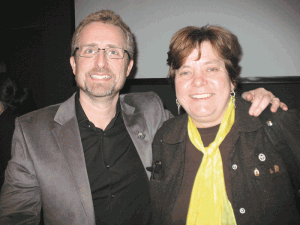
Ruth West (right, with Terrence Masson from Northeastern University) says the fact that game development requires both creative and technical skills is a draw for many students.
Getting Wired
The region poses some drawbacks, too — including one very basic problem in many rural communities.
“The Internet is really what made all this possible, in my opinion,” said Mike Levine, president of Pileated Pictures, an online- and mobile-entertainment studio in Shelburne Falls. “Amazingly, up in the hilltowns, many people do not have broadband. I really think this is a crime at this point; it’s like people not having electricity or television. That’s the number-one issue. Everyone should be connected in the state — not just for entertainment, but for public safety and other reasons.”
Hake agreed, noting that “broadband connectivity in Western Mass. is still not where it needs to be.” Another challenge, he said, is the lack of an experienced workforce to staff growing video-game companies. “We have huge amounts of talent coming out of the colleges, but we have a hard time finding industry veterans.”
There’s a sort of chicken-and-egg component to this issue, however, suggested Joe Minton, president of Digital Development Management in Northampton, which represents video-game-development studios; before that, he was president of game developer Cyberlore Studios.
Specifically, he said, the industry needs to expand in the region to attract that pool of available talent. “In San Francisco, you can walk down the street and meet five or 10 people willing to hire you.”
He talked about the importance of building critical mass in the region, forming a kind of ‘safety net’ so that talented designers, programmers, and others will know that, if one opportunity doesn’t work out, others will be available. Building many success stories, he said, “will make it much easier to bring talent here.”
Fred Fierst, a partner at law firm Fierst & Kane in Northampton, has represented video-game companies for 20 years, he said, amassing a strong reputation in the U.S. and overseas. But even he still sometimes encounters a “credibility issue” regarding Western Mass. that must be overcome. “They think if you’re not a New York or LA laywer, you can’t be a good lawyer; even a Boston lawyer is considered second-rate.”
Fierst noted another issue in video-game development, and that’s a pronounced dearth of women in the field. “I am constantly amazed how few women there are, and those who are [in the field] are in marketing and PR,” he said. “But that’s changing.”
Anzovin agreed. “I’d love to see more women in the industry,” he said, noting that he has worked with many female producers, but few artists and programmers — in other words, people on the creative side. “I don’t know that there’s a magical solution to that problem, but it’s getting better slowly.”
Back to School
Hake said colleges and universities are doing their part by recruiting more women into computer science and related programs.
Ruth West, associate professor and director of Computer Graphics at Springfield College, said the field has an appeal that should appeal to a wide variety of career seekers, no matter their gender. “It requires students to use their whole brain. It’s not just creative, but you have to think technically. There’s a whole mechanical side and a visual side, and it gets students to integrate their whole personality.”
It also requires professors to constantly keep up with trends, she said, which is why she and other faculty attend many conferences and continually track the industry in other ways.
“The only thing we can teach them is how to learn, because five years from now, it’s going to be something different,” West said. For example, social-media and mobile games have dominated the field recently. “I learned 56 programs, and they need to learn how to be that flexible.”
Paul Dickson, visiting assistant professor of Computer Science at Hampshire College, said video-game design is a motivator for students to learn many other skills. His program focuses on training students as generalists, so they can adapt to any platform, a trait valued by smaller video-game companies. Students who go on to specialized work — in a certain type of programming or animation, say — may find greater opportunities at larger companies.
“Games are a hook,” said Mark Claypool, professor and director of Interactive Media and Game Development at Worcester Polytechnic Institute. “We get students coming through the doors passionate about the things they’ve been playing. That’s gold, to get a student who comes to college excited about learning something … not just about the latest game, but the physical calculus, the music, the storytelling. There are lots of elements that have to go into the next great game.”
Or the next great … whatever. “There are many applications outside entertainment,” Claypool said, “and that’s where the real action is going to be; that’s where the real money is.”
McGovern said Massachusetts clearly has the intellectual capital to build on this work and be an innovator in those future applications, adding that state leaders are continually trying to determine how best to invest in those growing industries through infrastructure and research dollars.
“I feel like there’s a renaissance period going on now,” Pileated’s Levine said, noting that, when he was in school, video games weren’t even mentioned as a possible career path. “Now we actually have schools teaching programs, and kids coming out of school knowing game design.
“I think it’s a very exciting time,” he continued. “As a company, we’re really interested in growing our business in this region, and we need young talent who understand mobile and social gaming far more than we do. What we learned was a very different business model. Things are changing very rapidly.”
And because of online connectivity, breakthroughs can happen anywhere, Minton said. “The world is flat, and it’s really exciting what can be done nowadays.”
He cited Rovio, the Finnish maker of the Angry Birds franchise. “This was a small company making a number of games that weren’t very successful,” he noted. “Now they have many, many hundreds of people. It just takes one hit — and there’s no reason that can’t happen here.”
Joseph Bednar can be reached at [email protected]
Valley Leaders Announce a Hampshire County Chamber of Commerce
Suzanne Beck says there are many things about the recently formed Hampshire County Chamber of Commerce that she doesn’t know yet — such as the official name (that’s the working title above), the specific operating structure, or which organizations will choose to affiliate with it.
But what she does know is that, if this entity comes together and evolves in the manner that supporting businesses and economic-development leaders expect, it will provide something that has been historically missing from this eclectic and vibrant part of the state — a truly regional voice.
“The vision for the organization is not what’s in place right now, but what we’re building toward,” said Beck, executive director of the Greater Northampton Chamber of Commerce and also the interim director for the Hampshire County Chamber, as she discussed the primary motivations for creating the new body. “The vision is to have an organization that can serve as an umbrella for local business agencies that may include more than chambers, and be more effective and create more capacity for doing direct service to business, but also convene and represent the economic initiatives we’d like to advance as a region.”
“It’s really about convening people across the county,” she continued. “Now, the representation is fragmented in terms of reporting views to elected officials and those in various sectors across the region and statewide. A regional chamber will help construct a consistent voice on priorities for Hampshire County.”
Beck said formation of the regional chamber will not threaten the existence of the three chambers of commerce currently serving communities in the county — the Northampton Chamber, the Amherst Area Chamber, and the Greater Easthampton Chamber — because they have specific roles and should continue in them.
“One of the important tenets of this regional chamber is that the local chamber remains intact,” she said, “and is better supported by the increased capacity of the organizations that are part of the regional chamber. That’s one of the things we learned from talking to other people.”
The regional chamber is expected to provide the county with a strong strategic presence at the State House and before regional organizations such as the Pioneer Valley Planning Commission and the Economic Development Council of Western Mass. (EDC), she went on, adding that it will act to coordinate resources to support small businesses and “amplify” (a word she used often) attention to local issues.
In that respect, it will be similar in some ways to the EDC, which was one of many potential models that were researched while exploring how and when to proceed with a new regional entity.
The new chamber’s first assignment, said Beck, will be to convene the appropriate parties and create what she called an “economic strategy” for Hampshire County, or a blueprint moving forward, something else that’s been missing from the equation when discussing the region that includes Northampton, Amherst, Hadley, South Hadley, Easthampton, and many smaller communities.
“That’s going to be the first deliverable,” she said of the strategic plan. “It’s going to be an effort to bring people together from the business sector, the nonprofit sector, and the municipal sector to create that economic strategy for Hampshire County that identifies what the priorities are and what will have the most impact, and that we can all share in working toward.”
Beck told BusinessWest that the new chamber, created with a formal vote at the annual meeting of the Greater Northampton Chamber of Commerce on March 10, continues a pattern of regional thinking and doing in Hampshire County. Examples include formation of Leadership Hampshire County, an initiative to cultivate young leaders across the country, and also the Regional Tourism Council in 2011 — an organization that is in some ways a model for the new chamber — as well as a decidedly regional approach to redevelopment of the Three County Fairgrounds in Northampton. Meanwhile, it also echoes steps taken in regions across the Northeast and beyond to incorporate a more-regional approach to economic development.
Citing one of many such efforts, Beck listed the Portland, Maine Business Alliance, a group comprised of several chambers in that area as well as other economic-development agencies.
Rus Peotter, general manager at WGBY public television in Springfield, who will serve as the chairman for the new regional chamber, agreed, noting that the regional model is not a new concept.
“It’s already here in our region in the Berkshires, Franklin County, and Springfield, but it’s even bigger around the country,” he said. “There are many models across the country. This is not a completely new concept or something we’re trying to invent.”
Peotter said a regional chamber will provide the county with better representation at regional economic-development meetings where decisions are made about funding and priorities for the Pioneer Valley. “With a regional chamber, the county will not only have someone in the room, they’ll have someone at the table.
“The county will have representation at these meetings and will have some clout,” he added. “You have to have enough gravitas to even be considered a player, and right now, Hampshire County does not. It’s not like it’s being excluded. There’s just no one person to call.”
Beck concurred, noting that, while Hampshire County business leaders serve on the boards for organizations such as the EDC, they represent their respective businesses, and not Hampshire County as a whole, while doing so.
Founding members of the chamber have already invested over one-third of the $400,000 needed over two years to get the concept in full gear, said Beck, adding that regional partners are being invited to become first-tier investors in the new entity, investing in the concept and helping to raise that $400,000 for startup work.
The initial to-do list includes the aforementioned brainstorming on a regional economic-development agenda, and also organizing events that focus on opportunities in Hampshire County. The Hampshire County Chamber will be a new legal entity with a structure for local organizations to affiliate with, starting with the Greater Northampton Chamber of Commerce and its members.
The startup funds will be used for the first two years of operations, after which the regional chamber will be supported by member dues.
Founding directors of the regional chamber include Peotter; David DelVecchio, owner of Innovative Business Systems, Easthampton; William Dimmitt, account manager for the AxiA Group, Easthampton and Springfield; John Heaps, president of Florence Savings Bank; William Hogan, president and CEO of Easthampton Savings Bank; Chuck McCullagh, chief financial officer of the Williston Northampton School, Easthampton; Curt Shumway, partner at Hampshire Hospitality Group; and Janet Warren, owner of MarCom Capital in Hatfield.
One-third of the startup funds have been raised by the founding members and the following businesses and organizations: Coldwell Banker Upton Massamont Realtors of Florence and South Deerfield, Easthampton Savings Bank, Florence Savings Bank, Innovative Business Systems, MarCom Capital, Pioneer Training of Northampton, Robert Reckman of Northampton, Smith College in Northampton, United Personnel of Easthampton and Springfield, WGBY-TV, and Williston Northampton School.
— George O’Brien
Springfield Official
Named to Casino Panel
BOSTON — Bruce Stebbins, business development director for the city of Springfield since September 2010 and a former member of the Springfield City Council, has been named to the Massachusetts Gaming Commission. The five-member panel is now complete. The other members are Chairman Steve Crosby; Judge James McHugh, who served on both the Superior Court and the Massachusetts Appeals Court; Gayle Cameron, a former New Jersey State Police lieutenant colonel; and Enrique Zuniga. Prior to his work with the city, Stebbins worked for the National Assoc. of Manufacturers and the Mass. Office of Business Development.
WMECo Grant Seeks to Boost Industry Competitiveness
SPRINGFIELD — The precision-manufacturing industry in Western Mass. received a major boost recently with the announcement of a $10,000 private initiative to increase the skills competencies of employees. The Regional Employment Board of Hampden County Inc. (REB) received the grant from Western Massachusetts Electric Co. (WMECo) to provide skills-enhancement courses and college-credit courses to 65 incumbent employees of the region’s precision-manufacturing companies. The award will be used as a match to a $150,000 grant received by the REB and its partners represented by the Western Mass. Chapter of the National Tooling Machining Assoc. (WMNTMA), which was announced in October by Secretary Gregory Bialecki of the Mass. Executive Office of Housing and Economic Development. The $150,000 grant from the Massachusetts Technology Collaborative’s John Adams Innovation Institute supports the work of the REB’s Precision Manufacturing Regional Alliance Project (PMRAP), which is focused on generating innovative and creative ideas that will raise the industry’s and region’s economic profile. “We are pleased to make a contribution to education that will stimulate growth for small and medium-sized precision-manufacturing companies,” said Peter Clarke, WMECo president and COO. “The region will benefit from sustained job creation and continued economic development.” In addition to the REB and the WMNTMA, partners in PMRAP include Holyoke Community College, Springfield Technical Community College, the Economic Development Council of Western Mass., and the region’s seven vocational-technical-comprehensive high schools. “The Patrick-Murray administration has made strong investments in growing the Commonwealth’s advanced manufacturing industry,” noted Bialecki. “This grant, in addition to the $150,000 grant from last year, will go a long way to helping give employees the vital training they need to help support their companies’ and industry’s continued growth.”
Forgay Shares Professional Leadership Secrets
LONGMEADOW — Bushido Business: The Fine Art of Professional Leadership is a new anthology featuring Richard Forgay II, president and CEO of Business Leadership Mastery. Forgay joins forces with internationally recognized business icons to share their secrets of success in ways one can immediately apply to business and life for sustainable success. Bushido is the traditional ethical code, or ‘way of the warrior,’ of the Japanese samurai. It is founded on the seven values by which they conducted their life and business of warfare — honesty and justice, heroic courage, compassion, polite courtesy, complete sincerity, loyalty, and duty and honor. Forgay, along with authors and professional speakers Tom Hopkins, Brian Tracy, and Stephen Covey, apply this historical code to the challenges faced by today’s leaders in business, government, education, and other diverse arenas. Forgay noted that the book shares time-proven methods of achieving sustainable success through leadership, team building, sales, marketing, business operations, interpersonal relationships, and customer-service excellence. Forgay’s contribution to the anthology is titled “Mastering the Bushido Code.” “Bushido Business is a moral compass, an authentic expression of individual and organizational values that defines their influence and culture,” he said. With straightforward language and supporting diagrams, Forgay applies the Bushido Code to modern-day professional leaders and actual events. Then he facilitates a structure for readers to apply their own virtues and values to be prepared to do the same in their chosen fields of expertise through a series of self-assessment Bushido Challenges that, if accepted, promise to produce immediate and transformational results. Forgay challenges leaders to embrace their traditional principles and values as the blueprint for major transformation. “Adherence to empowering values is always in vogue,” he said. “Identifying and activating value-based cultural standards of excellence is a way for leaders and teams to embody dignity, trust, and professionalism in their realms of responsibility among those they lead and serve in the business, government, educational, and spiritual communities.” Forgay educates and empowers top executive and entrepreneurial leaders to excel at growing companies where people, productivity, customer satisfaction, and profits thrive in any economy. For more than two decades, he has led and served thousands of people to achieve all-time-high sales and multi-million-dollar revenues, and he has earned international recognition as an effective executive leader in high-pressure, intensely competitive environments in the highest levels of corporate America. For more information on Bushido Business, visit www.businessleadershipmastery.com. Insight Publishing of Sevierville, Tenn. released the book on March 7. It retails for $19.95.
Project Provides Free Interview Clothes
ENFIELD, CT — For many soon-to-be college graduates at Asnuntuck Community College, Stacy’s Closet is a way to relieve some of the stress students with limited resources face, according to Stacy Lanigan, associate director of career services. Stacy’s Closet, now in its sixth year, solicits donations year-round of gently used business clothes from the college’s faculty and staff, as well as the surrounding community. In keeping with the community college’s mission, Lanigan noted that the clothes are also available free to members of the community. She said the college is committed to serving all residents in its service area, which includes Enfield, East Granby, East Windsor, Ellington, Granby, Somers, Stafford Springs, Suffield, and Windsor Locks. Stacy’s Closet accommodates students graduating in June and December. Offerings include shirts and blouses, business suits, shoes, belts, and ties. “We aim to prepare the whole student,” said Katie Kelley, dean of Student Services. “Not just academically, but also for the expectations in the workplace and the interview process.” Donations of clean, professional attire on hangers are being accepted through April.
Construction-industry Employment ‘Sluggish’
WASHINGTON, D.C. — In the week ending March 10, the advance figure for seasonally adjusted initial claims in the construction industry was 351,000, a decrease of 14,000 from the previous week’s revised figure of 365,000, according to the U.S. Labor Department. The four-week moving average was 355,750, unchanged from the previous week’s revised average of 355,750. The advance seasonally adjusted insured unemployment rate was 2.6% for the week ending March 3, a decrease of 0.1 percentage point from the prior week’s unrevised rate of 2.7%. The advance number for seasonally adjusted insured unemployment during the week ending March 3 was 3,343,000, a decrease of 81,000 from the preceding week’s revised level of 3,424,000. The four-week moving average was 3,394,250, a decrease of 25,250 from the preceding week’s revised average of 3,419,500. In related news, Associated Builders and Contractors noted that, despite a loss of 13,000 construction jobs in February, the industry’s unemployment rate dipped to 17.1%, down from 17.7% in January. The nation’s construction industry has added 65,000 jobs, up 1.2%, since February 2011, when the unemployment rate stood at 21.8%. The non-residential building construction sector added 2,000 jobs in February and has added 15,000 jobs, or 2.3% year over year, with employment now standing at 663,200. The residential building construction sector added 2,000 jobs for the month and has added 7,000 jobs, up 1.3%, compared to one year ago, with employment at 573,000. “Predictions for monthly job growth have been on the rise, and February’s performance exceeded those expectations,” said ABC chief economist Anirban Basu. “However, that is only true for the broader economy, not for the construction industry.” Basu added that ABC’s Construction Backlog Indicator, which declined during the fourth quarter of last year, foreshadowed this jobs report and indicates that construction-industry employment is likely to be sluggish in the months ahead. “The good news is that the overall economy continues to mend, implying ongoing recovery in construction spending,” said Basu. “This should eventually translate into more-stable non-residential construction employment growth later this year.” The largest increases in initial claims for the week ending March 3 were in New York (+16,478), California (+4,320), Pennsylvania (+2,859), Texas (+2,116), and Virginia (+1,554), while the largest decreases were in Massachusetts (-2,974), Rhode Island (-1,071), New Jersey (-1,034), Puerto Rico (-562), and Kentucky (-284). Overall, the nation added 227,000 jobs as the private sector expanded by 233,000 jobs and the public sector shrank by 6,000 jobs, according to the Labor Department. Year over year, the nation added 2,021,000 jobs, up 1.5%. The unemployment rate stood at 8.3% in February, unchanged from January.
‘Western Mass. Economic Review 2012’ Available
SPRINGFIELD — Western Massachusetts Electric Co. (WMECo) recently published “Pioneering Futures: Western Massachusetts Economic Review 2012,” reviewing the lifestyle, educational, and business aspects that make the area an attractive region. “Western Mass. offers a prosperous future for businesses looking to move to the region,” said Peter Clarke, president and chief operating officer of WMECo. “WMECo proudly produces this publication in order to expose the many appealing attributes of this unique location.” Clarke noted that some areas covered in the review include the region’s industry mix, business innovation, education and productivity, international trade, and quality of life. The review also compares the region’s ranking in these and other areas to nearby regions and other states. The review can be found at www.wmeco.com/business/growyourbusiness/publications.aspx?sec=nr. Printed copies may be requested by calling (413) 787-9333.
The following business incorporations were recorded in Hampden, Hampshire, and Franklin counties and are the latest available. They are listed by community.
AGAWAM
Associates in Women’s Health Care P.C., 200 Silver St., Agawam, MA 01001. Sharon MacMillan MD, 129 Silver Creek Dr., Suffield, CT 06078. Women’s Health Care Services.
AMHERST
Econ4 Inc., 418 North Pleasant St., Amherst, MA 01002. James K. Boyce, 14 Elf Hill Road, Amherst, MA 01002.
BELCHERTOWN
Education Yes Inc., 43 Allen St., Belchertown, MA 01007. Jeffry B. Hatch, 1704 Millcreek Way, Salt Lake City, UT 84106. Non-profit organization dedicated to developing and teaching positive integrative approaches to transform the learning process of all students.
EAST LONGMEADOW
EBBE Inc., 43 Thompson St., East Longmeadow, MA 01028. Michael Finn, 30 Oakhill Circle, Chicopee, MA 01020
GANBY
34 Carver Street Inc., 7 Carver St., Granby, MA 01033. Patrick Bensen, same. Holding Real Estate.
GREENFIELD
Canines Helping Autism and PTSD Survivor Corp., 559 Country Club Road, Greenfield, MA 01301. William Gordon, same. Provide persons with a diagnosis of PTSD or an autism spectrum disorder access to a network of services related to the use of a service dog at minimal cost.
Family Legacy Partners Inc., 465 Coltrain Road, Greenfield, MA 01301. Cynthia L. Nims, same. Financial services including mortgage.
HADLEY
D&B Kelley Farm Inc., 100 Stockbridge St., Hadley, MA 01035. Daniel Kelley, 117 Stockbridge St., Hadley, MA 01035. To engage in the operation of farming.
HATFIELD
Grill ’N Chill Inc., 127 Elm St., Hatfield, MA 01038. Anthony R. Paciorek, 25 Dwight St., Hatfield, MA 01038. Food service / restaurant.
HNE Inc., 4 Prospect Court, Hatfield, MA 01038. Kenneth Holhut, 15 Circle Dr., Hatfield, MA 01038. Food service, bar, and restaurant.
LONGMEADOW
Bond Financial Group Inc., 171 Dwight St., Suite 201, Longmeadow, MA 01106. Dylan E. Bond, same. Providing a full range of financial planning products and services.
LUDLOW
HLZC Holdings Inc., 1020 East St., Ludlow, MA 01056. Jose Salvador, same. Property management.
NORTH ADAMS
Hoosac Valley Community Development Corporation, 150 Ashland St., North Adams, MA 01247. Marie Harpin, 15 Rock St., North Adams, MA 01247. The corporation will engage in activities intended to contribute to the preservation of existing or the creation of new affordable housing.
NORTHAMPTON
Foundation for Orthopedic Reconstruction Inc., 70 Old South St., Northampton, MA 01040. Patricia Defelice, 60 Cleveland St., Holyoke MA 01040. The corporation’s purpose is to identify persons that are in need of, and would not otherwise have access to, medical implants and orthopedic reconstruction.
PALMER
George Stewart Inc., 1006 Pine St., Palmer, MA 01069. George R. Stewart Jr., same. Service and consulting.
SOUTH HADLEY
ALZ Enterprises Inc., 183 East St., South Hadley, MA 01075. James M. Earle, same. To build a fund to finance, research, and development for the cure for Alzheimer’s disease and also finance childhood development programs.
SPRINGFIELD
Baitus Salaam Inc., 605 Dickinson St., Springfield, MA 01108. Kimat Khatak, 15 Pheasant Run, South Hadley, MA, 01075. Arrange, hold and establish prayers in accordance to the teachings of Quran and Sunnah specific only to Hanafi Fiqh (Jurisprudence).
BDL Restaurants Inc., 15 Angelica Dr., Springfield, MA 01129. Shanna M. Rhoades, same. Restaurant holdings.
Fenco Global Industries Corp., 44 Cabinet St., Springfield, MA 01129. Fenella Alicia Sitati, same. Technology sales and services.
Fierceblaze Inc., 1655 Main St., Springfield, MA 01108. Juan R. Perez, 89 Kensington Ave., Springfield, MA 01108. Web Design and software development.
Graphic Excellence Inc., 1441 Main St., Springfield, MA 01103. Michael S. Connors, 57 Robin Road, Longmeadow, MA 01106. Printing, copy, graphics, and mailing services.
Iglesia Pentecostal De Dios Sanando Al Herido Inc., 57 Grosvernor St., Springfield, MA 01107. Carlos Luis Cosme, same. Worship place for the needed.
STOCKBRIDGE
Berkshire Management Solutions Inc., 5 Sergeant St., Stockbridge, MA 01262. Christopher May, same. Consulting and job recruiting.
WESTFIELD
A Positive Energy Boost Inc., 6 Parker Ave., Westfield, MA 01085. Steven William Pomeroy, same. Retail sales of goods, selling online and direct.
The following Business Certificates and Trade Names were issued or renewed during the months of February and March 2012.
AGAWAM
1st Stop Café
369 Walnut St.
Jennifer Haile
Agawam Fruits and Vegetable Market
301 Springfield St.
Andrey Akimov
Cordi Truck LLC
470 Shoemaker Lane
Robert Arrington III
Security Consultant
37 Royal St.
Greg Norman
TNT Tent and Table Rentals
362 North St.
Anthony Boido
AMHERST
Boston Dance Challenge
200 West Pomeroy Lane
John Schimmel
Golden Booty Tanning
6 University Dr.
Kimberly Gomes
Markamusic
12 Charles Lane
Alfredo Chapelliguen
CHICOPEE
Ashley’s Fashion Place
342 Front St.
Victor Davila
Commercial Services
6 Stone Ave.
Mark Skrodzki
David’s Home Plans
188 Wildermere St.
David Dejordy
Keaton’s Kleaning Service
43 Juliette St.
Jason Keaton
The Fab Glam Boutique
148 Broadway St.
Isaiah Weldon
The Flyin Donkey
17 Barre Cir.
Garvin C. Headley Jr.
Top Dog Removal Services
340 Grattan St.
James Mcgourn
Western Mass RV Rental
376 Chicopee St.
Shawn-Ellen Krajcik
EASTHAMPTON
Dawson Home Health Assistance
2 Culdaff St.
Kobina Dawson
Hairy’s Pet Supply
155 Northampton St.
Scott Murray
Hero Watch Repair
4 Wilton Road
Avrey LaValley
New England Remodeling General Contractor
67 Division St.
Thomas M. Bacis
Pioneer Laptop Repair
19 Dartmouth St.
Derek Pevey
R & H Roofing, LLC
59 South St.
Charles Robertson
HADLEY
Aegis Chiropratic
241 Russell St.
Lisa Sanderson
HOLYOKE
Al’s Snack Shop
147 High St.
Natasha M. Correa
Fudge Puppy
56 Suffolk St.
Danielle Pikul
M & H Construction
635 Homestead Ave.
Mark Haradon
Seeds of Life
205 Bemis Ave.
Theresa Grisanti
Subway Restaurant
1506 Northampton St.
Rajendra Patel
Western Mass Ob/Gyn
15 Hospital Dr.
Hank J. Porter
NORTHAMPTON
7-Eleven
60 King St.
Kimberly Tasneem
AD Firearms Education and Training
92 ½ Maple St.
Andrew R. Davis
Andy’s Spacework
142 Riverdale Dr.
Ann E. Dollard
Antiques Corner
5 Market St.
Louis M. Farrick
Delap Real Estate LLC
158 North King St.
Dennis Delap
Fight for the Future Center for Rights
217 Pine St.
Tiffiny Cheng
Hinge
48 Main St.
Brian Aussant
Living Out Studio
219 Main St.
Scot P. Padgett
Orzel Tree & Logging
150 Federal St.
Justin Vezina
Root
11 William St.
Tanya Hart
The Foundrey
24 Main St.
Sally Noble
PALMER
Elite DJ Services
1330 Ware St.
Robert A. Roy
Hollywood Cuts and Styles
1622 North Main St.
Naomi L. Mills
The Yellow House Inc.
1479 North Main St.
Bonny Rathbone
SPRINGFIELD
7C’s Press
208 Main St.
Edward S. Kamuda
A.J. Electric, LLC
22 Rapalus St.
Nidal Adeid
Affordable Heating
12 Fairhaven Dr.
Wilfredo Cruz
Ahava Flora Inc.
81 Beacon Terrace
Juan C. Ocasio
American Lung Association
393 Maple St.
American Lung
Aqui Me Quedo 2
15 Locust St.
Jose DeJesus
Arce’s Print
2460 Main St.
Adrian Arce
Atlas Convenience Store
411-417 St. James Ave.
Aziz Ahmed
Audri’s Catering
47 Manor Court
Audri Lavern
Auntie Sue’s Cookies
48 Groton St.
Susan M. Byrne
Bettey Rips & Things
339 Boston Road
Betty Seibles
Boylan Overhead Door
90 Tapley St.
Sean A. Boylan
Captain Pizza
30 Fort Pleasant Ave.
Nelson Rivera
Chase and Sons Chainsaw
20 Maple St.
Sheryl A. Chase
Contractors Kitchen
88 Industry Ave.
Joseph A. Frye
Dallas & Co.
161 Laconia St.
Richard Anthony
Daly Appraisal Services
40 Bangor St.
James M. Daly
Discount Smoke & Groceries
431 White St.
Nafees Niazi
E.V. Translation Services
6 Temple St.
Edgar Vaskanyan
Eddie Moore Carpentry
40 Ionia St.
Eddie L. Moore
Emely Market
168 Eastern Ave.
Rony Almonte
Executive K9
87 Hanson Dr.
Michael Vincent
Executive Real Estate Inc.
535 Main St.
Amy F. Rio
Floor Maintenance Service
1655 Main St.
Ramon L. Rosado-Cruz
Gary Kennett
95 Forest Park Ave.
Gary Kennett
Geeta Foods Inc.
191 Berkshire Ave.
Mohammad N. Galani
Gentle Smiles LLC
1410 Carew St.
Annie Watson
Hess
453 Cooley St.
R.J. Lawlor
Hispanic Communications
133 Maple St.
Norma Rodriguez
Hollywood Tans
354 Cooley St.
Steven J. Corvin
International Barber Shop
13 Locust St.
Francis A. Rivera
J.T. Sound Factory
485 Central St.
John Feliciano
Tripticstar
298 Allen Park Road
Michelle Barnaby
Unlimited Pawn
1199 Sumner Ave.
Andrew Phan
Western Mass Warriors
335 Newbury St.
Junior S. Williams
WEST SPRINGFIELD
911 Expedited Trucking
82 Grove St.
Ellen F. Gregory
Aardvark Property Holdings LLC
1457 Riverdale St.
Arthur R. Doty
Advance Welding
47 Allston Ave.
Melinda Mitton
Carolina Bedding of Western Mass
1702 Riverdale St.
Daniel A. Wells
Elegant Nail Salon
1333 Westfield St.
Lien T. Tran
Freihoffer’s Baking Company
358 Park St.
Andrew Shulman
Goodhind, Harten, & Associates
1252 Elm St.
Alan R. Goodhind
Integrated Equity Services
975 Elm St.
Thomas P. Sweeney
Irizarry & Irizarry Consultant Services
183 Greystone Ave.
Jose H. Irizarry
J Squared
136 Nelson St.
James J. McMahon III
Michael Gousy Inc.
180 Westfield St.
Michael J. Gousy
Point Blank Paintball Inc.
1457 Riverdale St.
Arthur R. Doty
The Official Cuts Barber Shop
715 Main St.
Luis A. Marrero
Western Mass Services
208 Labelle St.
Leonard Cowles
The following bankruptcy petitions were recently filed in U.S. Bankruptcy Court. Readers should confirm all information with the court.
Acevedo, Denise M.
107 Barre St.
Springfield, MA 01119
Chapter: 7
Filing Date: 02/21/12
Alibozek, Michael J.
32 East Road
Adams, MA 01220
Chapter: 7
Filing Date: 02/29/12
Allen, Robert Q.
Allen, Catherine M.
14 Coakley Dr.
Chicopee, MA 01020
Chapter: 7
Filing Date: 02/23/12
Barszewski, Joanne Mary
392 Montague Road #22
Sunderland, MA 01375
Chapter: 7
Filing Date: 02/27/12
Bass, Ingrid E.
359 Springfield St.
Feeding Hills, MA 01030
Chapter: 7
Filing Date: 02/28/12
Beaudry, Francis H.
P.O. Box 907
Warren, MA 01083
Chapter: 7
Filing Date: 02/28/12
Belisle, Penny M.
513 Springfield St.
Chicopee, MA 01013
Chapter: 7
Filing Date: 02/17/12
Berthiaume, Nathan H.
413 Belchertown Road
Ware, MA 01082
Chapter: 13
Filing Date: 02/23/12
Brown, Robert A.
148 Hillsdale Road
Great Barrington, MA 01230
Chapter: 13
Filing Date: 02/23/12
Brunette, Steven P.
26 Chestnut St.
Hatfield, MA 01038
Chapter: 7
Filing Date: 02/21/12
Busbin, John R.
79 Evergreen Dr.
Holyoke, MA 01040
Chapter: 7
Filing Date: 02/28/12
Carmody, Julia M.
49 Enfield St.
Indian Orchard, MA 01151
Chapter: 7
Filing Date: 02/21/12
Carver, Jonathan David
52 Irene St.
Springfield, MA 01108
Chapter: 7
Filing Date: 02/21/12
Cayer, David S.
105 Island Pond Road
Springfield, MA 01118
Chapter: 7
Filing Date: 02/27/12
Chambers, Molly P.
85 Crescent St.
Greenfield, MA 01301
Chapter: 7
Filing Date: 02/17/12
Chasles-Snyder, Gigi M.
a/k/a Chasles Labbe, Gigi M.
48 Claverack Road
Whately, MA 01093
Chapter: 7
Filing Date: 02/20/12
Cora, Crystal
a/k/a Mccarthy, Crystal
111 Malibu Dr.
Springfield, MA 01128
Chapter: 7
Filing Date: 02/29/12
Crocker, Donna Haley
76 Hazelwood Ave.
Longmeadow, MA 01106
Chapter: 13
Filing Date: 02/22/12
Cumba, Jose Antonio
Cumba, Maria Mercedes
44 Webster St., 1st Fl.
Springfield, MA 01104
Chapter: 7
Filing Date: 02/21/12
Dargis, Tatiana
a/k/a Banari, Tatiana
1161 Westfield St.
West Springfield, MA 01089
Chapter: 7
Filing Date: 02/17/12
Davila, Maria E.
66 Jenness St.
Springfield, MA 01104
Chapter: 7
Filing Date: 02/17/12
Daye, Martin Oliver
24 East Cleveland St.
Greenfield, MA 01301
Chapter: 7
Filing Date: 02/23/12
Deblois, Normand P.
Deblois, Leona Rose
1157 Elm St., Apt 5
West Springfield, MA 01089
Chapter: 7
Filing Date: 02/17/12
Delnegro, Andrew F.
Delnegro, Judy A.
74 Mill Road
East Longmeadow, MA 01028
Chapter: 7
Filing Date: 02/27/12
DeMeyer, Tracy A.
25 Keegan Lane 8C
Greenfield, MA 01301
Chapter: 7
Filing Date: 02/20/12
Desmond Landscaping
White, Desmond
17 Cloran St.
Springfield, MA 01109
Chapter: 7
Filing Date: 02/27/12
Desousa, Ruy T.
97 Water St.
Palmer, MA 01069
Chapter: 7
Filing Date: 02/28/12
Dialessi, Robert G.
Dialessi, Lynn P.
22 Reed St.
Agawam, MA 01001
Chapter: 7
Filing Date: 02/22/12
Dondey, Joseph P.
41 Newell St.
Pittsfield, MA 01201
Chapter: 7
Filing Date: 02/28/12
Dondey, Torey L.
a/k/a Lheureux, Torey
41 Newell St.
Pittsfield, MA 01201
Chapter: 7
Filing Date: 02/28/12
Dowers, Amy M.
PO Box 175
Chester, MA 01011
Chapter: 7
Filing Date: 02/29/12
Dumas, Eric Joseph
339 Grattan St.
Apartment 2
Chicopee, MA 01020
Chapter: 7
Filing Date: 02/27/12
Dyer, Tiffany L.
29 Quincy Ave., Apt 1
Chicopee, MA 01020
Chapter: 7
Filing Date: 02/20/12
Echevarria, Juan J.
17 Washington Ave.
Holyoke, MA 01040
Chapter: 13
Filing Date: 02/29/12
Edwards, Phillip Arthur
Edwards, Nancy Ann
P.O. Box 205
Shutesbury, MA 01072
Chapter: 7
Filing Date: 02/20/12
Gautier, Jennifer V.
17 Halsey St.
Springfield, MA 01104
Chapter: 7
Filing Date: 02/16/12
Hebler, Todd M.
52 Newell St.
Pittsfield, MA 01201
Chapter: 13
Filing Date: 02/21/12
Henderson, Jennifer G.
P.O. Box 751
Sheffield, MA 01257
Chapter: 7
Filing Date: 02/21/12
Hrycay, Kenneth
28 Horseshoe Dr.
Chicopee, MA 01022
Chapter: 7
Filing Date: 02/29/12
Jones, Edward A.
Jones, Gail A.
185 Pinegrove Dr.
Pittsfield, MA 01201
Chapter: 7
Filing Date: 02/29/12
Joseph-James, Katrika N.
71 Whittier St.
Springfield, MA 01108
Chapter: 7
Filing Date: 02/21/12
Kasperek, Christopher Paul
306 Barry St.
Feeding Hills, MA 01030
Chapter: 13
Filing Date: 02/17/12
Kazonis, Michael
62 Middle St.
Florence, MA 01062
Chapter: 7
Filing Date: 02/20/12
Kennedy, Mary Ellen
20 Granby Heights
Granby, MA 01033
Chapter: 7
Filing Date: 02/23/12
LaFrance, James A.
P.O. Box 344
South Deerfield, MA 01373
Chapter: 7
Filing Date: 02/20/12
Langlois, Theodore
418 Meadow St. #A9
Agawam, MA 01001
Chapter: 7
Filing Date: 02/29/12
Lenkowski, Cara M.
10 Prospect St.
Easthampton, MA 01027
Chapter: 7
Filing Date: 02/29/12
Lovely, Michael S.
116 Polaski Ave.
Chicopee, MA 01013
Chapter: 7
Filing Date: 02/23/12
Lussier, Keri A.
267 Ridge Road
Athol, MA 01331
Chapter: 7
Filing Date: 02/27/12
MacKay, Bonnie L.
a/k/a MacKay-Vachula, Bonnie L.
42 Basket St.
Huntington, MA 01050
Chapter: 7
Filing Date: 02/29/12
Macznik, Eric A.
Macznik, Claudia C.
52 Posner Circle
Ludlow, MA 01056
Chapter: 13
Filing Date: 02/23/12
Manning, William J.
18 Palmer Road Unit 17
Monson, MA 01057
Chapter: 7
Filing Date: 02/29/12
Manzoor, Muhammed T.
165 Lumae St.
Springfield, MA 01119
Chapter: 7
Filing Date: 02/24/12
Martell, Jan S.
Martell, Tammi A.
130 Bacon Road
Ware, MA 01082
Chapter: 7
Filing Date: 02/29/12
MBS Enterprises
New Day Real Estate
Seward, Michael Brett
P.O. Box 829
Bondsville, MA 01009
Chapter: 7
Filing Date: 02/23/12
McClintock, Saundra D.
443 Beech St.
Holyoke, MA 01040
Chapter: 7
Filing Date: 02/29/12
Melbourne, Mary E.
39 Agnes St.
Springfield, MA 01118
Chapter: 7
Filing Date: 02/16/12
Michienzi, Audrey
106 Wilson Road
Barnardston, MA 01337
Chapter: 13
Filing Date: 02/21/12
Moore, Roberta F.
a/k/a Sczepanski, Roberta F.
95 Syrek St.
Chicopee, MA 01020
Chapter: 7
Filing Date: 02/28/12
Morales, Alberto M.
3 Carriage Lane
Amherst, MA 01002
Chapter: 7
Filing Date: 02/20/12
Moriarty, Laura M.
66 Pleasant St., Apt. 3R
Easthampton, MA 01027
Chapter: 7
Filing Date: 02/28/12
Murray, Aaron P.
Warfield, Elizabeth A.
367 Union St.
Springfield, MA 01105
Chapter: 7
Filing Date: 02/29/12
Nalewanski, Rachael Leigh
19 Stone Path Lane
Easthampton, MA 01027
Chapter: 7
Filing Date: 02/27/12
O’Neil, Judith A.
87 East Road
Adams, MA 01220
Chapter: 13
Filing Date: 02/27/12
Oster, Tamara M.
30 Kenlee Gardens, Apt. 2R
South Hadley, MA 01075
Chapter: 7
Filing Date: 02/28/12
Ouimette, Tina L.
a/k/a Chaves, Tina L.
68 School St.
Chicopee, MA 01013
Chapter: 7
Filing Date: 02/17/12
Parenteau, Kenneth J.
Parenteau, Geraldine R.
a/k/a Parenteau, Dina R.
111 Glendale St.
Chicopee, MA 01020
Chapter: 13
Filing Date: 02/17/12
Patel, Brijesh D.
112 Florence St.
Leeds, MA 01053
Chapter: 7
Filing Date: 02/21/12
Patenaude, Dana R.
Patenaude, Tami E.
47 Cypress St.
Greenfield, MA 01301
Chapter: 7
Filing Date: 02/17/12
Poole, James
Poole, Carol Garden
847 New Braintree Road
Oakham, MA 01068
Chapter: 13
Filing Date: 02/21/12
Pothier, Richard A.
250 Reed St.
West Warren, MA 01092
Chapter: 7
Filing Date: 02/27/12
Pothier, Sandra L.
250 Reed St.
West Warren, MA 01092
Chapter: 7
Filing Date: 02/27/12
R.C.R. Enterprises, Inc.
Ruscio, Robert C.
Ruscio, Cheryl A.
52 Garden Ave.
Westfield, MA 01085
Chapter: 7
Filing Date: 02/20/12
Ramos, Gary L.
51 Howes St.
Springfield
MA, MA 01118
Chapter: 13
Filing Date: 02/27/12
Redman, Kerry-Ann
33 Ferris St.
Indian Orchard, MA 01151
Chapter: 7
Filing Date: 02/28/12
Richard, Ronald G.
Richard, Mary F.
a/k/a Newhouse, Mary F.
160 slumber Lane
Springfield, MA 01128
Chapter: 7
Filing Date: 02/22/12
Rivera, Roman
a/k/a Nieves/Rivera, Roman
Viera, Milagros
395 Parker St.
Springfield, MA 01129
Chapter: 7
Filing Date: 02/28/12
Roseberry, Rene
Roseberry, Lynn
222 Sheldon Road
Barre, MA 01005
Chapter: 13
Filing Date: 02/27/12
Sierra, Wilfredo
P.O. Box 3626
Springfield, MA 01101
Chapter: 7
Filing Date: 02/27/12
Smith, Michael J.
Smith, Colleen M.
10 Longview Dr.
Wilbraham, MA 01095
Chapter: 13
Filing Date: 02/16/12
Spusta, Kimberlyanne
18 Howard St.
Ludlow, MA 01056
Chapter: 7
Filing Date: 02/29/12
Stanger, Jesse J.
277 Main St.
Sturbridge, MA 01566
Chapter: 7
Filing Date: 02/27/12
Starkey, Courtney L.
97 Congamond Road
Southwick, MA 01077
Chapter: 7
Filing Date: 02/29/12
Strickland, Christine C.
a/k/a Raddatz, Christine
221 Ventora St.
Ludlow, MA 01056
Chapter: 7
Filing Date: 02/29/12
Taylor, Richard W.
Taylor, Virginia A.
13 Charles Place
Athol, MA 01331
Chapter: 7
Filing Date: 02/29/12
Taylor, Steven J.
12 Crestview Dr.
PIttsfield, MA 01201
Chapter: 7
Filing Date: 02/16/12
Tyler, Lemart E.
Tyler, Anne M.
33 Michael Dr.
Westfield, MA 01085
Chapter: 7
Filing Date: 02/29/12
Winslow, David B.
41 C St.
Athol, MA 01331
Chapter: 7
Filing Date: 02/21/12
Zhupikov, Dmitriy
Zhupikov, Yuliya
58 Hanover St.
West Springfield, MA 01089
Chapter: 7
Filing Date: 02/27/12
The following is a compilation of recent lawsuits involving area businesses and organizations. These are strictly allegations that have yet to be proven in a court of law. Readers are advised to contact the parties listed, or the court, for more information concerning the individual claims.
HAMPDEN SUPERIOR COURT
Complete Restoration Solutions Inc. v. Oak Tree Inn Corp. and Fernando F. Nogueira
Allegation: Balance due for repair and cleaning services rendered: $31,113.37
Filed: 2/28/12
Cynthia and Lester Hebert v. Valley Surgeons Inc., Bradford C. Gray, M.D., Ernest M. Mittelholzer, M.D., and Holyoke Radiologists
Allegation: Medical malpractice: $775,000
Filed: 3/1/12
L.L Klink & Sons Inc. v. Hampden Structural Systems Inc. d/b/a Private Garden Greenhouse Systems and Joseph Hickson
Allegation: Suit for enforcement of a previous judgment: $45,744.25
Filed: 3/5/12
Maria Consedine v. Home Goods Inc.
Allegation: Products stacked on a shelf fell on the plaintiff’s foot, causing a fracture: $3,356.55
Filed: 2/24/12
William Brock v. Pride Convenience Inc. and Robert Bolduc
Allegation: Non-payment of wages: $30,000
Filed: 2/28/12
HAMPSHIRE SUPERIOR COURT
Unifirst Corp. v. Everything Sounds Custom
Allegation: Breach of contract: $14,186.75
Filed: 2/2/12
NORTHAMPTON DISTRICT COURT
M and I Bank, FSB v. Easthampton Trading Co. Inc.
Allegation: Balance due on business line of credit: $40,019.43
Filed: 1/23/12
Tri-County Schools v. Mohawk Trail Regional School District
Allegation: Unpaid educational services provided: $19,755.16
Filed: 2/15/12
PALMER DISTRICT COURT
Capital One Bank v. The Cheney Team
Allegation: Monies owed for credit advanced: $7,201.97
Filed: 1/20/12
SPRINGFIELD DISTRICT COURT
Acushnet Co. v. Hampden Realty Partners, LLC and William Tragakis and Domenic L. Cardinale
Allegation: Non-payment of goods sold and delivered: $21,087.81
Filed: 1/24/12
Jason Payero v. TR Stone Trucking Co.
Allegation: Failure to pay wages: $10,873
Filed: 2/21/12
Pacific Southwest Industries v. Langone Pipeline and Utility
Allegation: Non-payment of goods sold and delivered: $9,134.74
Filed: 1/24/12
Stanislav Vasilevski and Eugene Dubakov a/k/a Yavgeni Divakov v. Orchard Car Co. Inc.
Allegation: Common-law fraud and breach of contract for sale of a motor vehicle: $18,100
Filed: 2/10/12
United Rentals Inc. v. Bridges, LLC
Allegation: Non-payment of materials, equipment, and services on a construction project: $11,915.24
Filed: 2/8/12
AFFILIATED CHAMBERS
OF COMMERCE OF GREATER SPRINGFIELD
www.myonlinechamber.com
(413) 787-1555
• April 3: Springfield Chamber of Commerce Executive Directors meeting, noon to 1:30 p.m., EDC Conference Room, Springfield.
• April 4: ACCGS Business @ Breakfast, at the MassMutual Learning & Conference Center, Memorial Drive, Chicopee. Doors open at 7:15 a.m. Cost: $20 for members, $30 for non-members.
• April 11: ACCGS After 5, 5-7 p.m., hosted by Get Set Marketing, 207 Worthington St., Springfield. Cost: $10 for members, $20 for non-members.
• April 13: ACCGS Legislative Steering Committee, 8-9 a.m., at the TD Bank Conference Center, Springfield.
• April 18: ERC Board of Directors meeting, 8- 9 a.m., at the Gardens of Wilbraham, Community Room, 2 Lodge Lane, Wilbraham.
• April 18: ACCGS Ambassadors Meeting, 4-5 p.m., EDC Conference Room, Springfield.
• April 19: ACCGS Executive Committee meeting, noon to 1 p.m., in the TD Bank Conference Room, Chamber Offices.
• April 25: Annual Beacon Hill Summit. Save the date for the ACCGS’ yearly State House visit. Details to follow soon.
AMHERST AREA CHAMBER OF COMMERCE
www.amherstarea.com
(413) 253-0700
• March 28: Margarita Madness, 5-7 p.m., at the Eric Carle Museum of Picture Book Art. The public is invited. Cost: $25 per person, $40 per couple; chamber members are $20 per person. A margarita-tasting event will be featured; sample 12 margaritas and vote for your favorites. Sponsored by MassLive.com, the Valley Advocate, Greenfield Savings Bank, Applewood at Amherst, Copycat Amherst, Encharter Insurance LLC, Hope & Feathers Framing, Johnny’s Tavern, Judie’s Restaurant, 30 Boltwood, Lit, the Pub, UMass Fine Arts Center, Your Promotional Consultant/NEPM, and more.
• April 11: Chamber breakfast, 7:15-9 a.m., at the Lord Jeffery Inn. Cost: $15 for non-members, $12 for members.
• April 17: Chamber Brown Bag: “Networking Secrets from an Ex-Wallflower,” 12:30-2 p.m., in the Jones Library large meeting room. Guest speaker: Val Nelson.
• April 25: Chamber After 5, 5- 7 p.m., event location to be announced. Cost: $10 for non-members, $5 for members.
CHICOPEE CHAMBER OF COMMERCE
www.chicopeechamber.org
(413) 594-2101
• April 1: April Salute Breakfast, 7:15- 9 a.m., at the Kittredge Center at Holyoke Community College. Cost: $19 for members, $26 for non-members.
• April 12: Business Executive Roundtables, 8:30-10:30 a.m. The CEO Roundtables program will match up to 15 business leaders from non-competitive companies based on company size and expectations. It is not an industry group. Participants come from companies in various fields to confidently share their unique perspectives, experience, business challenges, and lessons learned during regular monthly meetings that offer intellectual discussion and debate. Cost: $75 for members, $100 for non-members.
• April 25: April Business After Hours, 5-7 p.m., at the Hampton Inn in Chicopee. Cost: $5 for members, $15 for non-members.
GREATER HOLYOKE CHAMBER OF COMMERCE
www.holycham.com
(413) 534-3376
• April 24: HCC non-credit course. Special chamber rate. Call the chamber for more information.
GREATER NORTHAMPTON CHAMBER OF COMMERCE
www.explorenorthampton.com
(413) 584-1900
• April 4: Arrive @5, 5-7 p.m., hosted by RK Miles, 24 West St., West Hatfield. Arrive when you can, stay as long as you can; a casual mix and mingle with colleagues and friends. Sponsored by Keiter Builders. Cost: $10 for members, $15 for non-members. For more information about the event or to RSVP, call the chamber at (413) 584-1900, or e-mail [email protected].
PROFESSIONAL WOMEN’S CHAMBER
www.professionalwomenschamber.com
(413) 755-1310
• April 3: Professional Women’s Chamber New Member Welcome Reception, 6-8 p.m., at the 350 Grill, Worthington St., Springfield. Free hors d’oeuvres; cash bar.
• April 11: Professional Women’s Chamber Roundtable, “Health and Wellness,” 11 a.m.-1 p.m., hosted by Max’s Tavern, MassMutual Room, Springfield. Cost: $25 for members, $35 for non-members.
• April 26: The Professional Women’s Chamber “Chocolate Affair,” 6- 9 p.m., at Chez Josef, Tivoli Room, Agawam. Featuring chocolate desserts, cordials, and shopping at vendor booths. Cost: $25 in advance, $40 at the door.
GREATER WESTFIELD CHAMBER OF COMMERCE
www.westfieldbiz.org
(413) 568-1618
• March 28: WestNet Plus One!, 5-7 p.m., hosted by PeoplesBank, 281 East Main St., Westfield. Network with fellow chamber members and meet new members and businesses in the area. Guest speaker: Patrick Berry, President of the Westfield News. Cost: $10 for chamber members, $15 cash for non-members. Don’t forget your business cards. To register, call Carrie Dearing at (413) 568-1618 or e-mail [email protected].
• March 31: 2012 Spring Southwick Economic Development Commission (EDC) Home & Business Show, 10 a.m.-3 p.m., at Town Hall, 454 College Highway, Southwick. This tabletop exhibit of Southwick businesses is free to the public, and the EDC will be collecting non-perishable food items for the local Food Pantry. Several free seminars will be held. Please visit www.southwickma.info for more information.
YOUNG PROFESSIONAL SOCIETY OF
GREATER SPRINGFIELD
www.springfieldyps.com
• April 19: April Third Thursday, 5-7 p.m., hosted by Adolfo’s Ristorante, 254 Worthington St., Springfield.
Send photos with a caption and contact information to: ‘Picture This’ c/o BusinessWest Magazine, 1441 Main Street, Springfield, MA 01103 or to [email protected]
Taking Shape




Members of the media had the opportunity to tour the inside of the Massachusetts Green High Performance Computing Center on March 14. John Goodhue, executive director of the center (seen at top and second-from-top), led a tour of the 90,000-square-foot, $168 million facility taking shape at the former Mastex Industries site in downtown Holyoke. Work on the center is expected to be completed at the end of this year. Partners in the center are the University of Massachusetts, Harvard University, the Massachusetts Institute of Technology, Boston University, Northeastern University, EMC Corp., and Cisco Systems.
St. Patrick’s Day Breakfast
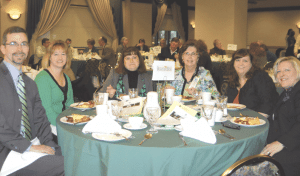
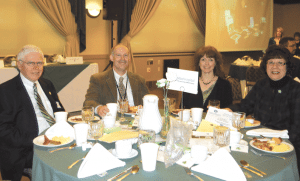
 The Greater Westfield Chamber of Commerce staged its annual St. Patrick’s Day Breakfast on March 16. A number of city officials and state legislators took to the podium, and BusinessWest Editor George O’Brien delivered the keynote address. At top, a delegation from Berkshire Bank takes in the festivities, while below, representatives of Noble Hospital enjoy the day’s events. At bottom, the Westfield Colleen, Meagan Susan Casey (center), enjoys a bite of cake with her court, from left, Meaghan Kwarzinski, Ryan Hickson, Sinead Smith, and Connor Sheehan.
The Greater Westfield Chamber of Commerce staged its annual St. Patrick’s Day Breakfast on March 16. A number of city officials and state legislators took to the podium, and BusinessWest Editor George O’Brien delivered the keynote address. At top, a delegation from Berkshire Bank takes in the festivities, while below, representatives of Noble Hospital enjoy the day’s events. At bottom, the Westfield Colleen, Meagan Susan Casey (center), enjoys a bite of cake with her court, from left, Meaghan Kwarzinski, Ryan Hickson, Sinead Smith, and Connor Sheehan.
Chabot & Burnett Builds on Its Legacy in Masonry Construction

Kristin Capell says that, in many ways, the construction industry is more complex than it used to be, from added paperwork and compliance to safety measures and LEED certification.
“When I got started 16 years ago, my father threw me into it and taught me everything,” she told BusinessWest. “I’d sit in a back room and learn how to estimate masonry. And dad had a grand plan. He and Dan knew when they wanted to retire, because they worked so hard their entire lives.”
Joe Chabot, her father, and Dan Burnett had started the company that bears their name in 1971, when both men were still in their teen years.
“They just did everything together from the start,” said Kristin. “They raced motorcycles, motocross, rode planes, but they were also workaholics, working 12-hour days.”
In an industry dominated by male ownership, Capell said that it is a mark of pride to be at the helm of a construction firm these days, especially one that has erected scores of brick and stone buildings, with project costs totaling in the tens of millions of dollars. But she is quick to point out that, while she is the president, two other partners have joined her in both ownership and leadership, and continue to help lay the foundation for of the area’s premier masonry-construction firms. Jim Carrier, current vice president, and Dan Burnett Jr. are both given equal credit for a business that enters its fifth decade with a rock-solid future before it.
While the economy has hit this niche of the construction sector as hard as every other trade, there have been strong signs of life for this style of structure that is built to last. The brick and stone edifices on college campuses have been a lifeline for this firm, Capell said. “For me in my career, higher education has been about 90% of our projects.”
During that time, the collective wisdom of the men who started the firm helped give Capell and her co-owners a good template for riding out the recession. While this sluggish economy dovetailed with the final days of Chabot and Burnett’s final years of succession, the pair offered advice as solid as a brick wall.
“But in comparison to other recessions, to them, this one was really ugly,” Capell noted. “It was unfortunate that it happened right at the year of their retirement. That big celebration of 40 years just wasn’t as celebratory as we might like.”
She and her partners took over the firm fully in April 2011, and with that lull just behind her, she said 2012 has a good book of work ahead, and that’s generating optimism.
When asked what her predecessors, enjoying their retirement in Florida for the winter, think about this year with $13 million of work on the books, she simply said, “they haven’t once even thought about coming back up to help out. If they were even slightly concerned at all, they would never have left.”
From the Ground Up
Capell said that masonry, and entrepreneurial spirit, were always in her father’s blood.
“My grandfather was a mason tender, and thus my father knew the trade from him,” she explained.
Chabot and Burnett were friends from high school, where they both attended Springfield Tech. Both men had taken jobs with construction firms as teens, and quickly proved themselves to be able masons.
“But they wanted to do it for themselves,” Capell said. “They knew each others’ skills, and they started originally by building chimneys to raise capital and to eventually support their payroll.”
When asked how two 19-year-olds could successfully build themselves a masonry-construction operation, Capell said solid word-of-mouth referrals built the business and enabled it to enjoy steady growth.
“All of the smaller general contractors in this area, Berneche, Fontaine … they just got to know the two from working with them, and took a risk and hired them — and then realized how good they were,” she continued. After one initial job which the two leveraged into a bank loan to create the company, the rest is history.
“There are probably five or six buildings in just about every town around here that we’ve built — from public schools to banks, tons of work at Smith College and Mount Holyoke College. We built most of the dorms at Western New England University.”
Amherst College is the site of many Chabot & Burnett projects, both administrative and residential, including a dormitory built entirely of granite. “For a while right before the recession, in 2006, 2007, it was a building boom. At the college, we just hopped from one building to the next,” she explained.
UMass Amherst has been a source of significant work for the company as well. Over the past decade, Chabot & Burnett has built the North Apartments, a five-story, four-building student residential complex; the Studio Art building designed by Graham Gund; and the first Integrated Science Building.
Looking back — and ahead — Capell acknowledged that the industry has changed from those early days.
“All the paperwork and all the compliance, safety, LEED … this is a totally different landscape from when Chabot and Burnett were building,” she explained. “They could just go out and build a good building.”
Ton of Bricks
Her father and his partner had put into effect a 10-year succession plan for Capell, Carrier, and Burnett Jr. to eventually take over the firm. During that time, the pair were actively involved in all facets of the company — toward the end, during the recession, even helping out with no compensation.
“They went out into the field again, too,” she said. “Here they were, at the age of 65, coming back into the office at the end of the day all scratched up. Anything they could do to help.”
During their own time, the two had seen their own share of economic expansions and deep recessions. And to Capell and her partners, they offered their own strategic advice.
“‘Put your head down,’ they would say,” she remembered. “‘Trim as much as you can while still keeping the business competitively strong.’ And I did. I got rid of cleaning people, kept a small workforce going.
“Also, I bid everything,” she continued. “I was bidding $500 projects. We did some of the tornado work, just to make sure there was a revenue stream continuing. I went after everything. We did go out of our traditional geographic range, taking a $4 million job in Worcester. Big jobs like that were few and far between. We looked at it, I knew where we had to be with numbers, and I knew I had to take something like that on. Maybe we didn’t make as much money as we historically had, back in the good days. But that’s what the recession did to everyone.”
Overall, Capell said, thanks to the lessons and inspiration provided by her father and Burnett, the company has done more than survive the recession. Indeed, it is on fairly solid footing, and with a number of jobs in progress and in the pipeline.
The new Easthampton High School, a LEED-certified structure, is on the books, and UMass Amherst continues to be a solid client; the firm is building the second of the new science buildings, along with the new UMass Honors College dormitories. Much like the expedited timeline of the North Apartments, built in an-unheard of nine months, this one has a ribbon-cutting date of Dec. 1. “And we haven’t started it yet,” she said with a smile.
Sunshine State
Down in Florida, lifelong friends Chabot and Burnett are now part of the company’s proud history, Capell said, and she’s pleased to report that this first full year of their retirement has been blissfully uneventful for them, from a business perspective.
“Since we took over, they have left us alone,” she said — perhaps the best compliment from the founders of a company who were wholly engaged in the business since they were young men.
“If I ever have a question, of course they will be happy to help,” she continued. Otherwise, “they don’t worry too much about what we’re doing here. They have confidence in us. But this will always their baby, and it was emotional for them in their final year to let go.
“They both live near each other down there,” she added. “They play golf and see each other almost every day. They’re still the best of friends.”
For the new leadership team, Capell and her partners take pride in carrying on the legacy created by the two men.
“I am very proud of the reputation we have,” she said. “When we’re hired on a job, they’re happy to have us. That’s right across the board from the architects to construction managers to the other trades. We offer a professional business, getting things done fast.
“My father and Danny’s reputations preceded them, and that is carried over to us now,” she added. “A company knows that, when they hire us, there’s a history of honesty, of standing behind everything we do, and that’s what I’m most proud of.”
How to Reform Community Colleges
The current debate about the future of community colleges is nothing new. Their mission has always been contested.
Some see these open-admission, relatively inexpensive colleges as providing technical training focused on local workforce needs. Others say they provide the first two years of a baccalaureate degree and facilitate transfer to a four-year college or university. Still others see community colleges as providing a variety of non-credit courses and support for students needing to obtain a high-school equivalency degree, or simply advancing their personal or professional interests.
Some — including the Boston Foundation, whose report on community colleges seems to have been the model for the Patrick administration’s recent proposal — think the multiple missions of community colleges are a sign of confusion and inefficiency. Actually, they are the sign that they are doing their jobs.
Community colleges must continue to play their three roles. The question is simply one of balance. But the governor’s recent proposal would tilt the scale the other way, making community colleges little more than publicly funded workforce-training centers for private business. This is as bad for the Commonwealth as it is for community-college students.
A bachelor’s degree not only provides access to higher-paying jobs, but also emphasizes the broad liberal-arts education crucial to helping students deal with living in an increasingly complex global society. Community colleges must continue to play their transfer role while still providing access to immediate career programs. The governor’s emphasis on workplace education short-circuits the many students who aspire to a higher education. Furthermore, it effectively constitutes a tracking system for minority and working-class students, who are concentrated in community colleges.
Rather than throw out the invaluable, multiple missions of community colleges, how about some real reform?
First, we must create a foundation budget for each community college; all are woefully underfunded. Community colleges have traditionally had far less funding than the state universities, and have been hit especially hard by a decade of disinvestment. They do not generally have the capacity to do major fund-raising, recruit higher-paying out-of-state students, or charge the high fees that the UMass institutions do. A starting point would be to raise all community colleges’ budgets up to that of the college with the highest per-student budget.
Second, just as in K-12 education, the most important factor in the quality of education is the faculty hired to teach and do research. This is especially true for community colleges that consistently teach the most racially and ethnically diverse student body in the public higher-education system. This sector of our system deserves to have well-compensated faculty and staff. And yet, the situation is upside down.
Third, community colleges serve huge numbers of students, with a range of needs and interests. The need for support staff — in admissions, mentoring, advising, tutoring, financial aid, counseling, and libraries — is greater than ever. It is precisely these crucial positions that have been eliminated. Staff positions should be hired in proportion to admitting new students and hiring more faculty.
Finally, we must improve the affordability of community colleges so that students can afford to matriculate and are not strapped with debt upon graduation. The explosion of student debt threatens the role public higher education plays in providing a pathway into the middle class. We have to move beyond the ‘high tuition and high aid’ model that Massachusetts has unsuccessfully employed: as tuition and fees have skyrocketed, the state has failed to put money on the aid side of the equation, such that now the average state financial-aid grant covers less than 10% of the total cost of attending a state college.
One of the buzzwords of our politics today is ‘accountability.’ Before asking public colleges and universities, their students, faculty, and staff to do more counting, measuring, and testing, government leaders should be held accountable and provide adequate funding for our institutions to do their jobs. v
Max Page is a professor of Architecture at UMass Amherst and vice president of the Public Higher Education Network of Massachusetts.
‘Music for the Eyes’
Through April 7: The artwork of Preston Trombly, host of Sirius/XM Satellite Radio’s nationally broadcast Symphony Hall channel, titled “Music for the Eyes,” will be exhibited through April 7 at the Arno Maris Gallery in Ely Hall on the Westfield State University campus. Regular gallery hours are Tuesday through Friday from 2 to 5 p.m., Thursday from 2 to 7 p.m., and Saturday from 1 to 5 p.m. For more information, call (413) 572-4400 or visit www.westfield.ma.edu/galleries.
Author Lecture
March 28: Internationally acclaimed author Tom Perrotta will read from his upcoming novel, The Leftovers, at 10:10 a.m. and 11:15 a.m. in Scibelli Hall Theater, as part of the Ovations series at Springfield Technical Community College. The talks are free and open to the public. Two of Perrotta’s books, Election and Little Children, have been made into movies, and five novels have been national bestsellers. For more information, call (413) 755-4233.
ADA, FMLA Workshop
March 29: Royal LLP, in conjunction with the Human Service Forum, will present a workshop at the Delaney House in Holyoke on the compliance issues involving the ADA and FMLA. The interactive workshop addresses some of the most common questions that upper management faces each day. Attendees will learn skills and strategies that can help reduce the risk of employment litigation. For more information on the 8:30 a.m. to noon event, contact Ann-Marie Marcil at (413) 586-2288 or visit www.humanserviceforum.org.
Not Just Business as Usual
April 5: Former NBA player and businessman Ulysses “Junior” Bridgeman will be the guest speaker at the Springfield Technical Community College Foundation’s third annual Not Just Business as Usual event at the Naismith Memorial Basketball Hall of Fame in Springfield. A cocktail and networking reception is planned from 5:30 to 7 p.m., followed by the dinner program from 7 to 9 p.m. Bridgeman spent most of his 12-year NBA career with the Milwaukee Bucks, but also played for the Los Angeles Lakers. He is the current franchise owner of more than 160 Wendy’s and 120 Chili’s restaurants. The event encourages local businesses to come together for an evening to network, learn from one another, and support student success. Funds from the event will provide students access to opportunities through scholarships, technology, and career direction to be successful future employees and citizens. “It’s a time to celebrate innovations, change, and our region’s success,” said STCC Foundation Interim Director Robert LePage. A variety of sponsorship opportunities are available, and individual tickets are $175 each. For more information, contact LePage at (413) 755-4477 or [email protected].
Constitution Café
April 10: Author and philosopher Christopher Phillips’ latest book, Constitution Café, draws on the nation’s rebellious past to incite meaningful change today. He proposes that Americans revise the Constitution every so often, not just to reflect the changing times, but to revive and perpetuate the original revolutionary spirit. He will present a free lecture at 8 p.m. in the dining hall at Blake Student Commons, on the Bay Path College campus, 588 Longmeadow St., Longmeadow. The lecture is part of the annual Kaleidoscope series. For more information, call (413) 565-1000 or visit www.baypath.edu.
Marketing Basics Seminar
April 11: The Mass. Small Business Development Center Network will host a lecture titled “Marketing Basics” from 3 to 5 p.m. at the Greater Northampton Chamber of Commerce, 99 Pleasant St., Northampton. Dianne Doherty of the MSBDC Network will present the workshop that will focus on the basic disciplines of marketing, beginning with research (primary, secondary, qualitative, and quantitative). For more information, call (413) 737-6712 or visit www.msbdc.org/wmass. The cost is $40.
RetireSmart Seminar
April 11: MassMutual’s Retirement Services Division continues its web-based RetireSmart interactive participant education series with “Understanding Target-Date and Target-Risk Investments” at noon. The 30-minute presentation will cover taking charge of your retirement-investing strategy in today’s market environment; the ABCs of target-date and target-risk strategies, and how these investments may fit into your overall plan. Space for the live online seminar is prioritized to retirement-plan sponsors and participants on MassMutual’s platform. MassMutual retirement-plan clients can register by logging into their retirement-plan account at www.retiresmart.com or by visiting www.retiresmartseminars.com.
Slam Poet Lecture
April 13: Taylor Mali, a former high-school teacher who has emerged from the slam-poetry movement as one of its leaders, will discuss his performances at 10:10 a.m. and 11:15 a.m. in Scibelli Hall Theater, as part of the Ovations series at Springfield Technical Community College. The talks are free and open to the public. For more information, call (413) 755-4233.
Christo to Keynote Riverscaping Conference
April 19-22: An international conference on the art, history, and science of the river will feature the celebrated artist Christo, whose latest project will be to install 5.9 miles of fabric over a stretch of the Arkansas River in Colorado. The Five College Riverscaping Conference also includes lectures, gallery openings, student poster sessions, and a two-day symposium opened by Jonathan Lash, Hampshire College’s new president and the former president of the World Resources Institute. The conference marks the conclusion of the 18-month Five College Riverscaping project, funded in large part by a grant from the American delegation to the European Union and in partnership with river experts from Hamburg, Germany. Aimed at developing sustainable approaches to reconnecting people with the river, the Riverscaping effort has brought together students, policy makers, artists, academics, entrepreneurs and environmentalists in a series of ‘laboratories.’ Centered around education, research, and design, the laboratories focus on Massachusetts’ stretch of the Connecticut River and the Elbe River in Hamburg. Christo’s address, at Smith College’s John M. Green Hall, will open the conference on April 19. He will discuss the two current projects that he and Jeanne-Claude (who died in 2009) have initiated: “Over the River” on the Arkansas River and “The Mastaba,” in the United Arab Emirates. The river installation, planned for the summer of 2015, will involve suspending nearly six miles of luminous fabric panels over a 42-mile stretch of the upper Arkansas River in Colorado. The project, while controversial, has received federal and state approval. Lash will open Saturday’s symposium sessions with his comments on “Why the River Matters.” Other highlights of the symposium on Friday and Saturday include papers by a wide range of designers, scientists, and scholars from around the world, including Jinnai Hidenobou of Hosei University in Tokyo, Johan Varekamp of Wesleyan University, and T.S. McMillin of Oberlin College, author of The Meaning of Rivers. A student session takes place on Friday evening, and a performance of music and readings will follow on Saturday. The entire conference, including Christo’s address, is free and open to the public, but online registration is required. Visit www.riverscaping.org for a complete schedule and to register for the Christo address and all the other events.
Comedy Night to
Benefit Charities
April 21: Smith & Wesson Corp. will host a benefit comedy show to support two local children’s charities, the Shriners Hospitals for Children and the Ronald McDonald House, beginning at 6 p.m. at the Cedars Banquet Hall, 419 Island Pond Road, Springfield. Tickets are $30 per person, and include the show, hot and cold hors d’oeuvres prior to the show, a cash bar, raffles, fund-raising, games, and music. Teddie Barrett of Teddie B. Comedy will emcee the event, featuring professional comedians Bill Campbell, Dan Crohn, and Stacy Yannetty Pema. For tickets or more information, contact Phyllis Settembro, Smith & Wesson, (413) 747-3597; Karen Motyka, Shriners Hospital, (413) 787-2032; or Jennifer Putnam, Ronald McDonald House, (413) 794-5683.
‘Adapt, Diversify,
Reinvent & Grow’
May 16: Local business owners will talk about what they have done to keep ahead of the many demands on their time, and at the same time adjust for the economic environment, during a workshop titled “Adapt, Diversify, Reinvent & Grow” at the Scibelli Enterprise Center, 1 Federal St., Springfield. Presenters include Paul DiGrigoli of Digrigoli Salon & School of Cosmetology; Tara Tetreault of Jackson & Connor; Kate Vishnyakov of Kate Gray Inc.; and Rick Ricard of Larien Products. The 9 to 11 a.m. session is sponsored by the Mass. Small Business Development Center Network. The cost is $40. For more information, call (413) 737-6712 or visit www.msbdc.org/wmass.
NYC Bus Trip
June 30: The Chicopee Chamber of Commerce will host a bus trip to New York City, leaving the chamber parking lot at 7 a.m. and returning around 9:30 p.m. Participants are on their own for the day in New York City. Tickets are $45 per person. For more information, contact Lynn at (413) 594-2101.
40 Under Forty
June 21: BusinessWest will present its sixth class of regional rising stars at its annual 40 Under Forty gala at the Log Cabin Banquet & Meeting House in Holyoke. The June 21 gala will feature music, lavish food stations, and introductions of the winners. Tickets are $60 per person, with tables of 10 available. Early registration is advised, as seating is limited. For more information, call (413) 781-8600, ext. 100, or visit www.businesswest.com.
Western Mass.
Business Expo
Oct. 11: BusinessWest will again present the Western Mass. Business Expo. The event, which made its debut last fall at the MassMutual Center in downtown Springfield, will feature more than 180 exhibitors, seminars, special presentations, breakfast and lunch programs, and the year’s most extensive networking opportunity. Comcast Business Class will again be the presenting sponsor of the event. Details, including breakfast and lunch agendas, seminar topics, and featured speakers, will be printed in the pages of BusinessWest over the coming months. For more information or to purchase a booth, call (413) 781-8600, or e-mail [email protected], or visit www.wmbexpo.com.
Insurance Payments for Your Autistic Child
Having a child with autism creates many challenges, not the least of which is the potential financial impact on your family. Until recently, many families were burdened with a mountain of bills when attempting to have their child diagnosed with and treated for disorders within the autism spectrum. But, thanks to a new Massachusetts law, that is changing.
In August 2010, ARICA (an Act Relative to Insurance Coverage for Autism) was signed into law by Gov. Deval Patrick; it became effective on Jan. 1, 2011. This law requires health-insurance companies in Massachusetts to provide coverage with respect to the diagnosis and treatment of autism-spectrum disorders, regardless of the age of the individual afflicted by the disorder.
Despite what many believe, or at least have questioned, ARICA has no impact on the special-education services provided by school districts, as required under the Individuals with Disabilities Act and Massachusetts law.
To clarify, ARICA requires that health insurers provide payment for supplemental services, in addition to services provided by school districts, pursuant to a student’s individualized education plan (IEP). Services covered by ARICA include, but are not limited to, medication, counseling, psychiatric care, psychological care, physical therapy, speech therapy, and occupational therapy.
This law includes several significant factors that are noteworthy:
• Reimbursement cannot be sought for services provided by a school district in furtherance of a child’s IEP;
• School districts are prohibited from requiring that services otherwise provided under the child’s IEP be sought via private health insurance coverage; and
• Potential coverage under ARICA cannot be considered by a child’s IEP team when developing the child’s IEP.
There are, however, several exceptions to coverage under ARICA. For example, self-funded plans that fall under the auspices of ERISA are not required to provide insurance coverage. In addition, individuals who receive health care coverage under MassHealth or CommonHealth are not eligible for the coverage provided by ARICA. In addition, insurers may opt out of required participation if applicable costs to the insurance exceed 1% of its otherwise current costs.
As with any new legislation, the implementation of ARICA has progressed, and will evolve, in fits and starts as interested parties educate themselves and others with respect to the practical application of the law.
For example, health-insurance companies that fall under the requirements of ARICA may require a copy of the child’s IEP prior to making coverage decisions. As such, it is very important that the parents of a child covered by ARICA proactively inform the school district that all requests for their child’s IEP be directed to themselves as the parent of guardian. Remember that Massachusetts law prevents school districts from disseminating information relative to a child’s IEP to a private health-insurance provider without the parent or guardian’s informed, prior written consent.
As with any change, especially one of this magnitude, the key to successful transition is communication. You should contact your child’s school district to ensure that it is aware of the provisions of ARICA, as well as its effect on the services that the district provides. This discussion should include such issues as what policies the district has in place to ensure that your child’s confidential information is not shared with insurers without your written consent, as well as a review of the district’s continuing education of staff and administrators relative to ARICA. Parents may also request literature from the school district in order to ensure that the district has written procedures in place to ensure proper application of ARICA.
With your child’s best interests in mind, it is important to reach out to his doctors and therapists to discuss this new law and the impact that it has on services provided, both pursuant to your child’s IEP and privately. It is important that any services provided to your child by a doctor or therapist be properly coded when billed to avoid confusion, which can ultimately lead to additional costs and/or delays.
Communication with your health-insurance company is crucial — first, to confirm that the provisions of ARICA apply to your health insurer, and, second, to ensure that covered services are provided and billed appropriately. In addition, any questions with respect to co-pays and out-of- pocket expenses are best addressed prior to receipt of services.
Informing your insurer proactively that your child receives services that fall within the scope of ARICA, and requesting written information with respect to its compliance with ARICA, will reduce the likelihood that billing questions and issues arise. As with any issue, proper documentation of any and all services provided will assist in resolving any potential issues in a timely manner.
Luckily, a number of quality resources are available for those who have questions related to ARICA. The Commonwealth of Massachusetts Division of Insurance has published guidance with respect to ARICA, and many autism advocacy and support groups have held and continue to hold informational workshops.
If you need legal assistance when wading through the waters of autism-disorder diagnosis and treatment payments, make sure you consult with a qualified special-education attorney. n
Melissa R. Gillis, Esq. is an attorney with Bacon Wilson, P.C. in the special-education, domestic, and real-estate departments; (413) 781-0560; baconwilson.com/attorneys/gillis. Dennis G. Egan Jr., Esq. is an attorney with Bacon Wilson, P.C., concentrating in special education, business, and corporate law; (413) 781-0560; baconwilson.com/attorneys/egan
New OSHA Compliance Rules for Employers Are on the Way
After years of deliberation, the U.S. Occupational Safety and Health Administration (OSHA) will soon release a rule requiring employers to develop a written injury and illness prevention program (IIPP). This requirement, already in place in several states, is a proactive measure designed to help employers find and fix hazards in the workplace.The rule is also likely to include additional requirements, such as developing a system for communicating with employees and conducting employee trainings.
OSHA is the federal agency that administers the Occupational Safety and Health Act. OSHA’s duty is to ensure that workplaces are safe and free of hazards. To that end, it prescribes safety regulations and engages in site investigations. While these efforts have largely been remedial in nature, OSHA’s new rule represents a significant step toward preventative regulation.
Generally, IIPP programs require employers to develop, communicate, and carry out workplace injury-prevention plans. More than a dozen states have adopted such programs, including, most notably, California. Thirty-four states either require or encourage employers to adopt IIPPs (15 require them), and many large organizations have voluntarily done so. OSHA has identified six elements crucial to any IIPP program:
• Management leadership;
• Worker participation;
• Hazard identification and assessment;
• Hazard prevention and control;
• Education and training; and
• Program evaluation and improvement.
OSHA has not yet released a draft of its IIPP program, but it is likely that the federal program will resemble California’s influential program, first instituted in 1991. That state’s IIPP initiative requires that plans be in writing and satisfy the seven following criteria:
• Accountability (identifying the person(s) responsible for administering the program);
• Compliance (creating a system that recognizes compliant employees and requires regular training and retraining);
• Communication (ensuring employee awareness of the IIPP and developing a system for communicating with employees that informs them of their right to complain without fear of reprisal);
• Identification (identifying and evaluating workplace hazards, including scheduled periodic inspections);
• Investigation (implementing a procedure to investigate occupational injury or occupational illness);
• Methodology (developing methods and/or procedures for correcting unsafe or unhealthy conditions); and
• Instruction (providing training and instruction at specified times).
California’s law also contains exceptions for small employers. Businesses with fewer than 10 employees can satisfy the communication requirement by orally informing employees about potential hazards, and businesses with fewer than 20 employees are exempt from certain documentation requirements.
California’s IIPP plan also contemplates, but does not require, the establishment of a labor/management health and safety committee. If California employers have a labor/management committee that meets often enough and satisfies certain requirements, this satisfies the employer’s communication requirement. OSHA’s rule could include a similar provision, or mandate the creation of such a committee.
What will this rule mean for your business? If you don’t already have an IIPP, developing one will certainly cost time and money. But, despite these short-term costs, OSHA anticipates that the rule will produce savings in the long run. A study cited in a January 2012 OSHA white paper indicates that IIPP programs have consistently increased productivity, reduced costs, and improved both employee retention and morale.
The effect of OSHA’s proposed rule on small businesses deserves special note. This new requirement will be yet another legal hoop for small-business owners to leap through. However, as explained in the OSHA white paper noted above, the rule will likely be procedural and not mandate specific, quantifiable results. Therefore, small businesses must only develop a plan suited to meet the needs of their specific workplaces (which may be relatively simple).
Small businesses should also be aware of the effect of the Small Business Regulatory Enforcement Fairness Act (SBREFA). This law affords small businesses greater input into the regulatory process and eases the burden of enforcement and administrative penalties on small businesses.
When a proposed OSHA rule (such as this one) is expected to have a significant impact on small entities, OSHA initiates a consultation process with the Small Business Administration. A review panel is convened and considers comments from industry representatives. After this meeting, a written report is prepared and submitted to OSHA within 60 days. OSHA then reviews the report, incorporates suggestions, and publishes the rule in the Federal Register for public comment. OSHA’s IIPP rule will undergo this process shortly (it was delayed late last month).
Businesses will be able to weigh in on the IIPP rule. Small businesses may contact the U.S. Small Business Administration’s small-business ombudsman at (888) REG-FAIR in anticipation of, or during, the SBREFA review process. And once this process is complete and a final version of the rule is published in the Federal Register, any business (or interested member of the public) may submit written comments to OSHA during the rule’s notice and comment period.
OSHA has been pushing for a federal IIPP requirement for years, and it will likely be here before we know it. Businesses both small and large now have opportunities to offer their thoughts on the rule and to plan for what a written IIPP plan will mean for their organizations.
Daniel W. Morton-Bentley, Esq. specializes exclusively in management-side labor and employment law at Royal LLP, a woman-owned, boutique, management-side labor and employment law firm; (413) 586-2288; [email protected]
Mobile Web Sites Provide Information Via a Simple Touch
Blair Winans gets many requests from business owners who tell him they want their Web site turned into an app.“I ask them whether they really need an app or whether they just need a mobile Web site,” said the principal and creative director of Winans Creative in Easthampton, which specializes in Web site design and development.
Technology is moving so quickly that, although many people are familiar with these terms, they don’t understand the real differences between them and what they can accomplish, Winans told BusinessWest. They also don’t know what makes sense for their business in terms of the cost/benefit ratio.
“Apps have become a buzzword,” he explained, “But there is a lot that goes into figuring out what someone needs, and it all comes down to functionality.”
Apps cost $20,000 or more to develop, and once they are in use, they are not easy to change. In addition, they must be approved by the iTunes store, then downloaded by people who want to use them, which makes them inappropriate for most small businesses. An idea is viable only if a company wants to provide a service that will become unique to its brand.
For example, a business might want to provide video tutorials that can be accessed via a mobile device, or a real-estate agency might want people to be able to see all their listings on a phone or tablet, Winans said. But many of these things can be accomplished via a mobile-optimized Web site, which is much more cost-effective than an app.
“You really need a high-level strategy to justify an app. Unless you have a revolutionary idea of how to connect with customers, it may not be worth the investment,” said Winans. “There are a million useless apps in the App Store, and if you can’t effectively answer the question, ‘why would someone download this?’ it is pointless to think about developing one.”
Rachael Frank concurs. “Unless your business is the size of Bank of America or Amazon, you probably cannot afford an app that will provide a return on your investment,” said the lead strategist for Gravity Switch in Northampton, which focuses on specialized technology development.
Still, most businesses have fallen behind the times in terms of keeping their Web sites updated, and could profit from technological advances.
“The whole world is playing catchup as Web development and technology has advanced so far in the last five years,” Winans said. “Ninety-nine percent of Web sites are not formatted for phones, and most people are still trying to get their Web site up to 2012 standards.”
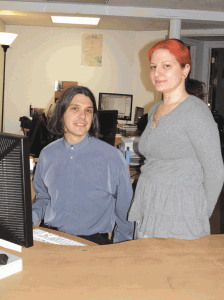
Rachael Frank and Rob Archer say creating an effective Web site is not something that can be done once and left alone.
This occurs frequently because most Web sites were built to be viewed on a desktop computer or laptop with a full-size screen. “A Web site built for a desktop assumes that people have the height and width on their screen that make it easy for them to see everything,” Winans said. There is also information that can be accessed using a computer mouse that will not work with the touch of a thumb, such as a drop-down menu.
“Traditional Web sites can be cumbersome for people using mobile devices,” he continued. “If they are not formatted for mobile users, the bounce rate of people who visit them, then leave quickly, is high,” Winans said, explaining that the term ‘bounce rate’ refers to the speed at which people leave a site that is not user-friendly.
Options Galore
Mobile Web sites can be formatted so that the information people are searching for is literally at their fingertips. “You want to create a layout that gives people a friendly experience when they visit across multiple platforms,” Winans said.
The first step is to determine what mobile users who call up a site are looking for. For most businesses, this is their phone number and address. “If people are looking for a restaurant on a mobile device, they probably don’t care about your history or where your chef trained,” Frank said. “They want your menu, but they want to be able to view it in a way that can be seen well on a mobile device. And this not a PDF, which is for printing purposes.”
That format does work well for people on a desktop computer, Archer said. “But you need to provide multiple solutions and have a responsive design that looks good on a 3- by 5-inch screen as well as a 7-inch tablet.”
Frank told BusinessWest that a mobile site is a separate entity from a traditional site and, therefore, requires a different form of navigation.
“A responsive design will automatically adapt to the size of a mobile device and do things like load a smaller picture or change a layout,” she explained. “This technology has been built upon for the last 10 years.”
And providing this platform can make the difference between keeping or losing a prospective client.
“If you’re pulling in a lot of business from outside of your area, it is important for someone on a mobile device to have the ability to check your hours of operation,” Frank said. “If they can’t get the information instantly or access directions easily, they are likely to go somewhere else. You want to make it easy for people.”
Archer provided another example. If someone is walking around Northampton and knows the name of a restaurant but has no idea where it is located, he explained, that information needs to be easy to find on their smartphone.
Winans agrees, and says design is critical to making a site user-friendly. “Since a phone is small, you want to have big buttons to show specialized content,” he said, adding that a mobile site can be linked directly to Google Maps. “People on mobile devices are usually trying to find several pieces of information quickly, and a mobile site can provide a different layout and change their experience.”
Tuneups
Archer says the maintenance required on a Web site can be compared to the work necessary to keep up a home’s lawn or garden.
“If you let a backyard go, it will end up with weeds and molehills,” he explained. “You need to cut the grass, water it, and make changes according to the weather conditions. And, like the weather, the technology landscape is continually changing, so your business needs to change along with it to keep up with the times.
“A Web site is often the first impression people have of your business,” he continued, “so when they see it on a mobile device, it had better look good and work well.”
Archer advises business owners who have the ability to make changes to their site to make sure the Google Analytics program is turned on. Last June, a new feature was introduced that shows the breakdown between mobile and non-mobile visitor activity on a Web site, including what type of device people used to access it.
Even if the numbers of mobile users are small, they are bound to increase. According to a report by eMarketer, half of the U.S. population will be using mobile devices, rather than computers, to access the Internet in 2015.
“The days of instant gratification are upon us, and it’s not enough to simply have a Web site or application. You need to be able to deliver content to anyone, anywhere, on any device,” Winans said.
He told BusinessWest that creating a mobile-optimized site from an existing Web site is not expensive. “It can be done for under $1,000 using a standard design,” he said. “And a large portion of businesses could definitely benefit from simple upgrades to their Web site. They can make a big difference.”
A mobile site can also serve as a starting point for a business that is considering an app. “You don’t need to jump into everything head first. There are definitely varying levels and ways of approaching it to minimize the up-front investment,” Winans said.
But building on a Web site requires a solid foundation.
“A lot of people can’t even change the content on their home page,” he noted, adding that he advises people to make sure their site has been built using a framework that can be expanded.
“If you have a good content-management system, it will allow you keep building rather than tearing down the structure each time you want to change something,” he continued, adding that some businesses may eventually want to add options such as e-commerce or video blogging.
Unfinished Business
Frank reiterated the fact that many small businesses have lagged behind the times. “They haven’t assumed their Web presence is important enough to develop,” she said. “But they need to build it and let it grow.”
Archer agrees. “Technology continues to grow, and we don’t know what is coming next,” he said.
So, although the future is unknown, experts say businesses need to make their products and services available in a way that shows they care. And right now, that means extending a friendly hand — or, rather, a design made for a thumb.
Continuing the Search for Answers
State Rep. Jim McGovern hit the nail on the head — repeatedly.
In his comments to attendees at a recent symposium titled “Digital Games: Playing in the Valley” (see story, page 17), he said that few industries “can project the growth characteristics of the game industry.” And he’s right. He then said that, to get the regional economy back on its feet, video games comprise “one of the answers.” Right again.
And notice the use of the plural, because it’s important.
Indeed, there are still many people in this region looking for the answer, or the next big thing. After decades of searching, one would think that they would know by now that there isn’t one answer to this region’s problems when it comes to vibrancy, job creation, and overall reinvention from its days as a manufacturing hub. And there won’t be one big thing, either.
It must be many things, or many answers. Which brings us back to the symposium at Hampshire College earlier this month. It was there that speaker after speaker — from college professors to elected officials like McGovern to people like Allan Blair, president of the Western Mass. Economic Development Council — talked about how this region could be a hub for video-game-related businesses, and how it should be.
Not all, but most of the active ingredients are there to make this happen, the various speakers said, listing everything from cost of living to a critical mass of young college students, to a quality of life sought by the younger generations. The challenge, they said, is to foster this young, still-growing industry, and to overcome the hurdles, such as the lack of a solid reputation in this industry and also the incomprehensible lack of high-speed Internet access in some of the more remote but still-desirable areas of this region.
The day’s events and speeches could be summed up as a call to action, an effort to raise awareness when it comes to the job potential of a still-misunderstood subsector of the economy, and an attempt to rally the necessary support to convert something that most consider a longshot into something doable.
We need more events like this in Western Mass. because we need to tap a number of wells when it comes to innovation and job creation, in fields like video games, green energy, the biosciences, medical-instrument manufacturing, and more.
The first step is to acknowledge and understand the full potential of some of these emerging industries or clusters — and many speakers admitted that they hadn’t previously had such an appreciation of the video-game sector — and then to be carefully aggressive in creating an environment in which such ventures can thrive.
‘Carefully aggressive’ might sound like an oxymoron, but it’s not. Cities, regions, and states must indeed be aggressive when it comes to supporting potential jobs — Rhode Island was when it gave former Red Sox pitcher Curt Schilling’s video-game business, 38 Studios, a $75 million loan to get to the next level in the Ocean State — but they must also be prudent. Massachusetts learned the lesson the hard way when it gave huge incentives to Evergreen Solar, not understanding that market forces would soon drive production of such systems overseas.
No one could have imagined 30 years ago that video games would be a course of study in college and a source of many thousands of jobs worldwide. Likewise, no one knows what we’ll be saying these same things about 30 years from now.
What we do know is that the region must be diligent in its search for answers — in the plural — because it will take many of them to create the solid jobs our communities will need moving forward.
The following building permits were issued during the months of February and March 2012.
AGAWAM
Berkshire Power
36 Moylan Lane
$20,000 — Convert warehouse to locker room
Six Flags New England
1623 Main St.
$200,000 — Frame new entry to Big Ben’s building
William Deveno
45 Vassar Road
$15,000 — Office renovations
AMHERST
150 Fearing St., LLC
150 Fearing St.
$4,500 — Sub-divide office space
Amherst College
Converse Hall
$36,000 — New flooring
Amherst College
Frosting Library
$149,000 — Addition of café on first floor of library
Carex LLC
15 Research Dr.
$112,000 — Finish office in existing space
CHICOPEE
200 Tillary, LLC
165 Front St.
$17,500 — Renovations for a bathroom and utility room
Anaber LLC
720 Memorial Dr.
$28,000 – Strip and re-roof
City of Chicopee
115 Baskin Dr.
$447,000 — Roof replacement and masonry repairs at the D.P.W.
City of Chicopee
5 West Main St.
$804,000 — Demolish former Facemate buildings
Hershal, LLC
600 Memorial Dr.
$100,000 — First-floor lobby renovation and addition of fitness center and boardroom
EASTHAMPTON
Anup Sangar
29 Union St.
$4,000 — Minor renovations of existing space
Easthampton Savings Bank
241 Northampton St.
$5,841,000 — New three-story commercial bank
Mt. Tom Development
311 East St.
$63,000 — Complete interior of building
EAST LONGMEADOW
Riv Serrazina
382 North Main St.
$64,000 — New roof
HOLYOKE
Elmwood Towers Associate
485 South St.
$250,000 — Install new equipment building
Gail M. Sullivan
77 Locust St.
$6,000 — Install new roof at restaurant
Holyoke Hospital Inc.
6 Isabella St.
$12,000 — New roof
South Holyoke Apartments
529 South Bridge St.
$30,000 — Install new roof
LUDLOW
American Tower Corporation
31 Ravenwood Dr.
$15,000 — Cell tower antennas
David Lavoie
733 Chapin St.
$46,000 — Re-shingle roof
Lavoie Properties, LLC
394-402 Chapin St.
$1,500 — Replace doors
NORTHAMPTON
Atwood Drive LLC
8 Atwood Dr.
$3,070,000 – Construct 40,000-square-foot medical office building
Bally Bunion Realty, LLC
108 Main St.
$3,000 — Remove non-load bearing partitions
Frank Fournier III Trustee
376 Easthampton Road
$5,000 — Move stairs
James H. Graham
20 Ladd Ave.
$20,000 — Construct two walls in shop area
Service Properties Inc.
78 Conz St.
$15,000 — New roof
Smith College
30 Belmont Ave.
$95,000 — Office renovations on first and second floors
Smith College
102 Lower College Lane
$10,000 — Remove open stairway
SOUTH HADLEY
Mount Holyoke College
50 College St.
$7,000 — HVAC renovation
SPRINGFIELD
3 Pointer, LLC
643-649 Main St.
$45,000 — Interior renovations
1350 Main Street, LLC
1350 Main St.
$23,000 — Interior renovation to combine two suites
City of Springfield
36 Court St.
$120,000 — Interior finishes and removal of wall on the fourth floor
Cottage Hill Church
315 Cottage St.
$129,000 — Roof replacement
Helen & Joe Nowak
537 Main St.
$13,000 — Remodel existing restaurant
Hispanic Resources Inc.
364-366 Main St.
$6,500 — Renovations
State Street N.E. Development, LLC
1525 State St.
$464,000 — Renovate 12,566-square-feet for new retail tenant space
WEST SPRINGFIELD
Baystate Health
40 Daggett Dr.
$12,000 — Renovate 892-square-feet of space for a doctor’s office
Dick Harty
1501 Elm St.
$2,000 — Renovate existing commercial kitchen
H & P Realty LLC
218 Memorial Dr.
$80,000 — Strip and re-roof
Paul Longtin
1268 Riverdale St.
$50,000 — Renovate exterior of restaurant
Artist’s Work Brings Heavy Metal to Downtown Springfield
It’s called “Linear and Out the Other.”That name says a little about the large piece of sculpture — a collection of interconnected discarded metal parts, tools, and kitchenware ranging from gears to springs to an old egg beater — but much more about the artist.
Indeed, James Kitchen is a devotee of puns — each one worse than the next — as well as a lover of history and a fervent collector of such old junk, or what he tells his supporting wife is “inventory.”
And he names his pieces after what he sees in them, and imagines what others might see as well. There’s a horse-like creation titled “Why the Long Face?” A large-beaked, bird-like image that looks somewhat like a pelican, but not entirely, is called “Pelican’t.” Then, there’s what looks like a bouquet of flowers fashioned from pitchfork tines with large metal nuts welded onto the sharp ends. The name? Get ready to groan … “Steel Life.”
“I’ve learned that humor is your most important weapon in life — it ultimately gets you through most things,” Kitchen explained while discussing the whimsical titles. “A lot of the time, I make something, and then the name usually just happens. What I’ve found is that, if I don’t put a name on something, people are more prone to say, ‘I don’t get it, what is it?’ If I do, then they understand.”
As he looks at “Linear and Out the Other,” which he described as “busy and intense,” and has pieces welded in a grid-like fashion, Kitchen says he can see everything from “Springfield politics,” to a road map; from something exemplifying molecular science to the connections he’s made in the city since arriving on the scene a few months ago.
“I’m a voracious reader, and I’ve read about quantum physics,” he explained. “When you think about [Danish physicist] Niels Bohr, and how he and others talked about how everything’s random, and multiverses, and string theory … I made this thinking about all the interconnectedness of things, the entanglements. Life is like that; downtown Springfield is like that, with all the connections I’ve made.”
The curious can judge for themselves by visiting the main lobby at 1550 Main St. in downtown Springfield, where about 50 of Kitchen’s pieces of various sizes are on display (and for sale in a partnership with WGBY to help raise money for the public television station) as part of a three-phase initiative that is about much more than art — although that’s a big part of it.
It’s also about Springfield, its history, especially a proud manufacturing heritage, and about celebrating the city’s downtown and ongoing efforts to revitalize it. And it’s about using art to bring people — and attention — to the central business district.
This unofficial mission brings Kitchen to the German word denkmal. He heard it while in Austria in reference to the sculptures he saw on nearly every street corner — “I thought to myself, ‘this is how society should be.’” The literal definition of the word is ‘monument,’ or ‘memorial,’ but Kitchen says he’s heard it broken down to create a different meaning.
He said he’s been told that ‘denk’ means to think, and ‘mal’ means ‘for a minute.’ Add it up, and you get ‘think for a moment,’ which is what he wants people to do with his art — but also with downtown Springfield.
And while thinking, he wants people to appreciate the architecture, the green spaces, and the growing sense of energy he’s sensing during what have become twice-weekly visits to the city from his studios in Chesterfield.
Kitchen’s art will soon be gracing a number of buildings and landmarks in the downtown area (phases two and three), from the fountain in front of 1350 Main St. to some of the open spaces on or near Main Street, to the headquarters of WGBY. In the meantime, he’ll become more of a fixture himself, becoming the most visible personification of an effort to use art as an economic-development strategy.
For this issue, BusinessWest talks with Kitchen about his works — and his work to put art and downtown Springfield in the spotlight.
Portrait of the Artist
As he talked with BusinessWest about his work, Kitchen summoned a phrase he’s used often with the media over the years.
“It’s like doing a jigsaw puzzle without a box … you have to listen to the parts and pieces, and they often come together in ways you wouldn’t necessarily think at the beginning,” he said of his sculptures. “You take this cold, lifeless metal, and you animate it and give it a personality.”
Kitchen’s work falls into the genre known as ‘found art,’ or works created from objects, sometimes modified in one way or another, that are not normally considered art. In his case, what’s found are discarded metal parts, tools, and utensils, usually rusted out, the condition he favors due to the reddish/brown color.
He’s discovered such items at auctions and in basements, attics, barns, junkyards, and other locales. “I’m on a first-name basis with the people who work in recycling facilities,” he explained, adding that he always has a large pile of this inventory at his studio.
The components in his works range from automotive brake cylinders (often used as bases for the sculptures because of their size, shape, and weight) to shovels and rakes of all shapes and dimensions, to something common in his home state of Wisconsin, but not so much here — stanchions used in the process of milking cows. Often, what results is what he called a “where’s Waldo effect,” as people young and old search for and find things they recognize.
When asked when and why he started creating items like “Steel Life,” Kitchen flashed back to a vacation on the Maine coast many years ago, a much-needed break from his pressure-packed job in book publishing.
“I was in the book-production part, and that’s a very stressful job,” he explained. “That’s because everybody would be late — the writer would be late, the artist would be late, but it was my job to get a book out on a certain date; that date would be looming, and you’re trying to get people to focus — that’s where all the stress comes from.”
While at the beach, Kitchen started to take some of the many rocks strewn about at low tide and fashion them into vertical sculptures. The assorted works caught the attention of one passerby, an art teacher from New York State, who, said Kitchen, changed his life by asking the simple question “who’s the artist?”
Fast-forwarding a little, Kitchen said the moment provided an epiphany that compelled him to eventually ditch book publishing for found art, starting out with “something created from an old frying pan that wasn’t very good.”
Over the past 15 years, though, he’s obviously improved, as evidenced by the fact that his works, including the massive, 3,000-pound “Saturn,” have been displayed at venues ranging from Smith College to the Springfield Museums to the lawn of the Hampshire County Courthouse, and also sold at a number of art shows.
It was while displaying at one of these shows, the Paradise City Arts Festival in Northampton, that Kitchen made the acquaintance of Evan Plotkin, president of NAI Plotkin and an ardent supporter of efforts to revitalize downtown Springfield through the power of art, and started discussing possibilities for making the City of Homes, or at least its downtown area, a gallery for his work.
Heavy Metal
There’s an office of the Internal Revenue Service on the ground floor of 1550 Main St., and visitors to that facility comprise a good share of the audience viewing Kitchen’s work to date.
“It’s a tough crowd,” he joked, noting that many visiting the IRS are not in a good mood before, during, or after conducting business.
Still, many are prompting him to make use of that term denkmal. “They’re stopping, looking, and thinking for a moment,” said Kitchen.
And they’re doing so while taking in such works as “The Universe,” the largest of the pieces on display in the building at more than 800 pounds. Explaining the work and its name, Kitchen said the collection of parts, including a 150-year-old, star-shaped seeder, invokes (to him, anyway) thoughts of time, energy, and even the Big Bang Theory — hence the title.
There’s also a vertical, cubist-like piece he calls “Picasso Walking to Work.” Why? “Because when I look at it, that’s what I see — Picasso walking to work in the morning.”
And then, there’s “Salvador Dali’s Toolbox,” an actual metal toolbox filled with real, but very oddly shaped and designed, tools, many a century or more old, by Kitchen’s estimation. Explaining the work and the name is made more difficult, he said, because not many inquirers seem to know much, if anything, about Dali.
As he discussed the toolbox and other works, Kitchen gestured to his pickup truck parked on Main Street. In the back was a six-foot-high prototype of another bird-like sculpture (there are many in the portfolio) that will reach a height of 30 feet and, according to current plans, be erected near the fountain at 1350 Main St.
This is a big part of phase 2 of this endeavor, which involves larger pieces and a broader presence across downtown. Kitchen is currently working with Plotkin, Springfield Business Improvement District Executive Director Don Courtemanche, and others to establish venues for his work. Phase 3, meanwhile, involves the incorporation of some of Springfield’s manufacturing history in his creations.

James Kitchen’s creation called ‘The Universe’ is the largest on display at 1550 Main St. in Springfield.
And while taking in the art, Kitchen and others involved with this initiative hope that people will also take in downtown Springfield, and perhaps see it in a different light — beyond the new art — which Kitchen already does.
“Six months ago, if I had talked about Springfield, I would have given you a completely different story,” he told BusinessWest. “As you watch the news, you get this sense of Northampton as this art town, and Springfield, well, that’s the place somebody got killed — that’s the sense you get. But now that I’ve been down here … what a wonderful city. I don’t think the news really portrays the excitement and the many things that are going on here.”
Meanwhile, he says being in downtown Springfield (as opposed to ultra-rural Chesterfield) is influencing his work.
“I’m building things taller,” he said, noting that he’s being influenced by neighboring office towers. “The bird will be 30 feet tall, and other pieces I’m planning will be pretty big. I’ll be up on a ladder, which is pretty daunting.”
All’s Weld That Ends Weld
Kitchen, who said his favorite piece is “always the last one that I make,” told BusinessWest that the prices on his creations vary, from a few hundred to several thousand dollars. Size has something to do with the figure sought, but bigger factors are the amounts of time and energy spent on a piece.
“And half of my time is spent out finding this stuff,” he continued. “Most of the time you’re getting it from some farmer who lived through the Great Depression and never threw anything away.”
Thus far, the works are doing what Kitchen intended — they’re getting people to stop and think, “which is what an artist does, really.”
Whether his found art can get people to stop, think, and perhaps better-appreciate downtown Springfield remains to be seen, but he certainly has a steely resolve — and in more ways than one.
George O’Brien can be reached at [email protected]
‘Music for the Eyes’ Exhibition, Reception
Through April 7: The artwork of Preston Trombly, host of Sirius/XM Satellite Radio’s nationally broadcast Symphony Hall channel, titled “Music for the Eyes,” will be exhibited through April 7 at the Arno Maris Gallery in Ely Hall on the Westfield State University campus. An artist reception at the gallery is planned for Feb. 29 from 5:30 to 8 p.m. On March 7 at 9:30 a.m., Trombly will present a lecture on his work at the gallery titled “Confluence of Creativity: Similarities Between Composing Music and Making Visual Art.” Regular gallery hours are Tuesday through Friday from 2 to 5 p.m., Thursday from 2 to 7 p.m., and Saturday from 1 to 5 p.m. For more information, call (413) 572-4400 or visit www.westfield.ma.edu/galleries.
Women in Philanthropy Conference
March 13: Women in Philanthropy of Western Mass. will host a conference titled “Growing Philanthropy, New Visions, New Voices,” from 8 a.m. to 4 p.m. at the MassMutual Center, 1277 Main St., Springfield. The event features nationally known leaders in the field of fund development, and is appropriate for women and men who are seasoned professionals or newcomers to the field. Workshops will be led by Penelope Burk, author of Donor-Centered Fundraising; Phil Cubeta, chair in Philanthropy of the American College; and Karen Osborne, president of the Osborne Group. The keynote address, titled “New Leadership for a New Nonprofit Sector,” will be presented by Rosetta Thurman. In addition, sessions will be led by Diana McLain Smith, chief transformation officer of New Profit Inc.; Kristin Leutz and Katie Allan Zobel of the Community Foundation of Western Mass.; Phyllis Williams-Thompson of the Prematurity Campaign of the March of Dimes; Deborah Koch, director of grants at Springfield Technical Community College; Dennis Bidwell of Bidwell Advisors; and Joe Waters and Joanna MacDonald, co-authors of Cause Marketing for Dummies. For more conference details, visit www.wipwm.com. The cost of the conference, with an early discount, is $140. For more information, contact Carol Constant at (413) 222-1761 or [email protected].
Economics Conference
March 13: The Department of Economics at Western New England University in Springfield will host its ninth annual Jolicoeur Economics Conference from 9:30 a.m. to 12:20 p.m. in Sleith Hall Auditorium. “Economics of the 2012 Election” will be the topic of the event, which is free and open to the public. The conference will feature two sessions: “The Economy and the Great Recession,” from 9:30 to 10:20 a.m., and “The 99% and the 1%,” from 11 a.m. to 12:20 p.m. For more information, visit www.wne.edu.
Financing Your Business
March 16: The Mass. Small Business Development Center Network will host a lecture titled “Financing Your Business” from 9 to 11 a.m. at the Scibelli Enterprise Center, 1 Federal St., Springfield. Speakers will include Ray Milano of the U.S. Small Business Administration, Gary Besser of First Niagara Bank, and Christopher Sikes, director of Common Capital Inc. Topics include what lenders are looking for, SBA loan programs, new SBA programs, and venture capital and grants. For more information, call (413) 737-6712 or visit www.msbdc.org/wmass. The cost is $40.
Pioneer Valley USO Gala
March 16: The Log Cabin on Easthampton Road in Holyoke will be the setting for the second annual dinner-dance gala of the Pioneer Valley USO. The featured speaker will be American Captain Richard Phillips, who offered himself as a hostage to save his crew from Somali pirates and was freed in a high-seas rescue by U.S. Navy SEALS. The gala theme will be “Proud to be an American.” A cocktail hour at 6 p.m. will be followed by the dinner program at 7. Heroes from each branch of the U.S. Armed Forces and top Pioneer Valley USO supporters will be honored. The Western Massachusetts All Stars Band, led by Joe Pereira, will provide the evening’s entertainment. Tickets are $45 per person and are available online at www.pioneervalleyuso.org or by calling (413) 557-3290. Tickets are limited. The mission of the Pioneer Valley USO is to “lift the spirits of America’s troops and their families.”
Difference Makers
March 22: BusinessWest will stage its Fourth Annual Difference Makers Celebration at the Log Cabin Banquet & Meeting House in Holyoke. The program recognizes area individuals and organizations that are truly making a difference in this region. This year’s honorees are:
• Donald and Charlie D’Amour, chairman/CEO and president/COO, respectively, of Big Y Foods;
• William Messner, president of Holyoke Community College;
• Majors Tom and Linda-Jo Perks, officers with the Springfield Corps of the Salvation Army;
• Bob Schwarz, executive vice president of Peter Pan Bus Lines; and
• The Women’s Fund of Western Massachusetts.
The awards ceremony will feature entertainment, butlered hors d’ oeuvres, and introductions of the winners. Tickets are $55 per person, with tables of 10 available. For more information or to order tickets, call (413) 781-8600, e-mail [email protected], or visit www.businesswest.com.
Women’s Leadership Conference
March 23: Keynote speakers Sister Helen Prejean, Marjora Carter, and Ashley Judd will share personal stories, as well as insightful advice and perspectives, during Bay Path College’s annual event at the MassMutual Center in downtown Springfield. The theme for the 7:30 a.m. to 4:30 p.m. event is “Lead with Compassion.” Prejean is a member of the Sisters of St. Joseph of Medaille and an anti-death penalty activist, while Carter, an eco-entrepreneur, is president of the Majora Carter Group, and Judd is a film and stage actor and human-rights activist. For more information on the conference or to register, visit www.baypathconference.com or call Briana Sitler, director of special programs, at (413) 565-1066.
Author Lecture
March 28: Internationally acclaimed author Tom Perrotta will read from his upcoming novel, The Leftovers, at 10:10 a.m. and 11:15 a.m. in Scibelli Hall Theater, as part of the Ovations series at Springfield Technical Community College. The talks are free and open to the public. Two of Perrotta’s books, Election and Little Children, have been made into movies, and five novels have been national bestsellers. For more information, call (413) 755-4233.
ADA, FMLA Workshop
March 29: Royal LLP, in conjunction with the Human Service Forum, will present a workshop at the Delaney House in Holyoke on the compliance issues involving the ADA and FMLA. The interactive workshop addresses some of the most common questions that upper management faces each day. Attendees will learn skills and strategies that can help reduce the risk of employment litigation. For more information on the 8:30 a.m. to noon event, contact Ann-Marie Marcil at (413) 586-2288 or visit www.humanserviceforum.org.
Not Just Business as Usual
April 5: Former NBA player and businessman Ulysses “Junior” Bridgeman will be the guest speaker at the Springfield Technical Community College Foundation’s third annual Not Just Business as Usual event at the Naismith Memorial Basketball Hall of Fame in Springfield. A cocktail and networking reception is planned from 5:30 to 7 p.m., followed by the dinner program from 7 to 9 p.m. Bridgeman spent most of his 12-year NBA career with the Milwaukee Bucks, but also played for the Los Angeles Lakers. He is the current franchise owner of more than 160 Wendy’s and 120 Chili’s restaurants. The event encourages local businesses to come together for an evening to network, learn from one another, and support student success. Funds from the event will provide students access to opportunities through scholarships, technology, and career direction to be successful future employees and citizens. “It’s a time to celebrate innovations, change, and our region’s success,” said STCC Foundation Interim Director Robert LePage. A variety of sponsorship opportunities are available, and individual tickets are $175 each. For more information, contact LePage at (413) 755-4477 or [email protected].
Constitution Café
April 10: Author and philosopher Christopher Phillips’ latest book, Constitution Café, draws on the nation’s rebellious past to incite meaningful change today. He proposes that Americans revise the Constitution every so often, not just to reflect the changing times, but to revive and perpetuate the original revolutionary spirit. He will present a free lecture at 8 p.m. in the dining hall at Blake Student Commons, on the Bay Path College campus, 588 Longmeadow St., Longmeadow. The lecture is part of the annual Kaleidoscope series. For more information, call (413) 565-1000 or visit www.baypath.edu.
Marketing Basics Seminar
April 11: The Mass. Small Business Development Center Network will host a lecture titled “Marketing Basics” from 3 to 5 p.m. at the Greater Northampton Chamber of Commerce, 99 Pleasant St., Northampton. Dianne Doherty of the MSBDC Network will present the workshop that will focus on the basic disciplines of marketing, beginning with research (primary, secondary, qualitative, and quantitative). For more information, call (413) 737-6712 or visit www.msbdc.org/wmass. The cost is $40.
Slam Poet Lecture
April 13: Taylor Mali, a former high-school teacher who has emerged from the slam-poetry movement as one of its leaders, will discuss his performances at 10:10 a.m. and 11:15 a.m. in Scibelli Hall Theater, as part of the Ovations series at Springfield Technical Community College. The talks are free and open to the public. For more information, call (413) 755-4233.
Comedy Night to
Benefit Charities
April 21: Smith & Wesson Corp. will host a benefit comedy show to support two local children’s charities, the Shriners Hospitals for Children and the Ronald McDonald House, beginning at 6 p.m. at the Cedars Banquet Hall, 419 Island Pond Road, Springfield. Tickets are $30 per person, and include the show, hot and cold hors d’oeuvres prior to the show, a cash bar, raffles, fund-raising, games, and music. Teddie Barrett of Teddie B. Comedy will emcee the event, featuring professional comedians Bill Campbell, Dan Crohn, and Stacy Yannetty Pema. For tickets or more information, contact Phyllis Settembro, Smith & Wesson, (413) 747-3597; Karen Motyka, Shriners Hospital, (413) 787-2032; or Jennifer Putnam, Ronald McDonald House, (413) 794-5683.
Walk of Champions
May 6: The Goodnough Dike area of the Quabbin Reservoir will be the setting for the seventh annual Walk of Champions in Ware. Participants walk in honor or in memory of loved ones affected by cancer, with the determination to make a difference in those affected by the disease. The event offers a five-mile or two-mile walk, with entertainment and refreshments along the route. For more information, visit www.baystatehealth.org/woc or e-mail Michelle Graci, manager of fund-raising events at Baystate Health at [email protected].
Small-business Seminar
May 16: Local business owners will talk about what they have done to keep ahead of the many demands on their time, and at the same time adjust for the economic environment, during a workshop titled “Adapt, Diversify, Reinvent & Grow” at the Scibelli Enterprise Center, 1 Federal St., Springfield. Presenters include Paul DiGrigoli of Digrigoli Salon & School of Cosmetology; Tara Tetreault of Jackson & Connor; Kate Vishnyakov of Kate Gray Inc.; and Rick Ricard of Larien Products. The 9 to 11 a.m. session is sponsored by the Mass. Small Business Development Center Network. The cost is $40. For more information, call (413) 737-6712 or visit www.msbdc.org/wmass.
Management Fundamentals Workshop
May 24: Lyne Kendall of the Mass. Small Business Development Center Network will present “Business Plan Basics” from 9:30 a.m. to 12:30 p.m. at Amherst Town Hall, first floor meeting room, 4 Boltwood Walk. The workshop will focus on management fundamentals from startup considerations through business-plan development. Topics will include financing, marketing, and business planning. The cost is $40. For more information, call (413) 737-6712 or visit www.msbdc.org/wmass.
40 Under Forty
June 21: BusinessWest will present its sixth class of regional rising stars at its annual 40 Under Forty gala at the Log Cabin Banquet & Meeting House in Holyoke. Nominations are currently being scored by a panel of five judges. The 40 highest scorers will be feted at the June 21 gala, which will feature music, lavish food stations, and introductions of the winners. Tickets are $60 per person, with tables of 10 available. Early registration is advised, as seating is limited. For more information, call (413) 781-8600, ext. 100, or visit www.businesswest.com.
Western Mass.
Business Expo
Oct. 11: BusinessWest will again present the Western Mass. Business Expo. The event, which made its debut last fall at the MassMutual Center in downtown Springfield, will feature more than 180 exhibitors, seminars, special presentations, breakfast and lunch programs, and the year’s most extensive networking opportunity. Comcast Business Class will again be the presenting sponsor of the event. Details, including breakfast and lunch agendas, seminar topics, and featured speakers, will be printed in the pages of BusinessWest over the coming months. For more information or to purchase a booth, call (413) 781-8600, or e-mail [email protected], or visit www.wmbexpo.com.
Accelerating Pace of Progress for Women
Years ago — maybe 10, 15, or 20 of them — when BusinessWest would write about women in business, the tone seemed more positive than what appears today in the stories starting on page 49.
And that’s understandable, because judging from the opinions offered by women business leaders and those in academia attuned to these issues, it would appear that the pace of progress has definitely slowed.
Women haven’t gone backward, say those we spoke with about issues ranging from pay equity to the number of women occupying the CEO’s office, but they don’t seem to moving forward at the pace they were in the ’70s, ’80s, and ’90s. We theorize that a big part of the reason for this is that, while the gains made in those preceding decades certainly didn’t come easy — as those who paved those roads would attest — the work still being done would seem far more challenging in comparison.
This is borne out in some current statistics regarding issues involving women in the workplace and the political arena. Indeed, even though women make up almost 50% of the workforce today and hold almost 52% of managerial positions in professional occupations, there are 17 female CEOs in Fortune 500 companies, only 3.6%, and when one includes Fortune 1000 companies, there are still only 35 female CEOs.
Meanwhile, statistics show that, in 2010, females who worked full-time made 77 cents for every dollar earned by men. This inequity often starts at the time they are hired, and the disparity translates into hundreds of thousands of dollars over a lifetime of work and retirement. And in the political arena, the U.S. ranks 75th among the world’s countries in the percentage of women in political office, behind such nations as Indonesia, Bosnia, and the Dominican Republic.
There are many reasons why women lag behind men in these areas, including the fact that many women trying to balance work and family are simply not willing to make the sacrifices — especially time away from their young children— that are necessary to reach the very top rungs in business and public service. But there’s far more to it than that. Many women still lack the confidence, assertiveness, and, overall, the ability to promote themselves, their talents, and their accomplishments, to reach as high as they may dare to reach.
Which is why we’re encouraged by many programs across the region addressing these issues. They include an intriguing new initiative at Bay Path College called WELL (Women as Empowered Learners and Leaders), which the school’s president, Carol Leary, says is designed to create a learning environment where students can “test and enhance their leadership skills” (BusinessWest, Feb. 27, 2012).
There’s also LIPPI, the Leadership Institute for Political and Public Impact, started by the Women’s Fund of Western Massachusetts to inspire more women to seek civic leadership roles — and give them the skills and confidence needed to succeed in that realm. Another new initiative is Leadership Pioneer Valley, inspired by the region’s Plan for Progress and its conclusion that Western Mass. needs to groom new legions of young leaders, men and women.
These efforts and others may help eventually push the needle of progress forward at a faster and pronounced pace by empowering women, providing that critical element of confidence, and reinforcing the notion that there is a gender gap that should have been closed long ago.
There will always be hurdles facing women looking to start and grow a business, move up the corporate ranks, or hold public office — especially that exceedingly high one involving the phenomenon known as work/life balance. Women struggle mightily to succeed in both realms, but many mange to do so, mostly out of a combination of determination and necessity.
Those same factors can help them accelerate the pace of progress in other critical areas, such as pay equity and ladder climbing, and ultimately make the phrase ‘gender gap’ a thing of the past.
The Mortgage Deal with the Devil
The long-awaited mortgage deal between the federal government, 49 state attorneys general, and five big banks that was announced last month is pretty thin gruel, but it could have been a lot worse.
Under the deal, the banks will provide relief to homeowners in a deal variously described as ranging from $25 billion to more than $40 billion. But a look at the fine print suggests that only about $5 billion in cash will actually change hands. Some $1.5 billion will go directly to homeowners who went through foreclosure, with each receiving about $2,000. Other cash will go to states to help distressed homeowners.
The rest of the money will be granted in the form of ‘credits’ to banks that refinance loans or reduce principal amounts of underwater mortgages. But this is, in fact, funny money. Much of this writedown has already been taken by the banks, which know that an underwater mortgage is worth far less than its nominal value.
In exchange for agreeing to refinance loans, the banks will get protection from penalties narrowly related to the ‘robo-signing’ scandal, in which an assembly line of clerks certified that mortgages had been properly recorded and transferred when, in fact, they were not.
The Obama administration dearly wanted this deal so that it could demonstrate greater help for homeowners and, in turn, relieve the damaging impact of the housing collapse on the economic recovery. The administration’s main programs to date, the Home Affordable Mortgage Program and later the Home Affordable Refinance Program, have been notable failures because they were voluntary for the banks. Bankers got to decide who qualified, and the most seriously underwater homeowners were not eligible. Housing prices have continued to decline.
The actual relief under this latest deal is a drop in the bucket measured against the $700 billion by which mortgages are underwater. The best thing that can be said for the deal is that it could be a down payment for much deeper homeowner relief, if state attorneys general and the newly activated federal prosecutorial task force get serious about bigger criminal and civil suits against banks.
That hope was almost precluded by the agreement. The banks bargained hard for broader protection against future liability. They didn’t get it mainly because progressive state attorneys general held out for the right to continue investigating, filing civil suits, and criminal prosecutions. Recently, as if to demonstrate his seriousness, New York’s Eric Schneiderman filed a suit against Mortgage Electronic Registration System (MERS), the largely illegal electronic mortgage transfer and recording system set up by the big banks to expedite mortgage securitization.
Thanks to pressure from Schneiderman and four other progressive attorneys general, it’s still open season for all other civil and criminal liability related to fraudulent activities by banks and their confederates in the creation, packaging, and marketing of mortgage-backed securities whose abuse was at the heart of the financial collapse.
The question now is whether federal and state law-enforcement agencies will use the authority they have. For the first three years of the Obama administration, the feds have gone far too easy on the banks. Though Schneiderman has been added to a newly activated federal task force, it remains to be seen whether the same Justice Department and Securities and Exchange Commission (SEC) that declined to take vigorous action have truly reversed course.
Ideally, we didn’t need this settlement now. It would have been better for prosecutors to mount more cases, not just related to robo-signing and MERS but aimed at the fraud at the heart of mortgage securitization. Then, prosecutors could extract penalties that more accurately fit the crime—specifically fines and mortgage relief as restitution, well into the hundreds of billions of dollars.
This is said to be Schneiderman’s goal, both in agreeing to join the settlement once it was revised so as not to tie his hands and taking part in the Justice Department task force.
The settlement is (barely) better than nothing only if pressure is kept on the Obama administration to view it not as an end but as a beginning. The signs are good that Schneiderman and the other progressive attorneys general see it that way. But it will take quite a deathbed conversion for the Justice Department and SEC to reverse their record of the past three years.
Robert Kuttner is co-founder and co-editor of the American Prospect.
Amherst Area Chamber Focuses on Brand Building
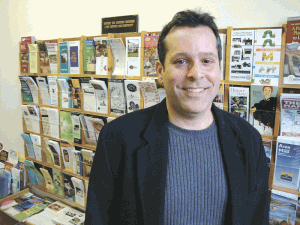
Tony Maroulis says protecting and enhancing the Amherst brand is now part of the mission for the Amherst Area Chamber.
And time and again, he came to the words ‘brand’ and ‘branding,’ which he used to describe not only his organization, but the town of Amherst itself and, especially, its historic, eclectic, and hugely popular downtown.
“The approach that we have taken, and the approach you have to take, is to establish what the core brand is,” said Maroulis, executive director of the chamber. “In Amherst, that is its downtown and the educational institutions. You have to keep that in mind when crafting any strategy.”
Building, protecting, and promoting the brand are critical to the success of everything from attracting and retaining businesses to luring tourists and retirees, to enabling the colleges and UMass Amherst — which give the area so much of its identity and vibrancy — to successfully recruit faculty and staff, said Maroulis, adding that such work also facilitates growth of other areas of Amherst and surrounding communities as well.
“If the strength of the downtown is at peak levels, and you have a visible vibrancy where people are coming, you know you’re driving on all cylinders,” he said. “That really starts to expand and extend to the health and vitality of South and North Amherst as well, and then the other communities.
“It’s about strengthening that brand, and that brand really is about Amherst. Not to detract from other towns, but you have to consider what people on a national level know about your brand identity. And they know Emily Dickinson, the colleges. You have to make sure that you keep that core brand strengthened.”
Historically, what was then called the Amherst Chamber of Commerce was founded in 1956 by a group of businessmen who banded together to forge partnership opportunities in their town. “Many of those families that were instrumental in forming the chamber at that time are still active in the community — the Jones family, the Puffer family. It has been an enduring institution, and one that has had participation from these families and others from generation to generation,” Maroulis said.
But, he noted, as the community has grown from its bucolic background into one of New England’s best-known college towns, the business sector, and the chamber, have evolved with it.
The chamber’s role has expanded over the years, he said, from a small networking organization that would stage fund-raisers and promote member businesses, into an agency that is increasingly about advocacy, and more involved in the politics and planning of the town and region. “We’re much more heavily invested than our role traditionally has been,” he said.
Over the past 10 years, beginning with one of his predecessors, John Coull, the ACC expanded to include some outlying districts that have an intrinsic connection to the Amherst hub — Hadley’s route 9 corridor, the Franklin County town of Sunderland — and, thus, the organization grew into its present name, and is now the AACC.
“There are, in fact, businesses from 20 surrounding communities who are members,” Maroulis said, “because they realize the importance of a presence here in this town.”
For this issue, BusinessWest looks at how Maroulis and the AACC have been getting down to business in order for that brand to translate to higher goals, both within the business community, but also into a philosophical and social dimension that some might deem outside the purview of a chamber of commerce.
Neighborhood Watch
Maroulis pointed to one of the best-known local examples of a civic brand: downtown Northampton.
“They’ve been building upon that since Thornes Market took off decades ago,” he explained. “That affected the commerce on King and Pleasant streets. But that also affected the decision of a business like Kollmorgen wanting to stay. And so, if the strength of the downtown — maintaining a quaint New England character, yet also its emerging urban type of feel and sophistication — is fully intact, then that’s going to mean we can attract businesses in our own outlying areas.
“They’re going to want to be here because that core is strong,” he continued. “They’re going to want to have that access to the businesses downtown, and also see their community members in the village square.”
Building upon the civic strength of Amherst requires some evolution. Adjacent to the downtown parking garage, a new construction, a five-story building nears completion. With retail at the ground level and residences on the upper floors, it represents the first project of this scope and size in Amherst in decades.
“This new building is exciting in many dimensions,” Maroulis said. “It proves that you can do infill projects, with zero-lot-line construction, right in downtown Amherst. That’s important not only to the development community, that it can get done, but also to the community at large, to let them know what the possibilities can be.”
Also in the final stages of completion is Amherst’s Business Improvement District. “The fact that downtown landlords are putting money into the enterprise of downtown is truly exciting,” he said. “They are creating something that is sustainable. This isn’t membership-based; everyone is opting in, and they’re sticking it out as long as they have those buildings. It says a lot about the dedication of those participants.
“Those landlords’ faith that we can continue to move our downtown forward is important,” he added. “And it’s a hugely positive sign. As we promote this brand, having that sustainable resource to maintain it on a regular basis allows downtown to continue to be competitive in the marketplace.”
Community Action Plan
Maroulis noted that, at peak levels, pre-recession, the AACC numbered somewhere around 650 members. “We’re back down to around 520, 550,” he added. “So we’re still pretty strong. That’s reflective of the strength of this community, and for one great reason, we can thank our educational institutions.”
The public school system for the Amherst region is legendary for its academic excellence. But he allowed that the town is sensitive to its social needs.
“Nearly 40% of our school-age population is on free or reduced-price school lunches,” he explained. “And there is a significant percentage of our population that is right around the poverty level. If we don’t address some of these issues, we simply can’t continue to be competitive. And that’s why it is so important to be forward-thinking now.”
When pressed to explain the role of a chamber of commerce in such a sociopolitical forum, Maroulis said the answer was far simpler than the problem itself.
“The chamber is an organization that is very close to the culture and norms of our backyard,” he said. “It’s not just business for business’ sake, or just for profit’s sake. As we are reflective of what our community looks like, we’ve been involved, and we continue to get involved, in all facets of this conversation. I don’t think it is a big jump to wonder, if you have a poor school system, how does that affect the real-estate market?”
That reasoning is also reflective of other aspects of the town’s vibrancy. “This is key to attracting faculty who want to come here — generally speaking, not making the same money that they may make in a larger research university,” he explained. “We have some very talented faculty who could just as easily be teaching at Ivy League schools, but they have chosen to be here for the quality of life.
“I’ve had many of my professor friends talk about the sacrifices in terms of salary, but the quality of life and the excellent school system were significant draws,” he added. “If that school system erodes, how much harder is it to continue to attract that caliber of faculty?”
Planning for the Future
Maroulis joked that, in another lifetime, he might want to be an urban or town planner. Zoning and master-plan agendas with regard to working, walkable village centers have been on the front burners of the AACC as Amherst negotiates its town, gown, and development issues.
He credits the generational breadth of his board for both its legacy and its visionary abilities in maintaining the concept of the town’s strong brand, which has and will continue to have currency in these ongoing conversations. While some business families have been active for decades, there is a younger group of professionals that will ensure that the AACC remains vital well into the future.
Maroulis added that partnerships with other regional organizations have a symbiotic relationship with the college town’s business community — not just the newly created BID, but the Greater Northampton Chamber of Commerce and their collaboration to start a Hampshire County Regional Tourism Council.
“What we are is about community,” he said. “And we stress, both from our mission and in our actions, that being a part of something larger, participating in that, is a long-term blueprint for success. You can’t be on an island by yourself.”
Affiliated Chambers of Commerce of Greater Springfield
www.myonlinechamber.com
(413) 787-1555
• March 14: ACCGS After 5, 5-7 p.m.
• March 14: Professional Women’s Chamber Up the Ladder: The Healthcare Business, 11:30 a.m.-1 p.m., MassMutual Room at the Basketball Hall of Fame, Springfield. Guest Speaker will be Susan Toner, vice president of Development, Baystate Health. Cost is $25 for members, $35 for non-members. Hosted by Max’s Tavern.
• March 21: ERC Board of Directors meeting, 8-9 a.m., the Gardens of Wilbraham Community Room, 2 Lodge Lane, Wilbraham.
Amherst Area
Chamber of Commerce
www.amherstarea.com
413-253-0700
• March 14: Chamber Breakfast, 7:15-9 a.m., at the the Courtyard by Marriott. Craig Melin, president and CEO of Cooley Dickinson Hospital, will will be the featured speaker. Sponsored by Cooley Dickinson Hospital and VNA & Hospice of Northampton. Cost is $5 for members, $10 for non-members.
• March 28: Margarita Madness, 5-7 p.m., at the Eric Carle Museum of Picture Book Art. The public is invited to this margarita-tasting event; guests can sample 12 margaritas and vote for their favorites. The cost is $25 per person, $40 per couple. Chamber members, $20 per person. Sponsored by MassLive.com, the Valley Advocate, Greenfield Savings Bank, Applewood at Amherst, Copycat Amherst, Encharter Insurance LLC, Hope & Feathers Framing, Johnny’s Tavern, Judie’s Restaurant, 30 Boltwood, Lit, the Pub, UMass Fine Arts Center, Your Promotional Consultant/NEPM, and more.
Chicopee Chamber of Commerce
www.chicopeechamber.org
(413) 594-2101
• March 21: March Salute Breakfast, 7:15-9 a.m. at the MassMutual Learning & Conference Center, 350 Memorial Dr., Chicopee. Tickets are $19 for members and $26 for non-members. Sign up online at www.chicopeechamber.org
• March 21: Table Top Expo & Business Networking Event, 4:30-7 p.m. at the Log Cabin Banquet & Meeting House, 500 Easthampton Road in Holyoke. Presented by the Chicopee, Greater Holyoke, Greater Easthampton, and Greater Northampton chambers of commerce. More than 175 exhibitors and 600 visitors are expected. Tickets are $5 pre-registered, $10 at the door. Sign up online at www.chicopeechamber.org
Franklin County
Chamber of Commerce
www.franklincc.org
(413) 773-5463
• March 23: Monthly Chamber Breakfast Series, 7:30-9 a.m., Greenfield Grille, Federal St., Greenfield. Theme: “Art and Business in Partnership: Fostering Our Local Economy.” The keynote speaker will be Peter Kageyama, authority on community development. Presenters: Meri Jenkins, Mass. Cultural Council; Matthew Glassman, Double Edge Theater; Dee Schneidman, New England Foundation for the Arts; and Erica Wheeler, Soulful Landscape Program. Tickets: $12 for members, $15 for non-members. Sponsored by Greenfield Savings Bank. This is followed by the Creative Economy Summit 3 in downtown Greenfield, March 23 and 24. Theme is “Art and Business in Partnership.” Admission is $35. Features practical workshops for two days, and many noted speakers and presenters; www.creativeeconomysummit.com
Greater Easthampton
Chamber of Commerce
www.easthamptonchamber.org
(413) 527-9414
• March 16: St. Patrick’s Day Luncheon, noon-2 p.m., at the Clarion Hotel & Conference Center, One Atwood Dr., Northampton. Honored guest: Molly Bialecki, Distinguished Young Woman of Greater Easthampton. Sponsored by Easthampton Learning Foundation and Finck & Perras Insurance Agency. Tickets are $21.95 for members, $23.95 for non-members.
• March 21: 18th annual Table Top Exposition & Business Networking Event, 4:30-7 p.m, at the Log Cabin Banquet & Meeting House, 500 Easthampton Road, Holyoke. Presented by the Greater Easthampton, Chicopee, Greater Holyoke, and Greater Northampton chambers of commerce. Exhibitor table fee: $100 (must be a member). Contact participating chambers for more info. Attendee-only tickets: $5 in advance, $10 at the door.
Greater Holyoke
Chamber of Commerce
www.holycham.com
(413) 534-3376
• March 15: St. Patrick’s Salute Breakfast, 7:30 a.m., at the Log Cabin Banquet & Meeting House. Cost: $20.
• March 19: Checkpoint Legislative Luncheon, 11:30 a.m., at the Log Cabin Banquet & Meeting House. Presented by Chicopee, Greater Holyoke, and Greater Westfield chambers of Commerce. Keynote speaker will be U.S. Sen. Scott Brown. Sponsored by Charter Oak Insurance and Financial Services Co.; Associated Industries of Massachusetts; Sullivan, Hayes & Quinn, LLC; Columbia Gas of Massachusetts; Mestek Inc.; GZA Proactive by Design; and Westfield Bank. Cost: $35 for members of presenting chambers, $45 for non-members.
• March 21: Table Top Expo, 4:30-7 p.m. (March 28 snow date), at the Log Cabin Banquet & Meeting House. Presented by the Greater Holyoke, Chicopee, Greater Easthampton, and Greater Northampton chambers of commerce. Annual event with up to 180 exhibitors and 700 attendees. Tables (members of presenting chambers only) are $100. Attendee cost: $5 in advance, $10 at the door. For a list of sponsors, check the BusinessWest ad.
Greater Northampton
Chamber of Commerce
www.explorenorthampton.com
(413) 584-1900
• March 21: 18th Annual Table Top Exposition & Business Networking Event, 4:30-7 p.m., at the the Log Cabin Banquet and Meeting House, 500 Easthampton Road, Holyoke. Tickets are $5 in advance, $10 at the door.
Greater Westfield
Chamber of Commerce
www.westfieldbiz.org
(413) 568-1618
• March 16: Annual St. Patrick Day’s Breakfast, 7:15-9 a.m. at Westfield State University, 577 Western Ave., Westfield. Guest speaker will be George O’Brien, editor of BusinessWest Magazine. Entertainment by some of the Dan Kane Singers. Cost: $25 for chamber members, $30 for non-members. To reserve tickets, contact Carrie Dearing at (413) 568-1618 or [email protected]
• March 19: CheckPoint 2012 Annual Legislative Luncheon at the Log Cabin Banquet & Meeting House, 500 Easthampton Road, Holyoke. Keynote speaker is U.S. Sen. Scott Brown. A collaboration between the Greater Westfield, Chicopee, and Greater Holyoke chambers of commerce. Cost: $35 for chamber members, $45 for non-members. To reserve tickets, contact Carrie Dearing at (413) 568-1618 or [email protected]
• March 28: WestNet Plus One!, 5- 7 p.m. Come and network with fellow chamber members and meet new members and businesses in the area. Guest speaker will be Patrick Berry, president of the Westfield News. Hosted by PeoplesBank, 281 East Main St., Westfield. Cost: $10 for chamber members, $15 cash for non-members. Don’t forget your business cards! To register, contact Carrie Dearing at (413) 568-1618 or [email protected]
• March 31: 2012 Spring Southwick Economic Development Commission (EDC) Home & Business Show, 10 a.m.-3 p.m. at Southwick Town Hall, 454 College Highway. This tabletop exhibit of Southwick businesses is free to the public, and the EDC will be collecting non-perishable food items for the local food pantry. Several free seminars will be held. Visit www.southwickma.info for more information.
Young Professional Society of Greater Springfield
www.springfieldyps.com
• March 15: March Third Thursday Networking/Social Event, 5-7 p.m.,
the Still Bar & Grill, 858 Suffield St., Agawam. This event is, as always, free for YPS members and $10 for non-members, and will include food and a cash bar.
Use Non-disclosure Agreements to Keep Things Confidential
Practically every business hires independent contractors. But rarely do they obtain non-disclosure agreements prior to disclosing information to the contractors.If you hired a third party to develop your Web site, did you require an NDA before discussing your business procedures or methods? If you invented a new product or business process, did you obtain a NDA from manufacturers or distributors before discussions began? While this seems like common sense, most businesses fail to recognize this important protection.
A non-disclosure agreement is a legal contract between at least two parties that outlines confidential material, knowledge, or information that is to be shared between the parties, while one or both wish to restrict access to the data by third parties. The non-disclosure agreement is a contract creating a confidential relationship between parties to protect any type of proprietary information.
NDAs are often used when two or more entities are considering doing business and need to understand the processes used by the other for purposes of evaluating the business relationship. Employment contracts will often include a non-disclosure agreement clause restricting the use and dissemination of confidential, company-owned information.
Non-disclosure agreements may also contain clauses that protect the person receiving the information so that, if they lawfully receive the information through other sources, they would not be obligated to keep the information secret. The NDA typically requires the receiving party to maintain the information in confidence when the information was supplied directly by the disclosing party named in the agreement.
Many agreements are unilateral or directional NDAs. This would be used when only one party is disclosing information which is to remain confidential and requires that the other party not use the disclosed information without compensating the discloser. Another common type of non-disclosure agreement is a mutual agreement where both entities intend to disclose information that should remain confidential.
Just because a document or clause is titled ‘non-disclosure agreement’ does not mean it provides you with the appropriate level of protection. A non-disclosure agreement can protect any type of information that is not commonly or publicly known and may be very detailed; however, agreements generally address the following basic issues:
•Parties to the agreement;
•Definition of information to be held confidential;
•Time period of the confidentiality;
•Term the agreement is binding;
•Exclusions, if any, from the agreement; and
•Types of permissible disclosure, such as those required by law or court order.
Unless they can provide a compelling reason for their refusal, warning lights should go off if a party refuses to sign a non-disclosure agreement. Analyze the business relationship and the deal itself and consider whether you should walk away in the event one party refuses to sign.
To minimize and manage your risk, obtaining non-disclosure agreements should become a standard practice for your business. Do not expose your business secrets to others without this protection.
Dawn D. McDonald is an associate with Cooley, Shrair P.C., focusing her practice on assisting clients in the areas of commercial litigation and labor and employment law; (413) 735-8045; [email protected]
Six Tax Tips to Enhance Your Growth Strategy
If you’re a business owner, then you know how challenging it is to maintain your profitability in these tough economic times, let alone grow your business. Therefore, it’s critical to ensure you have the right resources, team, and business partners who not only support you, but also truly understand your business … from all angles.
Every business owner should have an accountant whom they can rely on to support their business’ challenges and provide timely and appropriate advice. Your accountants should be more than just advisers whom you speak with during tax season. They should serve as your business partners, helping you with financial and operational strategies and supporting your objectives for profitability.
Business owners should communicate with their accountants throughout the year to ensure they are taking advantage of all eligible government subsidies, basically tax breaks, that are relevant to the company. These are designed to support investments in capital assets as well as every organization’s most valued resource: its people. The following tips are designed to help decrease risk and improve profitability.
1. Review all expenditures made in 2011 to see if they qualify for the business-property-expensing option. The generous dollar ceilings that applied until Dec. 31, 2011 for both Sec. 179 and 100% bonus depreciation expensing allowed many businesses to deduct most, if not all, of their outlays for machinery and equipment.
2. Next, review your eligibility for the following credits:
• Employee retention tax credit of $1,000 for each eligible new employee whom you have retained for at least 52 consecutive weeks;
• Small-employer health-insurance credit of 35% of your non-elective contributions to your employees’ health insurance; and
• Research and development tax credits, including certain costs incurred in the creation of a Web site. This can be a very lucrative tax credit, which is often overlooked in businesses, especially in industries not commonly affiliated with research and development.
3. Did you take advantage of alternative fuel and energy credits? There are a variety of options, and it’s important to speak directly with your accountants to confirm if you qualify for any of these credits.
4. It’s important to substantiate and retain documentation for all of your deductible business expenses, particularly meals, entertainment, and automobile mileage. The IRS is auditing small businesses with a particular focus on disproportionate meals and entertainment as well as automobile expenses. Review your expense-tracking system with your accountant for compliance with these requirements.
5. Meet with your accountant to review the status and classification of all independent contractors. Some might need to be classified as employees and receive W-2 forms rather than 1099s.
6. Evaluate your options with an existing retirement plan or consider setting one up beginning in 2012 to maximize your benefits and theirs.
During every growth stage in a company, it’s extremely important to manage your liquidity. Therefore, this is the perfect time to establish a budget for 2012 to accurately forecast the funds needed to run your business. Cash flow is the lifeblood of every organization, so ensure that yours is healthy.
Robert F. Gorton is a shareholder and CPA at Waldron Rand. He has more than 20 years of experience providing assurance, tax compliance, and business-advisory services to privately held companies in varying industries. He works closely with each client’s management team to implement short- and long-term business, financial, and tax plans to ensure success. He is skilled in the area of mergers and acquisitions and has counseled many clients on due diligence, negotiations, and integration activities. He is certified in financial forensics and has significant experience in litigation, accounting and auditing, and investigative analysis; [email protected]
Women Lag Behind Men in Attaining Leadership Roles and Financial Parity
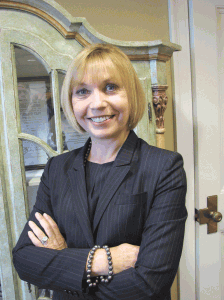
Elaine Sarsynski says women believe meritocracy exists, and they will be recognized for their efforts without having to call attention to themselves. But she thinks this is a false perception.
“There is still a stark difference between the earning potential of women and men,” said Elaine Sarsynski, executive vice president for MassMutual’s Retirement Services Division and CEO of MassMutual International. “Even though women make up almost 50% of the workforce today and hold almost 52% of managerial positions in professional occupations, as you start to go up the pyramid, the real issues begin. Today, there are 17 female CEOs in Fortune 500 companies, which is only 3.6%. And when you include Fortune 1000 companies, you are still looking at only 35 female CEOs.”
Other statistics mirror this lack of parity. In 2010, females who worked full-time made 77 cents for every dollar earned by men, according to the Institute for Women’s Policy Research. The inequity often starts from the time they are hired, and a difference of $3,000 in starting salaries between a man and woman is significant.
“It translates into hundreds of thousands of dollars when you factor in retirement, promotions, and bonuses,” said Kristine Barnett, assistant dean of the College of Arts and Sciences and director of the WELL (Women as Empowered Learners and Leaders) campus theme program at Bay Path College in Longmeadow.
Women also haven’t fared well in the political arena. A recent United Nations report shows the U.S. ranks 75th among the world’s countries in terms of the percentage of women in political office. “We are behind Indonesia, Bosnia, and the Dominican Republic,” said Carla Oleska, CEO of the Women’s Fund in Easthampton, adding that Sweden, South Africa, Cuba, and Iceland are in the forefront.
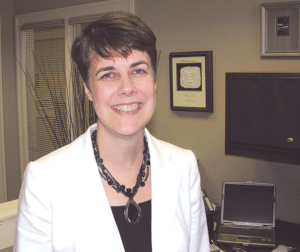
Kate Kane says that advancing to the top levels of many businesses requires a certain amount of personal sacrifice.
Many women are not willing or able to do this, but those who do seek such positions face real roadblocks on the path to success. Experts say the reasons are complex and range from ongoing gender conditioning to embedded corporate patriarchal systems, along with myriad other issues, including women’s denial that inequality still exists.
 But the combination of these factors means that a woman’s best efforts may not result in success. A recent survey conducted by Catalyst Inc. shows that, when women did all of the things they were told would help them get ahead and used the same tactics as men, they still advanced less rapidly and profoundly than their male counterparts and had slower increases in pay growth.
But the combination of these factors means that a woman’s best efforts may not result in success. A recent survey conducted by Catalyst Inc. shows that, when women did all of the things they were told would help them get ahead and used the same tactics as men, they still advanced less rapidly and profoundly than their male counterparts and had slower increases in pay growth.However, initiatives to help women succeed are beginning to gain force, such as Vision 2020, which has 102 delegates from the across the nation who have united with the goal of advancing women’s equality by the year 2020. Measures they have adopted include raising awareness, developing shared leadership, and creating opportunities for success for future generations.
“Women want to become executive leaders and have the talent, capability, and wisdom to do so, but ultimately the system forces them to make decisions that do not complement their lives; if you want to become a partner in a law firm, do you spend 70 hours a week at work and put off having children?” Oleska said, citing a host of situations women face that include dealing with aging parents, as this responsibility frequently falls on them.
“There is a lot at stake when women consider whether they will pursue a position in executive leadership. The expectations for a CEO do not allow for a healthy work/life balance, and some women don’t want to be out seven nights a week,” she continued. “But as we continue to build a critical mass of women executives, we will see some of these systems change.”
Work in Progress?
Gender differences are inherent in every workplace, and even though some things are real and others are a matter of perception, they create problems for women trying to climb the corporate ladder.
Sarsynski believes part of the reason so few women achieve the coveted C office is because decisions in succession management are often made by male-dominated boards of directors, which, she says, tend to be biased against women. “But women-owned businesses employ 35% more people than all Fortune 500 companies combined, and 40% of all U.S. businesses are owned by women,” she continued, “so the idea that women don’t make good managers just doesn’t hold up.”

Kristine Barnett says women are more uncomfortable than men when it comes to promoting and negotiating for themselves in the workplace.
“Men are promoted on potential, while women are promoted only after they have demonstrated competence and results,” she opined. “So men come to the workforce with a different attitude; they feel very capable and don’t have to prove themselves the way women do.”
Experts tell women who want to attain high-ranking positions to find mentors and executive sponsors who can help them advance their careers. “They also need to have clear conversations with their managers about how they can achieve additional competencies, and be very vocal about where they want to go in their careers,” Sarsynski said. “It’s important for a woman to find her voice. There is absolutely no doubt in my mind that women are every bit as competent as men and are often superior leaders, but they need to become more focused and communicate during critical conversations with decision makers.”
Effort and initiative are additional factors in success, and ambitious women need to become knowledgeable about every nuance of the business line they are interested in, she went on. And it’s also critical for them to take risks in groups, where their knowledge can stand out. In fact, learning effective communication skills and putting them to use during presentations and discussions is an essential component in moving up the corporate ladder.
Sarsynski says women think meritocracy exists, and they will be recognized for their efforts without having to call attention to themselves. But, she argued, this is a false perception, adding that women need to learn to promote themselves and their accomplishments in the way men have done for generations. But this isn’t easy, because touting their success runs counter to the socialization process.
“Women tend to embrace teamwork,” she noted. “They want to make sure the members of their team receive recognition, and tend to be quieter about self-promotion. They also tend to take the blame if there is a problem with a project, whereas men tend to self-promote and leverage the power of their relationships.”
Barnett agrees. “Women are socialized to be more compliant and sensitive to the feelings of others; they are taught not to boast, as it is seen as unattractive, whereas men are socialized to compete in healthy ways and be direct about what they need,” she said, adding that, since women don’t negotiate well for themselves, if a woman and man with the same credentials compete for the same job, the man is likely to negotiate a higher salary.
“Men are more comfortable negotiating; they are socialized to know their self-worth and believe in it, where women are socialized into minimizing their self-worth and not leading with it,” Barnett continued. “A woman will be happy just to be offered the job, while a man will say, ‘I am worth more.’ And companies know the game.”

Carla Oleska says workplace paradigms often make it difficult for women to achieve their career goals.
Kane agrees, and says the added responsibility can compete with success at work. “The biggest problem is that, 90% of the time, women still are the primary caretakers of children, and if they are sick or if the women have older relatives or parents who need help, that also falls on them.”
In the past, women have made attempts to change the perception of the game, but found it didn’t work well. One attempt came during the 1980s, when many women broke through what was known as the glass ceiling by emulating a man’s style. In addition to adopting more assertive behavior, their dress code was dominated by business suits with large shoulder pads that Barnett said were meant to mirror a man’s physique.
“They thought it would make them more successful,” she said. “But there was a backlash, as men realized that emulating their style didn’t change anything; they had a figurehead, not someone who was going to change the culture.”
New Ideas
Kane says women in executive positions today face myriad issues in regard to change in their workplace.
“I’m always aware of the fact that I am one of the few who has gotten to the level I have attained. There is a sense of pride, but I also think about whether I should be crusading for wholesale change,” she said, adding it can be problematic because those who change a culture risk doing away with elements that work well. “But you do want to embrace new perspectives, thought processes, and talents that could make it even better. It is an incredibly nuanced and difficult issue.”
Oleska has a small staff, and says the Women’s Fund makes it a priority to model how work and motherhood can coexist by allowing employees to work from home if their children have snow days or are sick. “We try to take the system here and make it work for women’s lives, not against them. Some companies have made wonderful strides and are family-friendly. And when that happens, ultimately, everyone benefits,” she said.
Northwestern Mutual is putting together a corporate-led department that will deal with issues of inclusion as well as diversity. But change doesn’t happen overnight. “There is a lot of talk about flex time, but I have very few clients who have that in their workplace; the majority must report to their office, and their productivity is measured by how much time they spend there,” said Kane.
Sarsynksi is proud of MassMutual’s approach to diversity and gender issues, and says information gleaned from a number of diverse employee-resource groups has led to better business decisions. Flex time and the ability to work at home is determined by individual managers, and the company has a physician, day-care facility, and hairdresser on site to help make things easier for employees.
Still, early conditioning prompts women who are allowed flex time or given the opportunity to work at home to feel they must explain their actions, said Barnett. “It is a sensitive issue because women do believe they have to justify their decisions.”
Kane said business leaders need to consider whether their workplace and culture are inclusive enough to make women feel comfortable so they will remain in their positions. “It’s the crux of the problem. If you fill positions with high-quality people because you want to solve demographic issues but don’t change anything else, it won’t work due to cultural norms, especially in sales, where employees must be competitive and aggressive to succeed,” she explained.
MassMutual is taking the lead by launching a Women’s Leadership Forum next month that will focus on retention, development, and advancement of women in leadership.
Retention is especially important, since many women make the decision to leave their jobs and start their own businesses so they lead more balanced lives.
“More and more women are choosing the entrepreneurial route. If you own your own business, you can choose your hours and are not judged,” Kane said, adding that managers often assess work performance in terms of hours spent at the office even though people are still tethered to their jobs via technology 24 hours a day.
Hope Prevails
One of the reasons momentum has slowed in terms of economic parity is that most people are unaware or would rather not face the fact that inequity still exists. “People think there has been progress, so they believe the issue doesn’t need to be on the front burner,” Barnett said, adding that many young women also adhere to this belief.
Still, she believes America is headed in the right direction. “Women who reach CEO levels have power and are changing cultures, which filters down and benefits everyone,” she said. “The issues will never go away, but I would be happy to see them diminish. And I think the progress women have made is tremendous. But they will have to take responsibility to keep the momentum going, and awareness is key.”
Working Mothers Struggle to Balance Career and Home Life
 Kelly Tobin has three children, is a claims consultant for Disability Management Services in Springfield, and loves her job. In fact, she would definitely not want to be a stay-at-home mother.
Kelly Tobin has three children, is a claims consultant for Disability Management Services in Springfield, and loves her job. In fact, she would definitely not want to be a stay-at-home mother.
But she does not have a minute to herself from the minute the alarm goes off until her head hits the pillow at night. “There is always something to be done and someone to take care of,” said the 41-year-old Hatfield woman.
Jessica Phaneuf agrees. “I start my day at 6 a.m. and don’t stop until 8 or 9 at night. It’s really difficult to achieve balance between family and work, and it’s stressful because I bring work home with me. When I am home, I want to focus on my children, but that’s not always possible,” said Phaneuf, who has an 8-month-son and 2-year-old daughter, and owns Fitness Together in Amherst and Northampton.

Kelly Tobin loves her job, but the multitasking and constant demands of caring for her three children and doing well at work result in days when her stress level is almost intolerable.
And Janet Casey knows no limits, as she gives her all to home and work. Six hours after giving birth to twins via cesarean section, Casey was on the phone conducting business. “The twins were born on Election Day, and I was managing seven political campaigns,” explained the owner of Marketing Doctor in West Springfield.
Casey has four children, including 15-month old twins Cassidy and Cooper. Cassidy has had a feeding tube since he was born, and during four surgeries Janet slept in a chair in the hospital and kept up with work via a laptop and iPad. “My clients didn’t even know I wasn’t in the office,” she said, adding that her husband was home caring for their other three children.
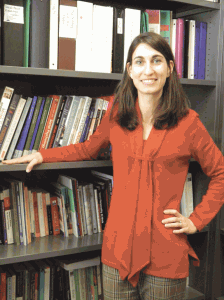
Jessica Carlson says women have better coping strategies than men when it comes to stress, and are more likely to take advantage of social support.
Still, a study released last year by the University of North Carolina, which followed 1,300 working mothers, showed those who work have better health and fewer symptoms of depression than stay-at-home moms. However, it also revealed that mothers with part-time jobs do a better job nurturing their children and balancing their life than those who work full time.
But working part-time is not always possible, especially for women intent on getting ahead in the business world. As a result, guilt and stress are constant companions, and in spite of their ability to multitask, women make real sacrifices to accomplish all they must get done.
For this issue and its focus on Women in Business, we take an indepth look at what, for many women, appears to be a mission almost impossible.
Difficult Choices
Michelle Budig, associate professor of Sociology at UMass Amherst, says researchers in time management have found the number of hours women spend at work has increased dramatically since 1960, but the hours they spend caring for their children has not changed. “What women have sacrificed is their personal care, leisure, and sleeping time,” she said.
Crocker is frequently sleep-deprived. “My exhaustion level is crazy. I have learned to function on four hours of sleep. On occasion I catch up, but if something has to give, my sleep is the thing that gets sacrificed because it’s definitely a priority to be with my children,” said the 43-year-old.
She also puts in extra effort to teach her children to be independent, and although it adds to her workload, she wants them to attain life skills necessary for independence. “It would be so much easier to do more for them, but the more you do for children, the less they do for themselves.”
Research shows that, although the amount of hours working mothers are present in the home has diminished, they have preserved the number of hours they spend interacting with their children. “They are still reading to their children, giving them baths, making meals, and feeding them,” Budig said, adding that researchers find it surprising that women are still doing so much. What has gone by the wayside is household chores, and working moms are hiring more help, eating out more, and lowering their standards for household cleanliness. Although many husbands help out, time diaries kept by parents over a period of about 40 years showed that men spend only five hours more a week helping out at home than they did in the ’60s.
Crocker makes a real effort to spend quality time with her children. But like other working moms, she has missed out on important milestones while at work, which results in conflicted feelings. “It’s a struggle, and I have to remind myself I am working to support them and give them everything I can,” she said.
Tobin remembers getting a phone call from her day-care provider, who told her to listen to the tapping noise on the phone. “That is your daughter walking,” she was told, as the knowledge sunk in that she had missed her baby’s first steps.
These losses, combined with continuous worry, lead mothers to try to compensate for the time they must be away from their children. Crocker keeps watch on them from a distance by calling her day-care provider several times a day. “I make sure I talk to both of my children. I don’t miss a day, and it makes me feel better,” she said.
Casey also goes above and beyond. “I spend days in my daughter’s classroom as a volunteer,” she said. And like Crocker, she also calls her day-care provider every day. “I have guilt every day, depending on which child I am more concerned about,” she said.
In addition, she spends time playing with her children every night. “When I come home, my needs come last. But this is the road I chose. I don’t know any mother who can be 100% sane. You are always at a varying degree of insanity because of everything you have to do.”
That includes dealing with the fact that young children get sick frequently, which means someone has to stay home and care for them. “I have missed a lot of work,” Tobin said. Her husband is an attorney, so if he is scheduled to be in court, “he trumps me, even though we try to juggle it.”

Janet Casey, who has four small children and owns Marketing Doctor in West Springfield, says juggling motherhood and a business means her needs are always the last to be met.
Bonuses and Penalities
Carlson says working mothers in high-level positions have equally high levels of stress hormones flooding their bodies. But they also have better coping strategies than men because they are more likely to take advantage of social support.
“So even though they have more stress, evidence suggests that they handle it better than men, and multiple roles offer more opportunities for success, which leads to higher self-esteem and greater self-efficacy,” Carlson said, explaining that, if a woman has a frustrating situation at work or home, doing well in the other arena can compensate for it.
Marriages also benefit when women work, because they are contributing to their family’s resources and are able to share issues in the workplace with their husbands. However, having children does affect a woman’s earnings. Budig recently testified before the U.S. Joint Economic Committee about a research project she conducted titled “Work-Family Policy Consequences of Employment and Wages of Mothers.” It showed that women are penalized for having children while employers “see fatherhood as a signal of more stability and greater commitment to work. It’s a complete opposite,” she said, adding that there is a “wage punishment” for motherhood.
“On average, women earn 6% less per child in terms of lower wages after all the adjustments,” Budig said, explaining the study took a wide variety of factors into consideration, including whether women return to work immediately or take time off after giving birth, as well as their education, job changes they make due to motherhood, and the types of jobs they hold.
However, women who make $75,000 or more suffer significantly less. They are only penalized by about 1% to 2% per child in terms of earnings, while the lowest wage earners are penalized as much as 15%.
This may be because they are often dependent on family members and friends for child care, so in a crisis they may be forced to quit their jobs or take time off from work, while women with higher incomes are more likely to have quality child care, sick time, and flexibility. “They have more resources to maintain their employment when life gets difficult. Research has shown the women with the least to lose — the lowest earners — get the largest penalty for having children,” Budig said.
Other losses result from difficult emotional choices, such as whether to leave work to attend school events. “You only get so many of these opportunities in a lifetime. There is a price, and for every choice you make you lose something,” Tobin said. “There are days when I get heart palpitations or when I have felt so overwhelmed, I am afraid I could have an anxiety attack or go over the edge if I think about how many balls I have in the air. But working mothers are always hard on themselves, and when you make the decision to be a working mother, you have made the choice to live in conflict.”
Hidden Assets
There are benefits to mastering motherhood and job responsibility, and research shows the juggling act enhances a woman’s competencies. “For example, mothers have to learn patience, which can serve them well in the workplace,” Carlson said. “It’s a symbiotic relationship, and having multiple roles doesn’t always have to be detrimental, as the effects can improve their skills at work and at home.”
Working mothers also provide a positive role model for their daughters. “Girls who see their mothers working have more egalitarian views on gender,” Carlson said.
The ability to multitask successfully is another asset that is often overlooked. “The question,” she explained, “is how an organization can help make use of these talents and help women shine.”
Some of the measures that could make a difference have been identified. They include flexible hours and telecommuting that would make the work-life balance easier for women.
But few businesses offer these perks. “There is a perception that face time is important, so even if the benefits are available, people don’t feel free to use them,” Carlson noted. And only about 10% of U.S. firms have established on-site child-care centers. “So strides are being made, but there is still a long way to go.”
Tobin made the decision to leave her job when was pregnant with her third child because she realized she had missed out on a lot with her other children, and her employer didn’t offer part-time positions. But in time she was told she could work 25 hours a week, which she eventually expanded upon.
“I was fortunate enough to have the best of both worlds. It was risky for my employer because it was uncharted territory, so I am forever indebted to them,” she said, adding that the arrangement allowed her to maintain her professional status without impacting her career.
However, some countries that put a high value on family life don’t put parents in this predicament. “In Sweden, parents get a year of paid leave when they have a child, and it is commonplace for men as well as women to take these leaves,” Carlson said.
But in the U.S., motherhood is not always seen as a plus, and a study conducted by researchers at Stanford University indicates that employers may discriminate against women with children. Budig said researchers submitted résumés that were almost identical to a number of companies. The one difference between them was that one group listed activities such as parent-teacher-organization involvement or other things that indicated the women had children. Their research showed that the résumés without references to children resulted in significantly more callbacks and salary offers.
Reality Check
Still, American women are doing their best to work and raise their families within the confines of the system. “You can’t deny that someone else is raising your kids during the hours when you are at work,” Casey said. “Your family suffers when you are at work, and your business suffers when you are with your family. It’s just reality.”
But overall, women are happy that they can achieve both goals. “I like my job, and work is my escape from home. It allows me to use my brain in a very different way,” Tobin said. “I have suffered from guilt and cried, wondering if I am doing the right thing. But at the end of the day, I know I wouldn’t want to be a stay-at-home mom.”
PeoplesBank Surpassed $1 Million in Charitable Giving in 2011

Tom Senecal visits with students at Square One in Springfield. PeoplesBank donated $25,000 to the organization to help it recover from the June 2011 tornado.
After all, the bank committed $200,000 for relief efforts in the wake of the June 1 tornadoes that devastated neighborhoods in Springfield, West Springfield, Westfield, Monson, and other communities.
But Senecal, the bank’s chief financial officer, believes the Holyoke-based institution probably would have reached that milestone even if the region hadn’t been visited by those twisters, which created needs that probably couldn’t have been imagined on May 31.
That’s because the needle had been moving steadily toward that number for the past several years — donations totaled $850,000 in 2010 and $705,000 in 2009 — and also because the bank had a very solid year with regard to the bottom line, and sought to redirect profits back to the community as a reflection of the culture at the 127-year-old bank — and to address growing needs in many areas, said Senecal.
“We were seeing a tremendous need in all the communities we do business in,” he told BusinessWest. “Some of it was related to the tornadoes, but it was across the board, really, from gifts to several senior centers to donations to hospital capital campaigns.
“We’re a mutual institution, and we do not have stockholders,” he said. “We believe, as a result of that, that it’s our responsibility to give back to the communities we do business in.”
And while surpassing the $1 million mark is a noteworthy achievement, like the bank’s consistently high ranking on the Boston Business Journal’s listing of the most charitable companies in the state (38th in the last survey), what’s behind that number — meaning the direction this philanthropy takes — is the more significant story, he told BusinessWest.
Indeed, the bank continues to focus its efforts on three major areas — health care, education, and what he called “environmentally friendly initiatives,” with that latest category being a far-more-recent phenomenon, meaning the past decade or so. The weather calamities, especially the tornado, created new types of need, Senecal noted, and new and different ways for PeoplesBank to lend its support to the community.

Susan Wilson, vice president of Marketing at PeoplesBank, tours the new Leverett Elementary School greenhouse that was funded by a donation from the bank.
“We made that donation to Square One within the first week after the tornado struck to help with emergency needs that they had within the community,” he said, adding that contributions were also made to a number of organizations involved in relief efforts, such as the Red Cross, the Community Foundation, and others.
But, as Senecal said, there was more to the bank’s surge past the $1 million mark than the wrath of Mother Nature.
Indeed, 2011 was a year when state and especially federal budget cuts hit a number of nonprofit agencies quite hard, said Senecal, adding that PeoplesBank stepped forward to help many of these institutions.
“Government cutbacks have forced nonprofits to seek alternative sources of funding so they can continue their missions,” he said, adding that more reductions are likely in the years ahead, meaning that need will continue to increase.
There was also the bank’s ongoing expansion, he said, noting that, when the institution widens its reach into a different community or neighborhood, it punctuates its presence with donations targeted for that area. This trend was continued recently in Springfield and West Springfield (the bank opened its latest branch there last year), and it will be witnessed in Northampton when it opens its first full-service branch there (and 19th overall) later this year.
“We reach out to the community to find causes that can have as much impact as possible in the cities and towns in which we do business,” he said of this pattern, adding that the ongoing expansion efforts are a big reason why overall donations within the Western Mass. region have increased more than 40% since 2008.
Looking back on 2011 and reaching the $1 million milestone, he noted that that there were donations made to roughly 400 organizations. Many were tornado-related in some way, he continued, noting that a total of $80,000 was donated to five communities for so-called “re-greening efforts.”
Overall, though, contributions were focused on those three main areas of concentration, said Senecal, noting that, in health care, donations were made to senior centers, hospitals, other care providers, and specific initiatives to improve the overall health and well-being of area communities.
There were many contributions in the broad realms of education and the environment as well, he went on, adding that some managed to overlap.
Such was the case with a donation put toward the building of a greenhouse at the Leverett Elementary School in Leverett, Mass.
But Senecal stressed that donations to the community are not limited to checks from the bank, or monetary contributions.
Indeed, PeoplesBank employees were ranked third in the state by the Boston Business Journal in terms of charitable giving from their pockets, and fourth when it comes to volunteer hours donated within the community, statistics that are a big part of the bank’s philanthropic track record.
“When you talk about a corporate culture of giving, it’s not just at the president’s level or the PeoplesBank level,” he explained. “It comes from all the employees.”
— George O’Brien
The 401(k) Coach Gets Write to It
 Charlie Epstein says that, as he was pondering a title for his recently released book, he was, for a very short time by his estimation, thinking about something Steven Covey-like — “maybe ‘Nine Habits of Highly Successful Savers.’”
Charlie Epstein says that, as he was pondering a title for his recently released book, he was, for a very short time by his estimation, thinking about something Steven Covey-like — “maybe ‘Nine Habits of Highly Successful Savers.’”
But while those habits, or principles, as he calls them, are, indeed, the foundation of the book, and he has a patent pending on them, he opted instead for a phrase he started putting to use several years ago — ‘paychecks for life’ — because he believes it’s far more forceful, attention-grabbing, and to the point.
And it also helps him in his quest to entertain as well as educate, a quality he maintains is missing from most everything else that has been written on the subject.
“When I was starting in the retirement industry and reading through what was available for educational material … it was absolutely atrocious,” Epstein, president of Epstein Financial Services and the 401(k) Coach, told BusinessWest. “The average person comes into a 401(k) meeting with the expectation that they’ll be asleep in 10 minutes. You have to create a Disney-like experience for people today; you have to entertain them.
“That’s hard to do, but the principles are engaging — and they’re simple,” he went on, while explaining his approach taken with Paychecks for Life: How to Turn Your 401(k) into a Paycheck Manufacturing Company, a detailed look at effective retirement saving — although Epstein doesn’t use the word retirement any more.
Well, he does, but only in an exercise he’s probably repeated several hundred times, in which he asks the person he’s sitting across from (be it a reporter, client, or potential client) to give Webster’s definition of the term. Usually he doesn’t wait long before giving the answer himself — ‘to be put out of use’ — and then asking, “do you know anyone who’s working to be out of use?”
So he’s created the phrases ‘desirement,’ ‘desirement plan,’ ‘desirement mortgage,’ ‘desirement years,’ and others, which are at the heart of his motivation to pen and then self-publish Paychecks for Life.
“My book is not about how to invest your money better,” he explained. “It’s about the nine principles to get you to save smarter, and then how to maximize this mechanism that the government calls the 401(k).”
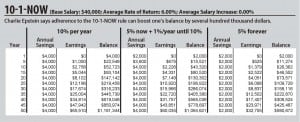 Elaborating, Epstein said he wrote the book ($22.99 hardcover, available through Amazon and paychecksforlife.com) to change people’s attitudes about saving for the years after they’re done working. When asked what needs to be changed, he said many things, but especially the still-wildly held opinion that Social Security or a company pension will be there and be an adequate source of income, and also the sentiment among many people that they simply cannot afford to save for retirement — or save enough to create what Epstein calls a paycheck-manufacturing company.
Elaborating, Epstein said he wrote the book ($22.99 hardcover, available through Amazon and paychecksforlife.com) to change people’s attitudes about saving for the years after they’re done working. When asked what needs to be changed, he said many things, but especially the still-wildly held opinion that Social Security or a company pension will be there and be an adequate source of income, and also the sentiment among many people that they simply cannot afford to save for retirement — or save enough to create what Epstein calls a paycheck-manufacturing company.
Which brings Epstein to one of those nine principles, the ‘desirement mortgage’ (which he calls the centerpiece of the book), and the many parallels he makes between this and a traditional mortgage.
Indeed, Epstein advises individuals to follow what he terms the “home-ownership formula for success” when they craft a retirement-savings strategy, with the following thought processes:
• You identified your dream house and what it would cost;
• You committed to paying for your dream house within a certain period of time;
• You calculated what it would cost, i.e. what you could afford to finance each month as a mortgage payment;
• You saved for your down payment;
• You adjusted your plan and budget to overcome unforeseen financial obstacles that might prevent you from achieving your dream of home ownership;
• You never stopped believing you could save for and finace your goal of home ownership; and
• You achieved your dream (desirement) and purchased your first home.
For this issue, BusinessWest turns some of the pages in Epstein’s book, in a figurative sense, while talking with the author to gain some perspective about how he came to write Paychecks for Life, and why he firmly believes it will successfully change some mindsets.
Past Is Prologue
“Your Annual Eviction Notices.”
That’s the title Epstein put on one of the earlier, introductory chapters of his book, and it’s a phrase designed to grab some attention, but also to drive home his points about Social Security and company pensions.
He notes that, when most people get their annual Social Security statements in the mail, they immediately turn to the page that breaks down what they’ll receiving in benefits if they retire at 62, 65, and 67, respectively. What just about everyone neglects to do, Epstein goes on, is look at the first page, where the following notice is printed:
“Social Security is a compact between generations. Since 1935, America has kept the promise of security for its workers and their families. Now, however, the Social Security system is facing serious financial problems, and action is needed soon to make sure the system will be sound when today’s younger workers are ready for retirement. In 2015, we will begin paying more in benefits than we collect in taxes. Without changes, by 2037 the Social Security Trust Fund will be able to pay only about 76 cents for each dollar of scheduled benefits.”
While discussing this fine print, as he called it, Epstein digressed to talk about why he and many others believe the Social Security system must be changed — with wealthy Americans removed from it, among other adjustments — but quickly returned to the matter at hand, which was getting readers to think well beyond checks issued by the U.S. Treasury when they consider their desirement years.
And the same goes for pension plans, he writes. “In 2007, of all the Fortune 500 pension plans that existed in 1996, 25% had been terminated, closed, or frozen. Between 1996 and 2007, Fortune 500 plans were closed or frozen at the average rate of 3% per year. In 2006, Verizon and IBM shocked the corporate world by freezing their pension plans (managers only in the case of Verizon), which created a standard that others soon followed.”
Which brings Epstein back to the 401(k) — the vehicle that enables employees to put a portion of their current income (a contribution) into several investments on a pre-tax basis — which has been the victim of some negative PR in recent years. Examples include the term ‘201(k),’ used often during the height of the Great Recession, when participants were seeing their balances take hits of 30% or more, and also a Time magazine cover which came out in October 2009 with the headline, “Why It’s Time to Retire the 401(k) (and What You Can Do Instead).”
“That was the worst journalism I think I’ve ever seen in my life,” he said of the Time article, adding that such bad press helped inspire Paychecks for Life. But the seed had actually been planted well before, when the idea of the 401(k) as a paycheck-manufacturing plant started gelling in his imagination.
But merely having such a plan isn’t enough to meet that mission of providing paychecks for life, Epstein told BusinessWest, noting that this simple fact is what compelled him to draft his nine principles for carrying out that task — and then writing about them. They are, in order:
• Act like an entrepreneur;
• Determine your desirement mortgage;
• Use other people’s money to capitalize your business;
• Harness the power of compound interest;
• Use technology to save automatically;
• Manage risk by outsourcing;
• Control fees and expenses;
• Guarantee your paychecks for life with annuities; and
• Take advantage of tax benefits with a Roth.
All the principles are important, said Epstein, noting that, together, they send a clear message — that, for a 401(k) to work as designed, the participant must take full ownership of it. His book, in essence, explains how to do that.
The Plot Thickens
 It all starts, literally and figuratively, with that part about thinking like an entrepreneur, writes Epstein, who adds to the generally used definitions of that term his own spin: “one who figures out what products and services are needed and then finds the people (talent) who can make the idea become reality, all the while spending less money than will be received. In other words, one who recognizes opportunities and seizes them.”
It all starts, literally and figuratively, with that part about thinking like an entrepreneur, writes Epstein, who adds to the generally used definitions of that term his own spin: “one who figures out what products and services are needed and then finds the people (talent) who can make the idea become reality, all the while spending less money than will be received. In other words, one who recognizes opportunities and seizes them.”
Elaborating, Epstein notes that, when he asks many business owners to identify their retirement plan, they almost always answer, ‘you’re sitting in it.’ The bottom line is that entrepreneurs work hard to create value in their business so they can later transform it into paychecks for life. Employees need to do the same thing, he writes, through a 401(k).
“Your employer is saying, in essence, ‘I’m going to give you an opportunity to build a business inside my business that you can sell someday,’” he explained. “The government calls it the 401(k); I call it your own personal paycheck-manufacturing company, the single greatest mechanism you have to accumulate wealth in the most tax-advantaged way — but you have to act like an entrepreneur.”
There are similar calls to action, supporting charts and graphs, acronyms (such as YEM, your employer’s money; and USM, Uncle Sam’s money), and what Epstein calls ‘paychecks-for-life action steps’ for each of the principles. Consider these as typical:
• “The dollars you invest in your PCM Co. are like the employees your boss hires to work in his or her company, only better. Your employees work 24/7/365 and never complain. Hire as many as you can as fast as you can.”
• “To act like an entrepreneur, you must practice marginal thinking. Always think and act in small increments. The results will be exponential.”
• “Uncle Sam’s money (USM) is offered to you interest-free. You can either take it now and invest in your PCM Co. or let Uncle Sam keep it, never to be seen again.”
• “Think of your desirement mortgage the same way you do your home mortgage. Use the lowest interest rate possible and sleep at night. Treat it with respect. Never gamble with it.”
• “Slow and steady wins the race. Compounding takes a while to get started, but once it does, the process accelerates, and your savings grow more substantially every year.”
Epstein also uses a number of catchphrases and mantras he hopes will become part of the reader’s vocabulary, such as the ‘10-1-NOW’ rule.
The ‘10’ stands for 10% of the participant’s pay — the number Epstein and other experts say is needed to generate those paychecks for life. As for the ‘1,’ if you can’t save 10% now, increase the contribution by 1% of your earnings until you get to 10%.
“If you can get a participant to increase their contribution by just 1% to 2% a year, the impact is hundreds of thousands of dollars,” he said, making use of the chart that appears on page 36 to drive home his point.
Overall, Epstein said he tried to make the book entertaining — and he believes he’s done that — “but you can’t get away from the numbers — although I made the numbers simple.”
As for his own numbers, Epstein said the initial printing of the book was for 5,000 copies, which are selling well thus far. There are two main audiences, he continued, listing the “advisor world” and individuals, with the former being the primary target at present.
More than 1,000 copies have been sold to date, with Legg Mason putting in an order for 500, he told BusinessWest, adding that Epstein Financial and the 401(k) Coach is in the process of packaging the nine principles so that advisers can effectively purchase material to teach them to clients and potential clients.
“There will be a video for each principle, and instructions on how to teach them,” he explained, “because advisors need to know how to teach these principles and educate and entertain people.”
As he talked about Paychecks for Life, Epstein — recently named one of the Top 100 Most Influential People by 401(k) Wire — repeatedly referred to it as his first book, with the clear implication that there would be more.
He gave no specifics on potential subject matter for future works, but hinted strongly that they will be similar in their intent to inform, educate, and help people enjoy a long, comfortable desirement.
And they will undoubtedly entertain as well, as Epstein strives to not only keep people awake through an intense discussion of effective 401(k) management, but firmly focused on his now-copyrighted and registered phrase ‘desirement planning.’
George O’Brien can be reached at [email protected]
Design Professionals Navigates Shifting Landscape in a Competitive Field
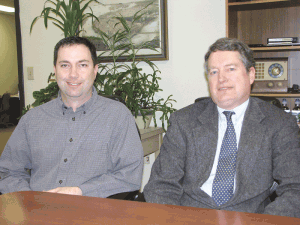
Peter DeMallie (right, with Ben Wheeler) says factors like ADA compliance and ecological concerns have made landscape architecture more complex over the years.
“Landscape architecture is not just selecting plant species and outlining them on a map of the property,” said DeMallie, president of Design Professionals Inc. “That’s a very small component of what landscape architects do.”
Rather, the projects his company tackles tend to be much larger in scale, with significant elements of civil engineering, site planning, and land surveying, some of the other specialties of this South Windsor, Conn.-based firm.
“The crux of our landscape-architecure business supports our other disciplines, our civil-engineering and land-surveying business, and most of that work is for commercial and industrial clients,” said Benjamin Wheeler, a landscape architect and director of Operations for the company.
Design Professionals, which celebrated 25 years in business last year, has worked on more than 2,500 projects in more than 120 communities in Connecticut, Massachusetts, and Rhode Island, encompassing residential, retail, office, and industrial sites, as well as schools, churches, parks and sports fields, and municipal facilities.
“We average 100 new projects a year, and that’s over all disciplines,” DeMallie said. “Not all those have a landscape-architecture component, but a large number of them do.
“We aren’t the type of firm that goes into somebody’s backyard,” he added, before correcting himself somewhat and detailing some relatively larger-scale residential jobs. “They’re primarily high-end residences looking for professional designs in and around the pool, associated landscaping, waterfalls … we can do that, but typically for the higher-end market.”
In fact, residential work used to be a larger portion of the business, before the housing market collapsed in 2008 and launched the Great Recession.
“The demand for services dropped off appreciably during the recession, and even after the official recession end. The economic impact to our business, to the design marketplace, was heavily impacted,” DeMallie said.
Many anticipated projects were backlogged, he explained, and residential work in particular suffered; “as for single-family subdivisions, we have worked on one in the last three years. Forty percent of our business used to be residential; now it’s probably under 20%.”
Still, Design Professionals has stayed busy with projects ranging from a Fedex Ground distribution center in South Windsor to the design of the Farmington Sports Arena, which features a mix both natural- and artificial-surface fields.
DeMallie and Wheeler recently sat down with BusinessWest to talk about how the company has grown over the past quarter-century, and particularly how the business of landscape architecture has changed over that time. It’s a complicated field, to be sure, even though the outcome is often fun and games.
Green Acres
One current job that is strictly a landscape-architecture project involves extensive work at South Windsor High School, bringing the grounds and athletic fields up to code, including handicapped access under the Americans with Disabilities Act.
“ADA compliance is a component of every single project now, whether public or private sector, whether it’s an educational facility, police station, industrial facility, office space, you name it,” said DeMallie. “It’s one of the many challenges for every site.”
Another major shift has been the increasing prominence of ecological concerns over the past few decades, and the expanding maze of regulatory hassles that surround those issues.
“Environmentally, if you think back as late as the 1960s or even the 1970s, wetlands was not a major factor,” he noted. “But preservation of inland wetlands has grown — the recognition of those sites as important environmental assets. Wetlands on site or adjacent to the site have become a major issue. The idea is to avoid the impact of wetlands, but if it can’t be avoided, you must minimize the impacts and justify the impacts.”
“Erosion control and sedimentation control were an afterthought years ago,” he added. “Now it’s standard operating procedure.”
He laughed when he evoked the pre-1970 view of filling in a wetland as a positive thing — “you were just removing mosquitoes. It has changed a lot.”
Wheeler said “low-impact development” has become a watchword, and referred to a retail project in Easthampton, Conn. that was approved under new local parking-lot regulations. One component of those guidelines is that stormwater runoff is directed into ‘rain gardens’ rather than into underground systems. “The gardens are planted with material that’s appropriate and can tolerate both moist and dry conditions.”
The benefit, he explained, has to do with keeping runoff, which may contain anything from fertilizers to debris from the metals on cars, out of the municipal water system.
“Another trend in site design, also part of the green movement, is that you’re seeing more use of LED lighting for [outdoor] fixtures,” he explained. “The technology is those is rapidly improving, so much that I think, in a very few years, we’re going to see even more extensive use of LED lights for site lighting. We’re not quite there in all projects, but in certain situations, it does make sense.”
DeMallie noted that the costs of such amenities are coming down as well, and site owners are always looking to affect the bottom line.
“You can save a lot on energy efficiency,” Wheeler said. “You spent more on the install, but there’s a long-term return on investment.”
Breaking New Ground
The sheer range of the firm’s portfolio is impressive. “Every retail development has a landscape-architecture component,” DeMallie said. A good example is Buckland Commons in South Windsor, a two-building project in South Windsor that includes a bank, retail space, and offices.
“As a landscape architect, I worked to develop multiple concepts for the property, and after one concept was selected, we moved forward with the local approval process,” Wheeler explained. “The site design included signage, determining plant species and their proper location, also a decorative screening wall. I also helped determine the appropriate amount of lighting for the site and worked closely with soil scientists to come up with a wetland mitigation plan, because there was some direct wetland impact with that project.”
That’s a good example of the range of skill sets that go into many commercial, industrial, and municipal projects — it’s no surprise that the Landscape Architecture program at Ohio State University, where Wheeler earned his degree, is housed in the School of Engineering. “It’s a pretty diverse profession,” he said. “I’m constantly working with engineers and surveyors on projects.”
But, again, not as many residential projects as in the past. DeMallie said it’s not just the housing market that has impacted that side of the business, but inadequate long-term planning by communities, with plenty of McMansions and over-55 housing erected over the past decade or two, but not nearly enough affordable homes for young professionals.
“That’s one of the problems in the Hartford and Springfield area,” he said. “The farther you go out from Hartford and Springfield, beyond the heavily urbanized city and suburban areas, as you get into the exurban areas, there’s still land available — but most don’t have full utilities to support it.
“It’s no surprise to anyone that this region has lost some of its young workforce, and one reason is that we don’t have the housing projects to meet their desires and needs, as well as affordable mass transit. It affects our ability as an employer to attract and retain employees with the skill sets we want.”
Still, the company has navigated changes in its industry before, and will continue to do so as the impact of the recession begins to lift. After all, the landscape is always changing — and Design Professionals continues to shape it.
Joseph Bednar can be reached at [email protected]
Home & Garden Show Offers Businesses Valuable Exposure
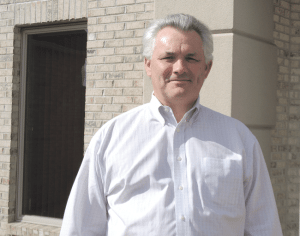
Brad Campbell says the home show is a valuable source of funds for the Home Builders & Remodelers Assoc., but more critical as a marketing tool.
“I know of one foam-insulation company that gets 60% of its business from the home show,” said Campbell, president of the Home Builders & Remodelers Assoc. of Western Mass., the organization that has been putting on the show for the past 58 years. This year’s event takes place on March 22-25, at the Eastern States Exposition.
That 60% figure isn’t an isolated example, he told BusinessWest. For some companies, the leads generated over those four days may account for up to 70% of their business for the year.
“The home show gives vendors the opportunity to market to an audience that normally wouldn’t see their name,” he explained. “They get in front of consumers for four days — more than 20,000 consumers, in fact. That, by itself, is a tremendous value.”
That exposure is, in many ways, a reflection of the goals of the association itself, Campbell noted.
“We’re an independent group made up of builders, remodelers, and what I call allied industries, industries that support builders and remodelers,” he said. “We have about 400 members, and our purpose is to represent the interests of those industries, both legislatively and by helping our members develop themselves as stronger business people. We offer education to our members to try to help them run their business more effectively and efficiently.”
The home show, he explained, started as a way to generate revenue to support the association.
“Like any trade group, we’re supported by dues from members. We try to keep dues as low as possible, and the home show has been able to be our funding mechanism to accomplish that. But that’s a minor point; the real purpose of the home show is that it gives the community the opportunity to see and touch and feel these new products we’ve developed, and incorporate them into their homes. It’s developed over the years to be a spotlight for these products and services.”
For this issue, BusinessWest sits down with Campbell to learn how the Home & Garden show continues to evolve in its 58th year, and why it continues to be that vital lifeline — or, at the very least, a springboard into a busy spring — for so many companies.
Bricks and More
The scope of the home show has definitely expanded, Campbell explained, noting that it’s no longer just a showcase for new products and construction- and landscaping-related services. Visitors can learn how to finance their projects by visiting one of a whopping 10 banks and credit unions that will set up shop at the show. Other exhibitors — more than 350 in all, in more than 90 different categories — run the gamut from inspection services to security and alarm systems; Internet and communications to moving and storage; duct cleaning to pianos and organs.
“We even have automobiles at the home show,” he added. “It’s no longer just about homes; it’s about lifestyle, how we live our lives, whether it’s improving our backyards, creating an escape from the day-to-day, or the vehicles we drive, or the sheds we put things in. Sheds have also become a big portion of the show.”
The theme of this year’s show is ‘Rebuilding Western Mass., Rebuilding Lives,’ a nod to a freak series of weather events last year that turned countless lives upside down across the region.
“A lot of consumers haven’t figured out how they’re going to do it,” Campbell said in reference to said rebuilding. “This is a place where they can talk to professionals, talk to suppliers, architects, and find a way through the maze of how to get back on their feet.”
Responding to the storms of 2011, he noted, some fields (roofing and siding, for instance) were booming from the get-go, but much of the new construction still hasn’t happened because property owners and insurance companies continue to deal with claims, so there’s plenty of opportunity on the table for companies in dozens of specialties. “A lot of people were underinsured or uninsured,” he added. “We’ve all heard horror stories. It’s been interesting.”
That brought Campbell back to one role of the Home Builders & Remodelers Assoc., and that is as a resource for consumers looking for construction services. The home show, he said, is one way to get that message across, by enhancing the group’s profile.
“That’s one thing that gets lost about our association,” he noted. “When consumers are trying to figure out which builders or remodelers to use, when they have questions, we’re possibly the best source for that information. When consumers call, we do the research. We have a referral program for our members, so when a consumer calls and wants work done on their home, we’ll find a member willing to do the work. Sometimes people think of the Yellow Pages first, but here, we’ve got the resources.”
Solar Proprietors
Those consumer questions often center around options for energy-efficient products, an increasingly noteworthy trend in building. At the home show, that’s reflected in everything from solar and geothermal products to a company like Eco Building Bargains, which specializes in repurposing discarded building supplies.
“We’re seeing more technology, more energy-efficient products,” Campbell said. “That’s what consumers are looking for. This year we have three or four solar companies, where in the past we’d have one. High-efficiency heating and cooling systems always play a big role.”
Also on the rise at the show — perhaps reflecting an improving economy — are luxury items, from pools and hot tubs to central vacuum systems and other gadgets that make home life a little easier.
Speaking of making life easier, Campbell’s organization aims to do just that for area nonprofits, many of whom are offered free booth space at the show. The Home Builders & Remodelers Assoc. has partnered in the past with the Red Cross, Shriners Hospital, Rebuild Together Springfield, the American Cancer Society, Habitat for Humanity, Harmony House, and many others. It also maintains a scholarship program for members’ children, which has doled out some $400,000 to date.
“We try to give nonprofits the opportunity to get in front of people and explain who they are and what they do; that’s an important component of community service that we’re promoting heavily,” he explained.
This year, the association is working with Homes for Our Troops to build a house in Granby for Marine Sgt. Joshua Bouchard, who lost his left leg and broke his back after his vehicle drove over an explosive device in Afghanistan in 2009.
Efforts like that, Campbell said, make it clear that “the culture of home shows is such not just about doing business. One thing I’ve found is that people actually go to these to see old friends, people they haven’t caught up with in recent years. It’s a social event as well as a consumer event.”
And if it helps to rebuild a few lives — from tornado victims to an injured Marine — then it’s a show even more worth seeing.
Joseph Bednar can be reached at [email protected]




